Transitional Words and Phrases
One of your primary goals as a writer is to present ideas in a clear and understandable way. To help readers move through your complex ideas, you want to be intentional about how you structure your paper as a whole as well as how you form the individual paragraphs that comprise it. In order to think through the challenges of presenting your ideas articulately, logically, and in ways that seem natural to your readers, check out some of these resources: Developing a Thesis Statement , Paragraphing , and Developing Strategic Transitions: Writing that Establishes Relationships and Connections Between Ideas.
While clear writing is mostly achieved through the deliberate sequencing of your ideas across your entire paper, you can guide readers through the connections you’re making by using transitional words in individual sentences. Transitional words and phrases can create powerful links between your ideas and can help your reader understand your paper’s logic.
In what follows, we’ve included a list of frequently used transitional words and phrases that can help you establish how your various ideas relate to each other. We’ve divided these words and phrases into categories based on the common kinds of relationships writers establish between ideas.
Two recommendations: Use these transitions strategically by making sure that the word or phrase you’re choosing matches the logic of the relationship you’re emphasizing or the connection you’re making. All of these words and phrases have different meanings, nuances, and connotations, so before using a particular transitional word in your paper, be sure you understand its meaning and usage completely, and be sure that it’s the right match for your paper’s logic. Use these transitional words and phrases sparingly because if you use too many of them, your readers might feel like you are overexplaining connections that are already clear.
Categories of Transition Words and Phrases
Causation Chronology Combinations Contrast Example
Importance Location Similarity Clarification Concession
Conclusion Intensification Purpose Summary
Transitions to help establish some of the most common kinds of relationships
Causation– Connecting instigator(s) to consequence(s).
accordingly as a result and so because
consequently for that reason hence on account of
since therefore thus
Chronology– Connecting what issues in regard to when they occur.
after afterwards always at length during earlier following immediately in the meantime
later never next now once simultaneously so far sometimes
soon subsequently then this time until now when whenever while
Combinations Lists– Connecting numerous events. Part/Whole– Connecting numerous elements that make up something bigger.
additionally again also and, or, not as a result besides even more
finally first, firstly further furthermore in addition in the first place in the second place
last, lastly moreover next second, secondly, etc. too
Contrast– Connecting two things by focusing on their differences.
after all although and yet at the same time but
despite however in contrast nevertheless nonetheless notwithstanding
on the contrary on the other hand otherwise though yet
Example– Connecting a general idea to a particular instance of this idea.
as an illustration e.g., (from a Latin abbreviation for “for example”)
for example for instance specifically that is
to demonstrate to illustrate
Importance– Connecting what is critical to what is more inconsequential.
chiefly critically
foundationally most importantly
of less importance primarily
Location– Connecting elements according to where they are placed in relationship to each other.
above adjacent to below beyond
centrally here nearby neighboring on
opposite to peripherally there wherever
Similarity– Connecting to things by suggesting that they are in some way alike.
by the same token in like manner
in similar fashion here in the same way
likewise wherever
Other kinds of transitional words and phrases Clarification
i.e., (from a Latin abbreviation for “that is”) in other words
that is that is to say to clarify to explain
to put it another way to rephrase it
granted it is true
naturally of course
finally lastly
in conclusion in the end
to conclude
Intensification
in fact indeed no
of course surely to repeat
undoubtedly without doubt yes
for this purpose in order that
so that to that end
to this end
in brief in sum
in summary in short
to sum up to summarize


Improving Your Writing Style
This is an accordion element with a series of buttons that open and close related content panels.
Clear, Concise Sentences
Use the active voice
Put the action in the verb
Tidy up wordy phrases
Reduce wordy verbs
Reduce prepositional phrases
Reduce expletive constructions
Avoid using vague nouns
Avoid unneccessarily inflated words
Avoid noun strings
Connecting Ideas Through Transitions
Using Transitional Words and Phrases

Transitions
What this handout is about.
In this crazy, mixed-up world of ours, transitions glue our ideas and our essays together. This handout will introduce you to some useful transitional expressions and help you employ them effectively.
The function and importance of transitions
In both academic writing and professional writing, your goal is to convey information clearly and concisely, if not to convert the reader to your way of thinking. Transitions help you to achieve these goals by establishing logical connections between sentences, paragraphs, and sections of your papers. In other words, transitions tell readers what to do with the information you present to them. Whether single words, quick phrases, or full sentences, they function as signs that tell readers how to think about, organize, and react to old and new ideas as they read through what you have written.
Transitions signal relationships between ideas—relationships such as: “Another example coming up—stay alert!” or “Here’s an exception to my previous statement” or “Although this idea appears to be true, here’s the real story.” Basically, transitions provide the reader with directions for how to piece together your ideas into a logically coherent argument. Transitions are not just verbal decorations that embellish your paper by making it sound or read better. They are words with particular meanings that tell the reader to think and react in a particular way to your ideas. In providing the reader with these important cues, transitions help readers understand the logic of how your ideas fit together.
Signs that you might need to work on your transitions
How can you tell whether you need to work on your transitions? Here are some possible clues:
- Your instructor has written comments like “choppy,” “jumpy,” “abrupt,” “flow,” “need signposts,” or “how is this related?” on your papers.
- Your readers (instructors, friends, or classmates) tell you that they had trouble following your organization or train of thought.
- You tend to write the way you think—and your brain often jumps from one idea to another pretty quickly.
- You wrote your paper in several discrete “chunks” and then pasted them together.
- You are working on a group paper; the draft you are working on was created by pasting pieces of several people’s writing together.
Organization
Since the clarity and effectiveness of your transitions will depend greatly on how well you have organized your paper, you may want to evaluate your paper’s organization before you work on transitions. In the margins of your draft, summarize in a word or short phrase what each paragraph is about or how it fits into your analysis as a whole. This exercise should help you to see the order of and connection between your ideas more clearly.
If after doing this exercise you find that you still have difficulty linking your ideas together in a coherent fashion, your problem may not be with transitions but with organization. For help in this area (and a more thorough explanation of the “reverse outlining” technique described in the previous paragraph), please see the Writing Center’s handout on organization .
How transitions work
The organization of your written work includes two elements: (1) the order in which you have chosen to present the different parts of your discussion or argument, and (2) the relationships you construct between these parts. Transitions cannot substitute for good organization, but they can make your organization clearer and easier to follow. Take a look at the following example:
El Pais , a Latin American country, has a new democratic government after having been a dictatorship for many years. Assume that you want to argue that El Pais is not as democratic as the conventional view would have us believe.
One way to effectively organize your argument would be to present the conventional view and then to provide the reader with your critical response to this view. So, in Paragraph A you would enumerate all the reasons that someone might consider El Pais highly democratic, while in Paragraph B you would refute these points. The transition that would establish the logical connection between these two key elements of your argument would indicate to the reader that the information in paragraph B contradicts the information in paragraph A. As a result, you might organize your argument, including the transition that links paragraph A with paragraph B, in the following manner:
Paragraph A: points that support the view that El Pais’s new government is very democratic.
Transition: Despite the previous arguments, there are many reasons to think that El Pais’s new government is not as democratic as typically believed.
Paragraph B: points that contradict the view that El Pais’s new government is very democratic.
In this case, the transition words “Despite the previous arguments,” suggest that the reader should not believe paragraph A and instead should consider the writer’s reasons for viewing El Pais’s democracy as suspect.
As the example suggests, transitions can help reinforce the underlying logic of your paper’s organization by providing the reader with essential information regarding the relationship between your ideas. In this way, transitions act as the glue that binds the components of your argument or discussion into a unified, coherent, and persuasive whole.
Types of transitions
Now that you have a general idea of how to go about developing effective transitions in your writing, let us briefly discuss the types of transitions your writing will use.
The types of transitions available to you are as diverse as the circumstances in which you need to use them. A transition can be a single word, a phrase, a sentence, or an entire paragraph. In each case, it functions the same way: First, the transition either directly summarizes the content of a preceding sentence, paragraph, or section or implies such a summary (by reminding the reader of what has come before). Then, it helps the reader anticipate or comprehend the new information that you wish to present.
- Transitions between sections: Particularly in longer works, it may be necessary to include transitional paragraphs that summarize for the reader the information just covered and specify the relevance of this information to the discussion in the following section.
- Transitions between paragraphs: If you have done a good job of arranging paragraphs so that the content of one leads logically to the next, the transition will highlight a relationship that already exists by summarizing the previous paragraph and suggesting something of the content of the paragraph that follows. A transition between paragraphs can be a word or two (however, for example, similarly), a phrase, or a sentence. Transitions can be at the end of the first paragraph, at the beginning of the second paragraph, or in both places.
- Transitions within paragraphs: As with transitions between sections and paragraphs, transitions within paragraphs act as cues by helping readers to anticipate what is coming before they read it. Within paragraphs, transitions tend to be single words or short phrases.
Transitional expressions
Effectively constructing each transition often depends upon your ability to identify words or phrases that will indicate for the reader the kind of logical relationships you want to convey. The table below should make it easier for you to find these words or phrases. Whenever you have trouble finding a word, phrase, or sentence to serve as an effective transition, refer to the information in the table for assistance. Look in the left column of the table for the kind of logical relationship you are trying to express. Then look in the right column of the table for examples of words or phrases that express this logical relationship.
Keep in mind that each of these words or phrases may have a slightly different meaning. Consult a dictionary or writer’s handbook if you are unsure of the exact meaning of a word or phrase.
You may reproduce it for non-commercial use if you use the entire handout and attribute the source: The Writing Center, University of North Carolina at Chapel Hill
Make a Gift
- Features for Creative Writers
- Features for Work
- Features for Higher Education
- Features for Teachers
- Features for Non-Native Speakers
- Learn Blog Grammar Guide Community Events FAQ
- Grammar Guide

Transition Words and Phrases in English
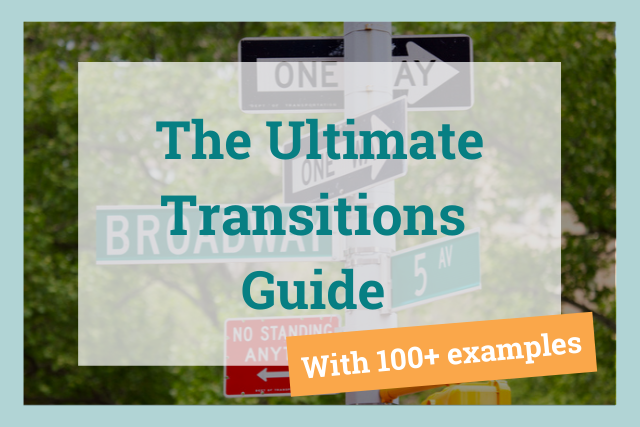
Imagine a road with no street signs to point the way. How would you follow the right route if you didn’t have a sign showing you which way to go?
Words and phrases like similarly , nevertheless , in order to , likewise , and as a result show the relationships between your ideas and can help illustrate agreement, contrast, or cause and effect.
What Are Transition Words?
Transition words are the road signs in writing. They help readers follow your train of thought without becoming bogged down trying to discern your meaning.
When used correctly, they keep up the flow of your writing as you shift in meaning, tone, and ideas from one sentence or paragraph to another. Transition words clarify the relationship between what you just said and what you're about to say for your readers.
Here’s an example of a well-placed transition:
- Original: The boy kicked the ball into the street. A speeding car came around the corner.
- Rewrite: The boy kicked the ball into the street. At the same moment, a speeding car came around the corner.
The rewrite uses a transition phrase to show when the event happened. We see the action in a wider lens: the ball goes into the street just as a car comes careening around the corner. The first illustration is short and choppy. It doesn’t flow well. The rewrite leads you smoothly between two related, but different thoughts.
The addition of at the same moment also clarifies the connection between the ideas for the reader. Since we know these events are connected and happening at the same time, we feel more tension for what's about to happen.
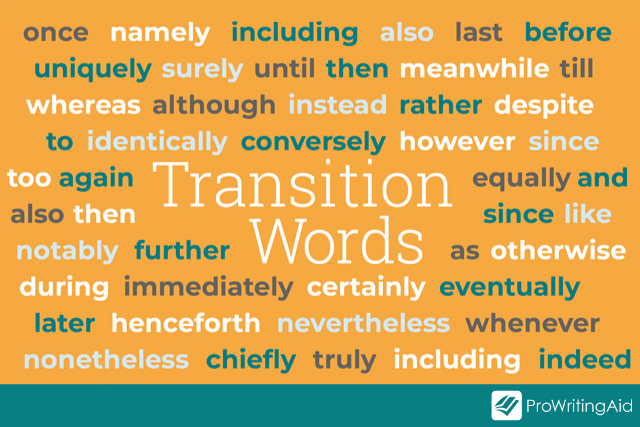
Transitional Words Examples: Fiction
Let’s take a look at some of these words in context to better examine how they work.
Fiction Transitions Example 1:
Take the following two sentences. Which one reads more fluidly?
- Mark tended to avoid the campus dining hall where his former friends hung out. He loved its food.
- Mark tended to avoid the campus dining hall where his former friends hung out, although he loved its food.
In the second construction, you understand how the two ideas are related. The first construction reads as choppy, two disparate ideas connected solely by proximity. By adding the transition word although and combining the two sentences, the second construction makes it clear that avoiding the dining hall had consequences for Mark. It gives more meaning to both sentences.
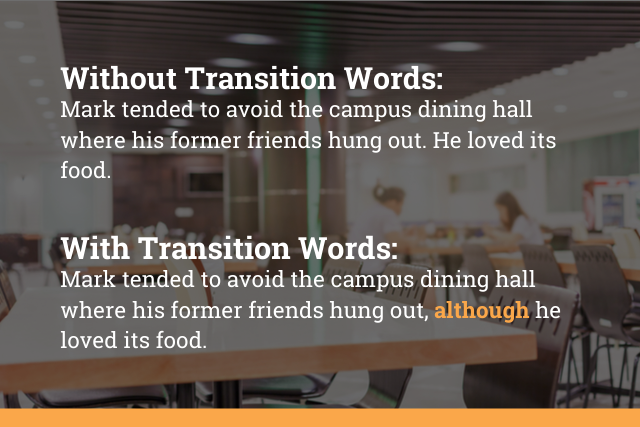
Fiction Transitions Example 2:
Here’s another example of transition word usage in fiction writing:
- Mindy thought her mother was over-reacting to her predicament. She waited two days after the first phone call to visit.
- Mindy thought her mother was over-reacting to her predicament. So, she waited two days after the first phone call to visit.
The use of so in the second construction makes clear to the reader that the gap in time between the call and the visit was a direct result of the over-reaction.
Transitional Words Examples: Non-Fiction
Transitions don’t just help fiction readers. Let’s take a look at how you can use transitions to improve your non-fiction writing.
Non-Fiction Transitions Example 1:
Take the following two constructions. Which one reads more fluidly?
- Marketing numbers have performed worse than we expected this year. We will be hiring a marketing consultant.
- Marketing numbers have performed worse than we expected this year, so we’ll be hiring a marketing consultant.
In the second construction, you understand how the two ideas are related. You see straight away that the poor marketing results are the direct reason for hiring a marketing consultant. By adding this connection, the relationship between the two ideas becomes clear. Similarly, the second version flows better and feels less self-contained.
Non-Fiction Transitions Example 2:
Here’s another example of transition word usage in non-fiction writing:
- The recent rise in oil pricing has made gas more expensive for consumers. Food prices have skyrocketed.
- The recent rise in oil pricing has made gas more expensive for consumers. Similarly, food prices have skyrocketed.
The use of similarly in the second construction makes it clear that there’s a relationship between the two ideas. The first construction feels disconnected since one sentence focuses on gas prices and another on food. The second construction makes it clear that the two ideas are related based on how they affect prices for consumers.
What Are the 6 Examples of Transitions?
What makes these phrases different from other words? They all move your writing from one idea to another.
The specific word or phrase you choose for your writing will depend on the type of transition you want to make. Each category of transition has multiple words or phrases you can choose from. Later in this article, we’ll show you hundreds of transition words or phrases to suit every need.
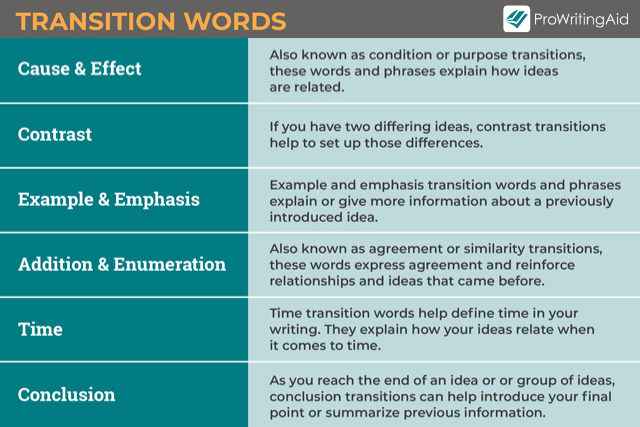
Before we get to the ultimate list of examples, let’s take a look at the categories.
Cause and effect: Show how two ideas are connected.
- I’m tired, so I’m going to bed.
Contrast: Show differences between two or more ideas.
- I hate most desserts. However, I love cookies.
Example and Emphasis: Introduce examples that help highlight or explain a previous point, or to add strength to a particular idea.
- I have a lot of fears. For instance, I’m terrified of spiders.
Addition & Enumeration: Break down, draw connections to, or add more support to an existing idea.
- Today, I’m going to do my homework. In addition, I’m going to clean my room.
Time: Explain how two or more ideas are related in time.
- Mary-Ann went out, looking for a bright new world. Meanwhile, Wanda looked all around their hometown and all she found was Earl.
Conclusion: Introduce a final point or summarize information.
- In conclusion, I deserve a new car because I’ve done all my chores for the month.
How ProWritingAid Can Help You with Transition Words
Clear, readable writing tends to use around 25% transition phrases. Of course this isn't set in stone—but if you have considerably fewer than this in your document, you may be losing your reader.
ProWritingAid's Transitions Report highlights all of the transition words in your document so you can see how your writing flows. Here's how it works:
Try out ProWritingAid's Transitions Report with a free account.
What Are Some Examples of Transition Words?
Looking for examples of transition words you can use in your writing? Look no further! We’ve put together the ultimate list with hundreds of examples you can use.
On to the list!
Cause and Effect Transition Phrases
Also known as condition or purpose transitions, these words and phrases explain how ideas are related.
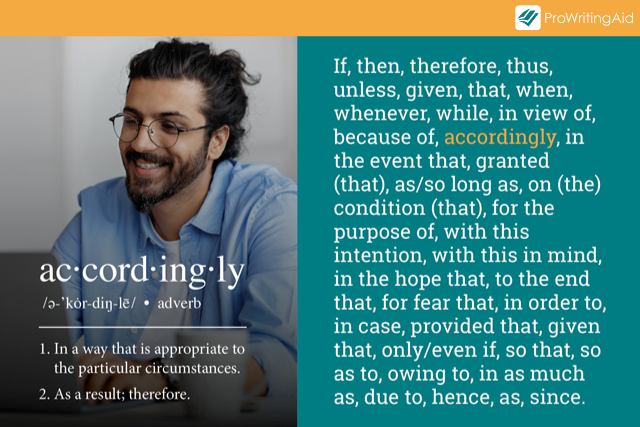
Contrast Transition Words
If you have two differing ideas, contrast transitions help to set up those differences.
Example and Emphasis Transition Words
Example and emphasis transition words and phrases explain or give more information about a previously introduced idea. Sometimes known as clarification transitions, these words help make your meaning more clear.
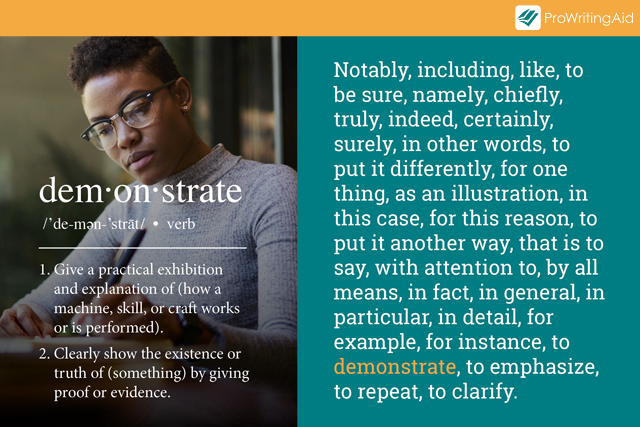
Addition and Enumeration Transition Words
Also known as agreement or similarity transitions, these words express agreement and reinforce relationships and ideas that came before.
Time Transition Words
Time transition words help define time in your writing. They explain how your ideas relate when it comes to time.
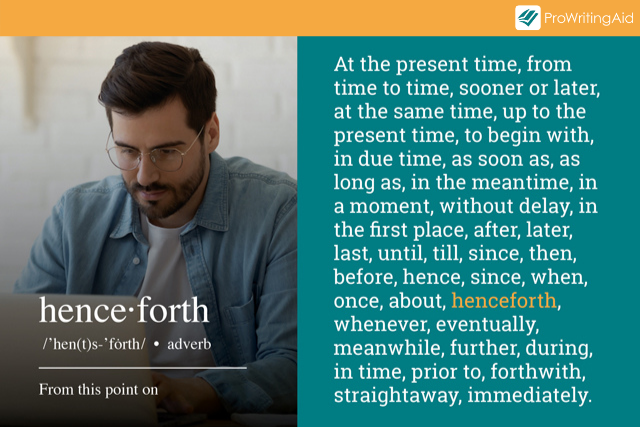
Conclusion Transitions
As you reach the end of an idea or or group of ideas, conclusion transitions can help introduce your final point or summarize previous information.
How to Use Transition Words More Effectively
Using transition words and phrases isn’t always as easy as it looks. Here are some best practices to keep in mind so that you can effectively use transition words.
1. Understand the relationship between your ideas
The better you understand the relationships between the ideas in your text, the more effectively you’ll be able to wield transition words and phrases. The relationships between your ideas will help you understand which you should pick.
2. Know your transition words
Different transitions are appropriate in different contexts. Don’t just pick a random transition to use. Make sure the one you’ve chosen is appropriate for what you’re trying to say. Also, don’t be afraid to try out a new transition word from the list we’ve provided above. Just like in other types of writing, repetitive language can be boring for your readers. Try out new transition words (as long as they’re the right type) to increase the interest of your writing.
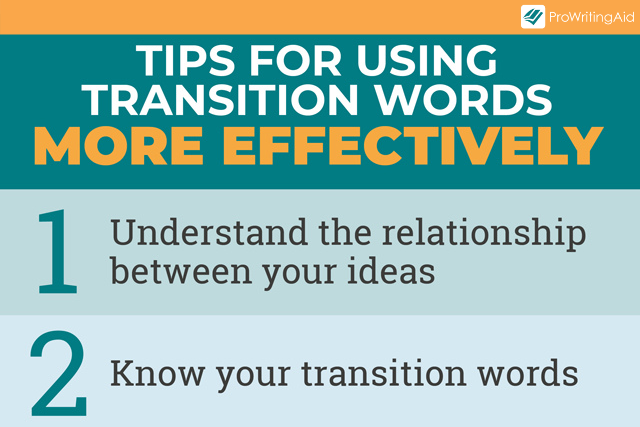
How ProWritingAid Helps You Improve Transition Words and Phrases in Your Writing
Since transitions help to organize your ideas and demonstrate connections, it’s important to include them in your writing to make it more clear. ProWritingAid can help. Our software analyzes your writing to determine whether or not you’ve used transitions appropriately in your work.
Depending on what you’re writing, you can find your Transitions score in two places: your goals and the Transition Report.
ProWritingAid knows that different genres require different amounts and types of transitions, so your suggested transition percentage changes depending on what you’re writing. If you’re working on an academic paper, for instance, transitional phrases are important to improving understanding. So you’ll find a goal for transitions in your sidebar.
On the other hand, formal transitions are less common in some types of fiction writing, so you may not see this goal if you’re working on say, a crime novel.
You can always find your score, regardless of what you’re writing, by running the Transition Report. The ProWritingAid Transition Report will scan your writing and give you a “transitions score." This measures the percentage of your sentences that begin with a transition word.
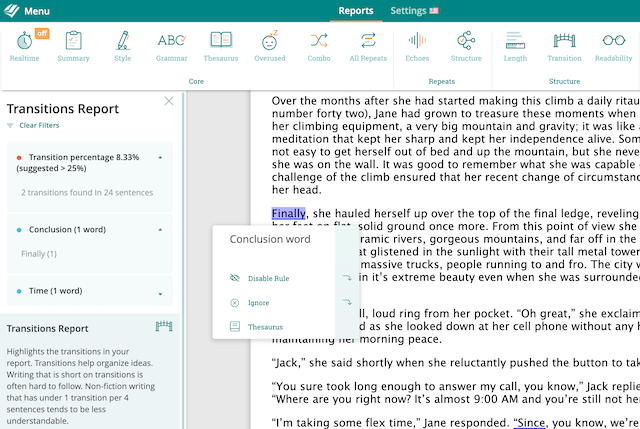
Check your transitions with a free ProWritingAid account.
Transitions: The Links Between Ideas
To conclude, great transitions lead to more sophisticated structure. (See what we did there with that transition?!)
Adding transitions to your writing creates clear connections for your readers. By adding transitions, you’ll help your readers better understand what you’re trying to say.
Happy writing!
Common Questions about Transition Words and Phrases in English
Transition usage, learn more about grammar:.
Drop us a line or let's stay in touch via :
Understanding Transition Sentences (For Essays and Writing with Examples)

What are transition sentences? And how do they work? Is there a correct way to use them? And an incorrect way? Understanding transition sentences is critical when writing essays, articles, or any type of logical flow.
Learn what transitional sentences are in this short guide…
What are transition sentences?
When you write an article, essay (or anything), you’ll want to write it in a logical sequence. You start with an introduction, highlight your points, and then end with a conclusion. Throughout your writing, you would be using sentences to express your thought. To make your writing effective, you need to link the sentences together in a logical way .
This is where transition sentences can be helpful.
As the name suggests, a transition sentence links the thoughts you are expressing in your writing. They make use of words and phrases that act as a bridge between different parts of your writing.
Transition sentences allow your reader to move smoothly from one section to another. Without transition sentences, your reader might not be able to understand the link between different parts of your writing.
What makes a good transition sentence?
Look at this example:
The CEO was very clear that productivity and efficiency were the two key things he would focus on. However , the legacy systems followed by the company acted as a detriment. Tech modernization was the solution that would enhance productivity and efficiency.
Sentences one and three make sense by themselves. But it is important to establish a relationship between the two. This is what the second sentence does . It acts as a bridge (or transition) between the first and third sentences. By doing so, it helps the writer communicate their ideas more effectively.
A good transition sentence would bring clarity by linking ideas expressed in the sentences before and after it. Words and phrases like ‘however,’ ‘in contrast,’ ‘for instance,’ ‘in fact,’ and ‘therefore’ can get used to help make the transition.
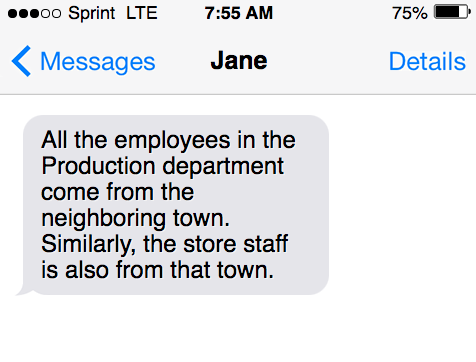
Many transition words are available to use. Choose the appropriate word for the situation.
For example, if you want to show the sequence between two sentences, you can use a word like ‘then’ or ‘after.’ If you want to emphasize a point through the transition, you can use ‘indeed,’ ‘especially,’ or ‘particularly.’
Transition words can be used at the start of the sentence ( e.g. , Surely , you are not going to go now!). It can also be used within the sentence (e.g., I rejected the job offer because the salary was lesser than my present pay ).
Here are a few tips that will help you use transition words correctly:
- When sentences within a paragraph sound abrupt or awkward, you need to use transition words to link them.
- Choose the correct transition word that is appropriate to the situation. A wrong selection can make your reader confused.
- When moving from one idea to another, use a transition word to let the reader know.
- Don’t make the mistake of overusing transition words. Too many transition words can end up making your writing look messy.
List of words for transition sentences
Some common words used in transition sentences are:
- Furthermore
- Nevertheless
- Specifically
List of phrases for transition sentences
Transition sentences would use both words and phrases as the bridge. A few phrases that are used include:
- In other words
- On the contrary
- As a result
- In the long run
- As you can see
- In the following
- In the previous
- Having established
- Most importantly
- For example/instance
- By the time
5 Examples of Transitions (Types of Transitions)
Conjunctive adverbs can be used to establish the logical link between ideas. They can be classified under five heads. It must be noted some words appear in multiple categories.
Of addition
- Additionally
- In addition
- In the same way
The following example will make this clear.
First , put a pan on the stove and heat it. Next , add oil to the pan.
In the above, first and next act as the transition and are adding on to what is being said previously.

Of contrast
These words establish a contrast or difference while making the transition.
- In contrast
- Even though
- At any rate
- In spite of that
- On the other hand
The island was not the paradise we were hoping for. On the contrary , it was dirty, noisy, and had unmanageable traffic.
The above example brings out a contrast between expectations and reality.
Of comparison
- By comparison
- In the same manner
Jonathan is crazy about chess. His daughter is similarly a big fan of the board game.
In this example, the word similarly shows a comparison between father and daughter. You may note the transition word need not be at the start of the sentence. It can be placed anywhere.
These transition words are indicative of a result. It shows the result of the previous sentence/idea.
- Consequently
Their star player was suffering from a hamstring injury and could not play. Hence , their team faced a humiliating defeat on match day.
The star player’s absence resulted in the team’s defeat. The transition word ‘Hence’ in the example is the bridge between the cause/event and the result.

Some transition words show relationships in time. They include:
- Simultaneously
- Subsequently
The speaker will be a bit late for the talk. Meanwhile , let’s ask the participants to share their views on the program .
As the speaker will be late, there is time left. So, the participants are asked to share their views and opinions. In this example, ‘Meanwhile’ is a transition word that shows relationship to time.
Subordinating conjunctions and transition sentences
You can use a subordinating conjunction in a sentence to join a dependent clause to an independent clause .
Example: When the postman came, my dog greeted him with a volley of barks.
In this example, the word ‘when’ is the subordinating conjunction that joins ‘the postman came’ and ‘my dog greeted him …’
The subordinating conjunction serves a special purpose here. It acts as a transition between two ideas. The use of the coordinating conjunction provides a logical flow.
Example: He is smarter than you are.
In this example, “than” is the subordinating conjunction that connects ‘He is smarter’ and ‘you are.’ It provides the bridge or transition between the two clauses .
Let’s look at another example to understand this. There are two clauses – ‘The spring arrives’ and ‘my hay fever gets aggravated. A subordinating conjunction can link the two. We can use ‘As’ here. So, the sentence would now read – ‘ As the spring arrives, my hay fever gets aggravated.’
Correlative conjunctions and transition sentences
The correlative conjunction shows a correlation between two words or phrases within a sentence. They play a key role in transition sentences. The use of a correlative conjunction ensures a smooth flow between two sentences or ideas.
Example: My boss totally ignored my work. Neither my hard work nor my punctuality impressed him. So, I decided to move on and look for a new job.
In the above example, sentences one and three are independent and convey the meaning clearly. However, the second sentence acts as a transition explaining why sentence one leads to sentence two.
In the second sentence, we see the use of neither … nor. This combination of words acts as correlative conjunctions in this example.
Some other words that work as correlative conjunctions are:
- Either … or
- Neither … nor
- Whether … or
- Not only … Also
Whether you want to have dinner or prefer to skip it is entirely left to you.
The above example uses Whether … or as correlative conjunctions in the sentence.
Examples of transition sentences
Examples of transition sentences:
Communicate similarities
To communicate similarities, you can use transitional words like:
Examples of sentences where the transition word communicates similarities:
- He decided to join the army just as his brother had done five years back.
- You can fly this plane the same way you flew the trainer jet; there is no real difference.
- All the employees in the Production department come from the neighboring town . Similarly , the store staff is also from that town.
Express emphasis
Words like ‘especially,’ ‘above all,’ ‘particularly’, ‘indeed,’ in fact,’ and ‘in particular’ can be used to express emphasis. When used in transition sentences, they emphasize the idea express previously.
- She was overweight. In fact , it won’t be wrong to say she was grossly obese.
- I liked the blue dress in particular .
- Indeed , it won’t be wrong to say that her arrogance led to the engagement’s breakup.
- There is a lot of focus on improving public services, especially education.
Cause and effect
Transition sentences can be very helpful in showing cause and effect or result. The following words can be used for this:
- Accordingly
- At that time
- They spent the entire semester binge-watching shows. Consequently , they failed to obtain pass marks on any of the papers.
- There are just ten items left in stock. Hence , it would be better if we suspend taking new orders at present.
- The tests revealed that his blood pressure and cholesterol levels were very high. As a result , the doctor decided that he had to increase the dosage of his medicines.
Position or place can be indicated through the use of transition words like:
- At the back
Here are some example sentences:
- Walk towards the bookshelf. Adjacent to the shelf is a table, that’s where you will find the money.
- The house was located a few yards from the river. Next to the house was the scary-looking tree.
- You will see the building with the red flag. The storeroom is at the back of this building.
Describe a sequence
Transition words are perfect to use while describing a sequence. The words that can be used are:
- Followed by
- First , write down all the numbers in the form of a list. Next , add all the numbers. Finally , write down the total.
- Initially , three employees were working on the project. Subsequently , the project grew the numbers rise to twenty.
- The private plane owned by the CEO was the first to land. This was followed by the helicopter containing the crew.
To show examples
Transition words can be used to show examples or illustrate a particular point. Some words to use are:
- For example
- For instance
- Illustrated by
- As an example
- In this case
- On this occasion
- To illustrate
- To demonstrate
- The speaker displayed the blueprint of the equipment on the screen. To illustrat e its working, he showed a video.
- There are seven tools you can use to solve this problem. As an example , I will talk about the fishbone diagram.
- Different essential oils can help you feel relaxed. For instance , using lavender oil makes you feel refreshed and rejuvenated.
How to use transition sentences between paragraphs
Transition sentences can get used within a paragraph. It also can get used between paragraphs.
This is important since the transition sentence provides a flow between paragraphs . It allows the readers to understand the relationship between the ideas expressed in those two different paragraphs.
When you start writing a paragraph , show a link to the previous paragraph in the first sentence. This establishes a bridge between both paragraphs.
Here’s an example:
There is no doubt that the effects of pollution by industries. This is why activists call for a ban on industries to stop pollution.
Despite the previous argument , we must also think about the economy. Banning industries will bring the economy to a standstill.
This example, ‘despite the previous argument’ is used to transition between the two paragraphs.
In contrast, the first part calls for a ban on industries, and the second discusses the economic effect. Using a transition allows for a smooth flow between the two.
Examples of transition sentences for essays
The use of transitions is very important in essays. An essay is written to convey an idea, opinion, or viewpoint. To ensure its effectiveness, transition sentences are needed at different parts of the essay. Transition sentences are needed between sentences, between sections, and at the conclusion of the essay.
A few examples of this:
- Having established that a large majority of students have internet access, we can conclude t hat e-learning is a distinct possibility.
- All the employees have a smartphone. In fact , most of them connect to the company’s Wi-Fi using their phone.
Examples of transition words for concluding sentences
Transition sentences are used throughout a write-up. It is imperative that the conclusion also has a transition. Your write-up needs to end with a summary of what you are trying to say. Or with a call-to-action. Using transition words in the conclusion can help you achieve this.
A few transition words you can consider using are:
- In conclusion
- As shown above
- On the whole
- Generally speaking
- To summarize
- To summarize , sustained use of this medicine offers significant benefits to patients.
- In summary, democracy has many limitations but no other acceptable alternative.
- Ultimately , it all boils down to the decision taken by the customer.
- In short , the best option available is to get funds from a new investor.
Sentence structure
More on sentence structure:
- Dangling modifier
- Transition sentences
- Active voice
- Passive voice
- Adverbial clause
- Parallelism
- Transition Sentences Tips and Examples for Clear Writing
- Transitional devices
- How to Use Transition Sentences for Smoother Writing
- Transition Words: Examples in Sentences, Paragraphs & Essays
Inside this article
Fact checked: Content is rigorously reviewed by a team of qualified and experienced fact checkers. Fact checkers review articles for factual accuracy, relevance, and timeliness. Learn more.

About the author
Dalia Y.: Dalia is an English Major and linguistics expert with an additional degree in Psychology. Dalia has featured articles on Forbes, Inc, Fast Company, Grammarly, and many more. She covers English, ESL, and all things grammar on GrammarBrain.
Core lessons
- Abstract Noun
- Accusative Case
- Active Sentence
- Alliteration
- Adjective Clause
- Adjective Phrase
- Adverbial Clause
- Appositive Phrase
- Body Paragraph
- Compound Adjective
- Complex Sentence
- Compound Words
- Compound Predicate
- Common Noun
- Comparative Adjective
- Comparative and Superlative
- Compound Noun
- Compound Subject
- Compound Sentence
- Copular Verb
- Collective Noun
- Colloquialism
- Conciseness
- Conditional
- Concrete Noun
- Conjunction
- Conjugation
- Conditional Sentence
- Comma Splice
- Correlative Conjunction
- Coordinating Conjunction
- Coordinate Adjective
- Cumulative Adjective
- Dative Case
- Declarative Statement
- Direct Object Pronoun
- Direct Object
- Dangling Modifier
- Demonstrative Pronoun
- Demonstrative Adjective
- Direct Characterization
- Definite Article
- Doublespeak
- Equivocation Fallacy
- Future Perfect Progressive
- Future Simple
- Future Perfect Continuous
- Future Perfect
- First Conditional
- Gerund Phrase
- Genitive Case
- Helping Verb
- Irregular Adjective
- Irregular Verb
- Imperative Sentence
- Indefinite Article
- Intransitive Verb
- Introductory Phrase
- Indefinite Pronoun
- Indirect Characterization
- Interrogative Sentence
- Intensive Pronoun
- Inanimate Object
- Indefinite Tense
- Infinitive Phrase
- Interjection
- Intensifier
- Indicative Mood
- Juxtaposition
- Linking Verb
- Misplaced Modifier
- Nominative Case
- Noun Adjective
- Object Pronoun
- Object Complement
- Order of Adjectives
- Prepositional Phrase
- Past Simple Tense
- Past Continuous Tense
- Past Perfect Tense
- Past Progressive Tense
- Present Simple Tense
- Present Perfect Tense
- Personal Pronoun
- Personification
- Persuasive Writing
- Parallel Structure
- Phrasal Verb
- Predicate Adjective
- Predicate Nominative
- Phonetic Language
- Plural Noun
- Punctuation
- Punctuation Marks
- Preposition
- Preposition of Place
- Parts of Speech
- Possessive Adjective
- Possessive Determiner
- Possessive Case
- Possessive Noun
- Proper Adjective
- Proper Noun
- Present Participle
- Quotation Marks
- Relative Pronoun
- Reflexive Pronoun
- Reciprocal Pronoun
- Subordinating Conjunction
- Simple Future Tense
- Stative Verb
- Subjunctive
- Subject Complement
- Subject of a Sentence
- Sentence Variety
- Second Conditional
- Superlative Adjective
- Slash Symbol
- Topic Sentence
- Types of Nouns
- Types of Sentences
- Uncountable Noun
- Vowels and Consonants
Popular lessons

Stay awhile. Your weekly dose of grammar and English fun.

The world's best online resource for learning English. Understand words, phrases, slang terms, and all other variations of the English language.
- Abbreviations
- Editorial Policy
Writing Studio
Common transition words and phrases.
In an effort to make our handouts more accessible, we have begun converting our PDF handouts to web pages. Download this page as a PDF: Transitions Return to Writing Studio Handouts
Transitions clarify the logic of your argument by orienting your reader as you develop ideas between sentences and paragraphs. These tools should alert readers to shifts in your argument while and also maintain the smoothness and clarity of your prose. Below, you’ll find some of the most commonly used transition categories and examples of each. Depending on the example, these suggestions may be within sentences or at the beginning of sentences.
Transitions by Category
1. addition.
Use when presenting multiple ideas that flow in the same direction, under the same heading/ idea also, another, finally, first, first of all, for one thing, furthermore, in addition, last of all, likewise, moreover, next, and, second, the third reason
2. Sequence/ Order
Use to suggest a temporal relationship between ideas; places evidence in sequence first, second (etc.), next, last, finally, first of all, concurrently, immediately, prior to, then, at that time, at this point, previously, subsequently, and then, at this time, thereafter, previously, soon, before, after, followed by, after that, next, before, after, meanwhile, formerly, finally, during
3. Contrast
Use to demonstrate differences between ideas or change in argument direction but, however, in contrast, on the other hand, on the contrary, yet, differ, difference, balanced against, differing from, variation, still, on the contrary, unlike, conversely, otherwise, on the other hand, however
4. Exception
Use to introduce an opposing idea however, whereas, on the other hand, while, instead, in spite of, yet, despite, still, nevertheless, even though, in contrast, but, but one could also say…
5. Comparison
Use to demonstrate similarities between ideas that may not be under the same subject heading or within the same paragraph like, likewise, just, in a different way / sense, whereas, like, equally, in like manner, by comparison, similar to, in the same way, alike, similarity, similarly, just as, as in a similar fashion, conversely
6. Illustration
Use to develop or clarify an idea, to introduce examples, or to show that the second idea is subordinate to the first for example, to illustrate, on this occasion, this can be seen, in this case, specifically, once, to illustrate, when/where, for instance, such as, to demonstrate, take the case of, in this case
7. Location
Use to show spatial relations next to, above, below, beneath, left, right, behind, in front, on top, within
8. Cause and Effect
Use to show that one idea causes, or results from, the idea that follows or precedes it because, therefore, so that, cause, reason, effect, thus, consequently, since, as a result, if…then, result in
9. Emphasis
Use to suggest that an idea is particularly important to your argument important to note, most of all, a significant factor, a primary concern, a key feature, remember that, pay particular attention to, a central issue, the most substantial issue, the main value, a major event, the chief factor, a distinctive quality, especially valuable, the chief outcome, a vital force, especially relevant, most noteworthy, the principal item, above all, should be noted
10. Summary or Conclusion
Use to signal that what follows is summarizing or concluding the previous ideas; in humanities papers, use these phrases sparingly. to summarize, in short, in brief, in sum, in summary, to sum up, in conclusion, to conclude, finally
Some material adapted from Cal Poly Pomona College Reading Skills Program and “ Power Tools for Technical Communication .”
Writing Effective Sentence Transitions (Advanced)
Transitions are the rhetorical tools that clarify the logic of your argument by orienting your reader as you develop ideas between sentences and paragraphs. The ability to integrate sentence transitions into your prose, rather than simply throwing in overt transition signals like “in addition,” indicates your mastery of the material. (Note: The visibility of transitions may vary by discipline; consult with your professor to get a better sense of discipline or assignment specific expectations.)
Transition Signals
Transition signals are words or phrases that indicate the logic connecting sets of information or ideas. Signals like therefore, on the other hand, for example, because, then, and afterwards can be good transition tools at the sentence and paragraph level. When using these signals, be conscious of the real meaning of these terms; they should reflect the actual relationship between ideas.
Review Words
Review words are transition tools that link groups of sentences or whole paragraphs. They condense preceding discussion into a brief word or phrase. For example: You’ve just completed a detailed discussion about the greenhouse effect. To transition to the next topic, you could use review words like “this heat-trapping process” to refer back to the green house effect discussion. The relative ability to determine a cogent set of review words might signal your own understanding of your work; think of review words as super-short summaries of key ideas.
Preview words
Preview words condense an upcoming discussion into a brief word or phrase. For example: You’ve just explained how heat is trapped in the earth’s atmosphere. Transitioning to the theory that humans are adding to that effect, you could use preview words like “sources of additional CO2 in the atmosphere include” to point forward to that discussion.
Transition Sentences
The strongest and most sophisticated tools, transition sentences indicate the connection between the preceding and upcoming pieces of your argument. They often contain one or more of the above transition tools. For example: You’ve just discussed how much CO2 humans have added to the atmosphere. You need to transition to a discussion of the effects. A strong set of transition sentences between the two sections might sound like this:
“These large amounts of CO2 added to the atmosphere may lead to a number of disastrous consequences for residents of planet earth. The rise in global temperature that accompanies the extra CO2 can yield effects as varied as glacial melting and species extinction.”
In the first sentence, the review words are “These large amounts of CO2 added to the atmosphere”; the preview words are “number of disastrous consequences”; the transition signals are “may lead to.” The topic sentence of the next paragraph indicates the specific “disastrous consequences” you will discuss.
If you don’t see a way to write a logical, effective transition between sentences, ideas or paragraphs, this might indicate organizational problems in your essay; you might consider revising your work.
Some material adapted from Cal Poly Pomona College Reading Skills Program and “ Power Tools for Technical Communication .”
Last revised: 07/2008 | Adapted for web delivery: 05/2021
In order to access certain content on this page, you may need to download Adobe Acrobat Reader or an equivalent PDF viewer software.
33 Transition Words and Phrases
Transitional terms give writers the opportunity to prepare readers for a new idea, connecting the previous sentence to the next one.
Many transitional words are nearly synonymous: words that broadly indicate that “this follows logically from the preceding” include accordingly, therefore, and consequently . Words that mean “in addition to” include moreover, besides, and further . Words that mean “contrary to what was just stated” include however, nevertheless , and nonetheless .
as a result : THEREFORE : CONSEQUENTLY
The executive’s flight was delayed and they accordingly arrived late.
in or by way of addition : FURTHERMORE
The mountain has many marked hiking trails; additionally, there are several unmarked trails that lead to the summit.
at a later or succeeding time : SUBSEQUENTLY, THEREAFTER
Afterward, she got a promotion.
even though : ALTHOUGH
She appeared as a guest star on the show, albeit briefly.
in spite of the fact that : even though —used when making a statement that differs from or contrasts with a statement you have just made
They are good friends, although they don't see each other very often.
in addition to what has been said : MOREOVER, FURTHERMORE
I can't go, and besides, I wouldn't go if I could.
as a result : in view of the foregoing : ACCORDINGLY
The words are often confused and are consequently misused.
in a contrasting or opposite way —used to introduce a statement that contrasts with a previous statement or presents a differing interpretation or possibility
Large objects appear to be closer. Conversely, small objects seem farther away.
used to introduce a statement that is somehow different from what has just been said
These problems are not as bad as they were. Even so, there is much more work to be done.
used as a stronger way to say "though" or "although"
I'm planning to go even though it may rain.
in addition : MOREOVER
I had some money to invest, and, further, I realized that the risk was small.
in addition to what precedes : BESIDES —used to introduce a statement that supports or adds to a previous statement
These findings seem plausible. Furthermore, several studies have confirmed them.
because of a preceding fact or premise : for this reason : THEREFORE
He was a newcomer and hence had no close friends here.
from this point on : starting now
She announced that henceforth she would be running the company.
in spite of that : on the other hand —used when you are saying something that is different from or contrasts with a previous statement
I'd like to go; however, I'd better not.
as something more : BESIDES —used for adding information to a statement
The city has the largest population in the country and in addition is a major shipping port.
all things considered : as a matter of fact —used when making a statement that adds to or strengthens a previous statement
He likes to have things his own way; indeed, he can be very stubborn.
for fear that —often used after an expression denoting fear or apprehension
He was concerned lest anyone think that he was guilty.
in addition : ALSO —often used to introduce a statement that adds to and is related to a previous statement
She is an acclaimed painter who is likewise a sculptor.
at or during the same time : in the meantime
You can set the table. Meanwhile, I'll start making dinner.
BESIDES, FURTHER : in addition to what has been said —used to introduce a statement that supports or adds to a previous statement
It probably wouldn't work. Moreover, it would be very expensive to try it.
in spite of that : HOWEVER
It was a predictable, but nevertheless funny, story.
in spite of what has just been said : NEVERTHELESS
The hike was difficult, but fun nonetheless.
without being prevented by (something) : despite—used to say that something happens or is true even though there is something that might prevent it from happening or being true
Notwithstanding their youth and inexperience, the team won the championship.
if not : or else
Finish your dinner. Otherwise, you won't get any dessert.
more correctly speaking —used to introduce a statement that corrects what you have just said
We can take the car, or rather, the van.
in spite of that —used to say that something happens or is true even though there is something that might prevent it from happening or being true
I tried again and still I failed.
by that : by that means
He signed the contract, thereby forfeiting his right to the property.
for that reason : because of that
This tablet is thin and light and therefore very convenient to carry around.
immediately after that
The committee reviewed the documents and thereupon decided to accept the proposal.
because of this or that : HENCE, CONSEQUENTLY
This detergent is highly concentrated and thus you will need to dilute it.
while on the contrary —used to make a statement that describes how two people, groups, etc., are different
Some of these species have flourished, whereas others have struggled.
NEVERTHELESS, HOWEVER —used to introduce a statement that adds something to a previous statement and usually contrasts with it in some way
It was pouring rain out, yet his clothes didn’t seem very wet.
Word of the Day
See Definitions and Examples »
Get Word of the Day daily email!
Games & Quizzes

Usage Notes
Prepositions, ending a sentence with, hypercorrections: are you making these 6 common mistakes, a comprehensive guide to forming compounds, can ‘criteria’ ever be singular, singular nonbinary ‘they’: is it ‘they are’ or ‘they is’, grammar & usage, more words you always have to look up, 'fewer' and 'less', 7 pairs of commonly confused words, more commonly misspelled words, commonly misspelled words, great big list of beautiful and useless words, vol. 4, 9 other words for beautiful, why jaywalking is called jaywalking, the words of the week - may 31, pilfer: how to play and win.
Essay Writing Guide
Transition Words For Essays
Last updated on: Dec 19, 2023
220 Best Transition Words for Essays
By: Nova A.
15 min read
Reviewed By: Jacklyn H.
Published on: Jul 9, 2019

Writing essays can be hard, and making sure your transitions are smooth is even harder.
You've probably heard that good essays need good transitions, but what are they? How do you use them in your writing? Also, your essays are assessed according to particular criteria and it is your responsibility to ensure that it is being met.
But don't worry, we are here to help. This blog will give you transition words for essays, including how to choose the right ones and where to place them for maximum impact. Essay writing is a technical process that requires much more effort than simply pouring your thoughts on paper.
If you are new to the concept of transition words and phrases, deep dive into this article in order to find out the secret to improving your essays.

On this Page
What Are Transition Words
Transition words are essential elements in essay writing that create smooth transitions between ideas.
Think of a transition as a conjunction or a joining word. It helps create strong relationships between ideas, paragraphs, or sentences and assists the readers to understand the word phrases and sentences easily.
As writers, our goal is to communicate our thoughts and ideas in the most clear and logical manner. Especially when presenting complex ideas, we must ensure that they are being conveyed in the most understandable way.
To ensure that your paper is easy to understand, you can work on the sequencing of ideas. Break down your ideas into different sentences and paragraphs then use a transition word or phrase to guide them through these ideas.
Why Should You Use Transitions
The purpose of transition words goes beyond just connectivity. They create a cohesive narrative , allowing your ideas to flow seamlessly from one point to another. These words and phrases act as signposts and indicate relationships.
These relations could include:
- Cause and Effect
- Comparison and Contrast
- Addition and Emphasis
- Sequence and Order
- Illustration and Example
- Concession and Contradiction
- Summary and Conclusion
They form a bridge and tie sentences together, creating a logical connection. In addition to tying the entire paper together, they help demonstrate the writer’s agreement, disagreement, conclusion, or contrast.
However, keep in mind that just using or including transitional words isn’t enough to highlight relationships between ideas. The content of your paragraphs must support the relationship as well. So, you should avoid overusing them in a paper.

Paper Due? Why Suffer? That's our Job!
Types of Transitions
Transitions in essays can be classified into different types based on the relationships they indicate between ideas. Each type serves a specific purpose in guiding readers through your arguments.
Let's explore some common types of transitions and their examples:
Additive Transitions
These transitions are used to add information or ideas. They help you expand on your points or provide additional supporting evidence. Examples:
- In addition
- Furthermore
- Additionally
- Not only... but also
- Coupled with
Adversative Transitions
Adversative transitions show contrast or contradiction between ideas. They are used to present opposing viewpoints or highlight differences. Examples:
- Nevertheless
- On the other hand
- In contrast
Causal Transitions
Causal transitions explain cause-and-effect relationships. They help you establish the reasons behind certain outcomes or actions. Examples:
- As a result
- Consequently
- Resulting in
- For this reason
Sequential Transitions
Sequential transitions indicate the order or sequence of events or ideas. They help you present your thoughts in a logical and organized manner. Examples:
- Subsequently
- In the meantime
- Simultaneously
Comparative Transitions
Comparative transitions highlight similarities or comparisons between ideas. They help you draw connections and illustrate relationships. Here are some transition words for essays examples:
- In the same way
- Compared to
- In comparison
- Correspondingly
- By the same token
- Equally important
- Analogous to
Getting started on your essay? Check out this insightful read on essay writing to make sure you ace it!
List of Good Transition Words for Essays
As mentioned above, there are different categories of transitions that serve a unique purpose. Understanding these different types will help you pick the most suitable word or phrase to communicate your message.
Here we have categorized the best transition words for essays so you can use them appropriately!
Transition Words for Argumentative Essays
In argumentative essays , the effective use of transition words is essential for presenting a well-structured and coherent argument.
Transition Words for Compare and Contrast Essays
In compare and contrast essays , transition words play a crucial role in highlighting the similarities and differences between the subjects being compared.
Here are a few transition words that are particularly useful in compare and contrast essays:
Transition Words for Cause and Effect Essays
In cause and effect essays , transition words help illustrate the relationships between causes and their corresponding effects.
Here are a few transition words that are particularly useful in cause-and-effect essays:
Transition Words for Different Parts of Essays
Transition words are valuable tools that can be used throughout different parts of an essay to create a smooth and coherent flow. By understanding the appropriate transition words for each section, you can logically connect your ideas.
Introduction Transition Words for Essays
Introductions are one of the most impactful parts of the essay. It's important that it connects logically with the rest of the essay. To do this, you can utilize different transition words for essays to start. Here are some starting transition words for essays:
Transition Words for Essays Body Paragraph
In an essay, body paragraphs play a crucial role in presenting and developing your ideas. To ensure a logical flow within each body paragraph, the strategic use of transition words is essential.
Here are lists of transitions for essays for different body paragraphs:
Transition Words for Essays for First Body Paragraph
Here is a list of transition words that you can use for the first body paragraph of an essay:
Transition Words for Essays Second Body Paragraph
Here is a list of transition words for the second body paragraph of an essay:
Transition Words for Essays Third Body Paragraph
Transition words for essays last body paragraph, transition words for essays conclusion .
Here is a list of ending transition words for essays:
Do’s and Don’ts of Using Essay Transitions
When it comes to using transitions in your essay, there are certain do's and don'ts that can help you effectively enhance the flow of your writing. Here are some key guidelines to keep in mind:
- Add transitions only when introducing new ideas.
- Go through the paper to make sure they make sense.
- Start by creating an outline, so you know what ideas to share and how.
- Use different transitions for each idea.
- Don’t overuse them.
- Don’t keep adding transitions in the same paragraph.
- Don’t completely rely on transitions to signal relationships.
- Don’t incorporate it into your content without understanding its usage.
By now, you have probably understood how transition words can save you from disjointed and directionless paragraphs. They are the missing piece that indicates how ideas are related to one another. You can also generate more essays with our AI powered essay writer to learn the art of transitioning smoothly from one paragraph to another.
If you are still unable to distinguish transitions to open or conclude your essays, don’t be upset - these things require time and practice.
If you are looking for the perfect essay-writing service, get in touch with the expert writers at 5StarEssays.com. We will include the right transitions according to the type of paper, ensuring a coherent flow of ideas.
Just say ‘ write my essay ’ now and let our essay writer create quality content at the most pocket-friendly rates available.

As a Digital Content Strategist, Nova Allison has eight years of experience in writing both technical and scientific content. With a focus on developing online content plans that engage audiences, Nova strives to write pieces that are not only informative but captivating as well.
Was This Blog Helpful?
Keep reading.
- How to Write an Essay - A Complete Guide with Examples

- The Art of Effective Writing: Thesis Statements Examples and Tips

- Writing a 500 Word Essay - Easy Guide

- What is a Topic Sentence - An Easy Guide with Writing Steps & Examples

- A Complete Essay Outline - Guidelines and Format

- Essay Format: Detailed Writing Tips & Examples

- How to Write a Conclusion - Examples & Tips

- Essay Topics: 100+ Best Essay Topics for your Guidance

- How to Title an Essay: A Step-by-Step Guide for Effective Titles

- How to Write a Perfect 1000 Word Essay

- How To Make An Essay Longer - Easy Guide For Beginners

- Learn How to Start an Essay Effectively with Easy Guidelines

- Types of Sentences With Examples

- Hook Examples: How to Start Your Essay Effectively

- Essay Writing Tips - Essential Do’s and Don’ts to Craft Better Essays

- How To Write A Thesis Statement - A Step by Step Guide

- Art Topics - 200+ Brilliant Ideas to Begin With

- Writing Conventions and Tips for College Students

People Also Read
- how to avoid plagiarism
- descriptive essay writing
- essay writing tips
- motivational speech topics
- thesis statement examples for research papers
Burdened With Assignments?

Advertisement
- Homework Services: Essay Topics Generator
© 2024 - All rights reserved
- Our Writers
- How to Order
- Assignment Writing Service
- Report Writing Service
- Buy Coursework
- Dissertation Writing Service
- Research Paper Writing Service
- All Essay Services
- Buy Research Paper
- Buy Term Paper
- Buy Dissertation
- Buy Case study
- Buy Presentation
- Buy Personal statement
Essay Writing Guide
Transition Words For Essays
Transition Words For Essays - The Ultimate List
11 min read

People also read
An Easy Guide to Writing an Essay
Learn How to Write An Essay in Simple Steps
A Complete 500 Word Essay Writing Guide
A Catalog of 500+ Essay Topics for Students
Explore Different Types of Essays, their Purpose, and Sub-types
Essay Format: A Basic Guide With Examples
Learn How to Create a Perfect Essay Outline
How to Start an Essay- A Step-by-Step Guide
A Complete Essay Introduction Writing Guide With Examples
Learn How to Write an Essay Hook, With Examples
The Ultimate Guide to Writing Powerful Thesis Statement
20+ Thesis Statement Examples for Different Types of Essays?
How to Write a Topic Sentence: Purpose, Tips & Examples
Learn How to Write a Conclusion in Simple Steps
4 Types of Sentences - Definition & Examples
Writing Conventions - Definition, Tips & Examples
Essay Writing Problems - 5 Most Paralyzing Problems
How to Make an Essay Longer: 14 Easy Ways
How to Title an Essay - A Detailed Guide
1000 Word Essay - A Simple Guide With Examples
Do you find it challenging to make your essays flow smoothly and hold your readers' attention from start to finish? Are your paragraphs disjointed, leaving your writing feeling unpolished?
It can be frustrating when your ideas don't connect seamlessly. You might wonder how to make your writing shine and ensure it leaves a lasting impression on your professors.
Don't worry; we've got you covered!
In this guide, we'll introduce you to transition words for essays. These words are your secret weapon for crafting well-structured, compelling essays that will impress your teachers and elevate your writing game. Let's get started!
- 1. What are Good Transition Words for Essays?
- 2. Examples of Different Types of Transition Words
- 3. Transition Words for Argumentative Essays
- 4. Transition Words for Persuasive Essays
- 5. Transition Words for Compare and Contrast Essays
- 6. Transition Words for Informative Essays
- 7. Transition Words for Expository Essays
- 8. Transition Words for Cause and Effect Essays
- 9. Transition Words for Synthesis Essays
- 10. Transition Words for Analysis Essays
- 11. Conclusion Transition Words for Essays
- 12. Beginning Transition Words for Essays
- 13. Paragraph Transition Words for Essays
- 14. Transition Words for Quotes in Essays
- 15. Transition Words for Essays Middle School
- 16. Transition Words for Essays High School
- 17. Transition Words for Essays College
- 18. Do’s and Don’ts of Using Transition Words
What are Good Transition Words for Essays?
Transition words are essential tools in essay writing , providing a clear path for your readers to follow. They serve the crucial purpose of connecting words, phrases, sentences, or even entire paragraphs.
By using these transitions effectively, you can effortlessly convey your ideas and thoughts in a coherent and easily understandable manner.
However, it's crucial to exercise moderation when using transition words. Overusing them can clutter your essay, making it confusing and difficult to read.
On the other hand, omitting them entirely can result in a piece that lacks flow and direction. Striking the right balance ensures that your essay is both engaging and comprehensible.
Purpose of Transition Words
Let’s take a look at the purpose of using transitions in essays:
- Enhance Readability: Transition words improve the overall flow and coherence of your writing.
- Clarify Relationships: They signal connections between ideas, whether it's adding, contrasting, or summarizing.
- Improve Comprehension: Readers can follow your argument or narrative more easily.
- Smooth Transitions: They act as bridges, seamlessly guiding your audience from one point to the next.
- Manage Change: They prepare the reader for shifts in topic or perspective.
- Enhance Engagement: Well-placed transitions keep readers interested and invested in your content.
- Encourage Flow: They maintain a logical progression, aiding in the overall structure of your work.
Examples of Different Types of Transition Words
Here are some common types of transitions for essays that can be used in almost any situation.
Addition Transitions
- Furthermore
- Additionally
- In addition
- Not only...but also
Comparison Transitions
- In the same way
- Comparable to
- Correspondingly
- In comparison
- By the same token
Contrast Transitions
- On the other hand
- In contrast
- Nevertheless
- Nonetheless
- Even though
Cause and Effect Transitions
- Consequently
- As a result
- For this reason
- Accordingly
Time Transitions
- Simultaneously
- In the meantime
- Subsequently
- At the same time
Illustration Transitions
- For example
- For instance
- Specifically
- To illustrate
- In particular
- In this case
- As an illustration
Emphasis Transitions
- Undoubtedly
- Without a doubt
Summary Transitions
- To summarize
- To conclude
Sequence Transitions
Example transitions.
- As an example
- To demonstrate
- For one thing
- As evidence
- As an instance
For Showing Exception
- At The Same Time
- Nevertheless
- On The Other Hand
- But At The Same Time
- Conversely
For Proving
- For This Reason
- Certainly
- To Demonstrate
- In Fact
- Clearly
- As A Result
This transition words for essays list will make it easier for you to understand what words to use in which kind of essay or for which purpose.
Transition Words for Argumentative Essays
- To begin with
- By contrast
- One alternative is
- To put more simply
- On the contrary
- With this in mind
- All things considered
- Generally speaking
- That is to say
- Yet another
Transition Words for Persuasive Essays
- furthermore
- Moreover
- Because
- Besides that
- Pursuing this further
Transition Words for Essays PDF
Transition Words for Compare and Contrast Essays
- Althoughyhtjyjum,u
- Notwithstanding
Transition Words for Informative Essays
- After all
- As can be expected
- Obviously
Transition Words for Expository Essays
- Equally important
- Another reason
- Not long after that
- Looking back
Transition Words for Cause and Effect Essays
- In order to
- Provided that
- Because of this
Transition Words for Synthesis Essays
- As noted earlier
- Consequently
- Whereas
- This leads to
- Another factor
- This lead to
- The underlying concept
- In this respect
Transition Words for Analysis Essays
- (once) again
- Primarily
- Due to
- Accordingly
- That is to say
- Subsequently
- To demonstrate
- However
Conclusion Transition Words for Essays
- In any event
- As mentioned
- In other words
- As you can see
Beginning Transition Words for Essays
These are some introduction transition words for essays to start writing:
- In the first place
- First of all
- For the most part
- On one hand
- As a rule
Paragraph Transition Words for Essays
- To put it differently
- Once and for all
Transition Words for Essay’s First Body Paragraph
- To start with
- First and foremost
- In the beginning
Transition Words for Essay’s Second Body Paragraph
- In addition to this
- Furthermore
Transition Words for Essay’s Last Body Paragraph
- In conclusion
- Finally
- Last but not least
- To sum up
- Altogether
Transition Words for Quotes in Essays
- Acknowledges
Transition Words for Essays Middle School
- In conclusion
- For instance
Transition Words for Essays High School
- Today
- In addition
- To summarize
- On the other hand
- As well as
- Although
Transition Words for Essays College
Here are some college level transition words for essay:
- Pursuing this
- Similarly
- What’s more
- As much as
- In a like manner
- In the same fashion
Do’s and Don’ts of Using Transition Words
So, now you have some strong transition words for essays at hand. But how do you use these transition words?
Here are the basic dos and don’ts of using transition words for essays.
- Understand that these terms are an important part of any type of essay or paper, adding to its overall flow and readability.
- Use these words when you are presenting a new idea. For example, start a new paragraph with these phrases, followed by a comma.
- Do not overuse transition words. It is one of the most common essay writing problems that students end up with. It is important to only use those words required to convey your message clearly. It is good to sound smart by using these words but don’t overdo it.
- Avoid using these words at the start and in the middle. Always try to use transition words only a few times where it is necessary to make it easy for the readers to follow the ideas.
So, now you have an extensive list of transition words. These are some of the best transition words for essays that you can add to your essays.
If your essay seems redundant because you used similar transition words, you can always have a look at this list to find some good replacements.
So, whenever you’re writing an essay, refer back to this list and let your words flow!
If you still feel that your essay is not properly conveying your ideas, turn to our expert essay writers at MyPerfectWords.com.
If you have some write-up, our write my essay service will make it flow without changing the entire content. Or, if you wish to write an essay from scratch, we will write a paper for you!
Simply contact us and place your order now. Our writers will take care of everything to help you ace your assignment.

Write Essay Within 60 Seconds!

Nova Allison is a Digital Content Strategist with over eight years of experience. Nova has also worked as a technical and scientific writer. She is majorly involved in developing and reviewing online content plans that engage and resonate with audiences. Nova has a passion for writing that engages and informs her readers.

Paper Due? Why Suffer? That’s our Job!
Keep reading

Writing Transitions — Types and Examples

What is a transition?
A transition is a word or phrase used to help connect a writer's thoughts and ideas. Transitions allow readers to easily follow the progression of the writing. To enhance the flow, writers use transition words within paragraphs, between paragraphs, and between sections.
Writers use short phrases (2-3 words) or single linking words to connect ideas within a paragraph . These transitions are subtle and highlight the relationship of the elements within the paragraph.

To connect ideas between paragraphs , writers typically utilize transition phrases that identify the logical connection between the two. These phrases can either be at the end of the paragraph with the concluding remark or at the beginning of the new paragraph with the topic sentence .
Longer works that have multiple sections incorporate transition paragraphs to connect large portions of the text. These paragraphs often summarize the information that preceded it while connecting it to what follows.
Transition words and phrases
When transitioning within and between paragraphs, writers incorporate certain connecting words and phrases that help organize their thoughts and ideas. These words and phrases can also indicate shifts, comparisons, results, examples, and importance. Regardless of the purpose of the transition word or phrase, they can be at the beginning, middle, or end of a sentence.

Sentence transitions
By using common transition words in sentences, writers can accomplish the following:
Detail the logical relationship that exists between the previous argument or sentence and what follows.
Provide readers with a blueprint for how to combine the ideas to understand the purpose of the essay.
Avoid choppy and abrupt writing by creating a smooth organizational flow.
Types of transitions
The main types of transitions include addition, contrast, emphasis, and summary:
How to transition to another paragraph
To transition from one paragraph to another, consider the connection, transition, focus, and sentence:
Determine how each paragraph connects to the writer's purpose.
Identify the type of transition needed.
Briefly highlight the focus or key topic of each paragraph.
Compose a sentence utilizing a transition word/phrase while detailing the purpose of the paragraph before and after the transition.

Transition examples
The following sentences utilize the various types of transitional words and phrases:
The weather report predicted low temperatures all week. Furthermore , there will be snow showers for the next two days.
In addition to birthday cake, there was ice cream at the party.
He had no problem driving everyone to school that morning. Besides , he wanted to show off his new car.
The new study will not earn any additional funding. As a result , the lab will close.
She had no idea that the storm knocked out the power last night. Consequently , there was no alarm to wake her up in the morning.
The contractor was three hours late to an appointment. For this reason , the homeowner decided to hire someone else.
When the book was originally released, it was a best seller. Likewise , the sequel was just as successful.
In comparison to her other artwork, this piece was similarly abstract.
The drink should be made with ice cream in the same way as a milkshake.
They were all able to buy tickets to the new movie even though they were late.
Although the temperature was below freezing, they were still able to go sledding.
We luckily caught our flight despite the fact that we were stuck in traffic for an hour.
Their dog barks constantly throughout the day; however , their cat just lays in the sun.
The farmer desperately needed it to rain, yet the drought continued.
He was so quiet when he was young, but since he left for school, he has become quite social.
The class always went outside for recess, even when it was raining.
The promotion increased her salary more than she thought. In fact , she was able to buy a new car thanks to the raise.
The weather here is always dry, so much so that most yards have little to no grass.
Had had many other options he could have chosen for vacation. For example , he could have gone to Hawaii.
The gardener seemed to have missed trimming some of the trees. For instance , both maple trees look unchanged.
The art teacher used the Mona Lisa to illustrate da Vinci's work.
The CEO referenced the report the employee had mentioned earlier .
The coach expected to see some improvement eventually .
After dinner, they were finally able to move on to dessert.
In the distance , he could see they were approaching the beach.
Off to one side were the instructions for the table, while the ones for the chair were nearby .
Their new house is adjacent to the park.
In conclusion , the author used the story as a metaphor for growing up.
In the end , no one was able to solve the equation.
In other words , the experiment was a complete success.
The following examples include transition sentences used to connect paragraphs:
While Golding uses the character of Simon to show man's instinctual nature, he incorporates Piggy to showcase man's rational side.
The transition indicates that the writer is moving from a paragraph that analyzes Simon's role in The Lord of the Flies while introducing the purpose of the following paragraph -- an analysis of Piggy.

Even though early experiments suggested the medication had little impact on treating the disease, more recent tests have proven otherwise.
The transition identifies that the following paragraph will contrast with the previous paragraph concerning the effectiveness of the medication.
While it is important for students to have a solid foundation in the sciences, the arts also play an essential role in their academic development.
The transition highlights that the focus of the next paragraph will be the benefits of the arts, while the previous paragraph detailed the advantages of the sciences.
Purdue Online Writing Lab Purdue OWL® College of Liberal Arts
Writing Transitions

Welcome to the Purdue OWL
This page is brought to you by the OWL at Purdue University. When printing this page, you must include the entire legal notice.
Copyright ©1995-2018 by The Writing Lab & The OWL at Purdue and Purdue University. All rights reserved. This material may not be published, reproduced, broadcast, rewritten, or redistributed without permission. Use of this site constitutes acceptance of our terms and conditions of fair use.
Good transitions can connect paragraphs and turn disconnected writing into a unified whole. Instead of treating paragraphs as separate ideas, transitions can help readers understand how paragraphs work together, reference one another, and build to a larger point. The key to producing good transitions is highlighting connections between corresponding paragraphs. By referencing in one paragraph the relevant material from previous paragraphs, writers can develop important points for their readers.
It is a good idea to continue one paragraph where another leaves off. (Instances where this is especially challenging may suggest that the paragraphs don't belong together at all.) Picking up key phrases from the previous paragraph and highlighting them in the next can create an obvious progression for readers. Many times, it only takes a few words to draw these connections. Instead of writing transitions that could connect any paragraph to any other paragraph, write a transition that could only connect one specific paragraph to another specific paragraph.
Complete List of Transition Words
100 Words and Phrases to Use Between Paragraphs
Viorika Prikhodko / E+ / Getty Images
- Writing Essays
- Writing Research Papers
- English Grammar
- M.Ed., Education Administration, University of Georgia
- B.A., History, Armstrong State University
Transition words and phrases can help your paper move along, smoothly gliding from one topic to the next. As a result, they come in very handy as you're writing.
Transitions, which connect one idea to the next, may seem challenging at first, but they get easier once you consider the many possible methods for linking paragraphs together—even if they seem to be unrelated.
If you have trouble thinking of a way to connect your paragraphs, consider a few of these 100 top transitions as inspiration. The type of transition words or phrases you use depends on the category of transition you need, as explained below.
Additive Transitions
Probably the most common type, additive transitions are those you use when you want to show that the current point is an addition to the previous one, according to Edusson, a website that provides students with essay-writing tips and advice . Put another way, additive transitions signal to the reader that you are adding to an idea or that your ideas are similar. Follow each transition word or phrase with a comma:
- In the first place
- Furthermore
- Alternatively
- As well (as this)
- What is more
- In addition (to this)
- On the other hand
- Either (neither)
- As a matter of fact
- Besides (this)
- To say nothing of
- Additionally
- Not to mention (this)
- Not only (this) but also (that) as well
- In all honesty
- To tell the truth
Example Additive Transition
An example of additive transitions used in a sentence would be:
" In the first place , no 'burning' in the sense of combustion, as in the burning of wood, occurs in a volcano; moreover , volcanoes are not necessarily mountains; furthermore , the activity takes place not always at the summit but more commonly on the sides or flanks..." – Fred Bullard, "Volcanoes in History, in Theory, in Eruption"
In this example and others in this piece, the transition words or phrases are printed in italics to make them easier to find as you peruse the passages.
Adversative Transitions
Adversative transitions are used to signal conflict, contradiction, concession, and dismissal, according to Michigan State University. Examples include:
- In contrast
- But even so
- Nevertheless
- Nonetheless
- (And) still
- In either case
- (Or) at least
- Whichever happens
- Whatever happens
- In either event
Example Adversative Transition
An example of an adversative transition phrase used in a sentence would be:
" On the other hand, professor Smith completely disagreed with the author's argument."
Causal Transitions
Causal transitions—also called cause-and-effect transitions—show how certain circumstances or events were caused by other factors. Using them helps readers follow the logic of arguments and clauses in your paper. Examples include:
- Accordingly
- As a result
- Consequently
- For this reason
- Granting (that)
- On the condition (that)
- In the event that
- As a result (of this)
- Because (of this)
- As a consequence
- In consequence
- So much (so) that
- For the purpose of
- With this intention
- With this in mind
- Under those circumstances
- That being the case
Example Causal Transition
An example of a causal transition used in a sentence would be:
"The study of human chromosomes is in its infancy, and so it has only recently become possible to study the effect of environmental factors upon them." –Rachel Carson, "Silent Spring"

Sequential Transitions
Sequential transitions express a numerical sequence, continuation, conclusion , digression , resumption, or summation. Here are some examples:
- In the (first, second, third, etc.) place
- To begin with
- To start with
- Subsequently
- To conclude with
- As a final point
- Last but not least
- To change the topic
- Incidentally
- To get back to the point
- As was previously stated
Example Sequential Transition
An example of a sequential transition would be:
"We should teach that words are not the things to which they refer. We should teach that words are best understood as convenient tools for handling reality... Finally , we should teach widely that new words can and should be invented if the need arises." –Karol Janicki, "Language Misconceived"
How to Practice Using Transition Words
In sum , use transition words and phrases judiciously to keep your paper moving, hold your readers' attention, and retain your audience until the final word. In practice, it's a good idea to rewrite some of the introductory sentences at the beginning and the transition statements at the end of every paragraph once you have completed the first draft of your paper. Practice with some of the words on this list and decide which flows best.
Edusson. " Common Transitions to Use in Cause and Effect Essay ."
Academic Help. " Common Transitions Words and Phrases ."
- Cohesion Strategies: A List of Transitional Words and Phrases
- Definition and Examples of a Transition in Composition
- How to Teach Topic Sentences Using Models
- Transitional Expressions
- Cohesion Exercise: Combining and Connecting Sentences
- Make Your Paragraphs Flow to Improve Writing
- What You Need to Know About Conjunctive Adverbs
- Cohesion Exercise: Building and Connecting Sentences
- A Guide to Lexical Verbs
- Conjugating the Verb 'To Be'
- Transitive and Intransitive Verbs in Spanish
- Cue Word (or Phrase) in English
- Linking Your Ideas in English With Discourse Markers
- Coherence in Composition
- Persuasive Writing: For and Against
- Paragraph Transition: Definition and Examples
Are you seeking one-on-one college counseling and/or essay support? Limited spots are now available. Click here to learn more.
64 Examples of Social Issues Topics for 2024
May 21, 2024
Writing assignments asking students to engage with social justice/social issues topics target skills vitally important to success in college and beyond. They require writers to demonstrate critical, ethical, and dynamic thinking around demanding topics that present no quick and easy solution. Often, they will call for some amount of research, building textual and media literacy and awareness of the research process. In other words, these kinds of essays can be valuable in teaching students how to think and learn for themselves. But another, underappreciated learning outcome of these essays has to do with their function as communication.
This last feature can be easy to overlook in the context of writing assignments. Questions of audience, authority, and impact seem less significant when you know your teacher must read your essay. However, taking these questions seriously can not only enhance your odds of writing an excellent essay, but could also foster skills instrumental to real-world writing situations.
This article provides a list of social justice topics carefully selected to demonstrate the range and scale of available subjects. It also explains how you might approach writing about these issues with an eye for defining them and understanding the audience. Identifying a great topic that interests you enough to write about is an important early step. But what’s equally or even more important is to understand how to write about it clearly, directly, and persuasively.
How to Write a Successful Essay Grappling with Social Issues Topics
Writing about social issues topics is best improved through asking questions about purpose, context, and outcome. Why this topic and not another? Who is the audience, what do they know, and where might they stand on an issue? What are the typical ways others address the issue? What knowledge, perspective, or plan of action has been missing from that conversation? Why is this topic important to think about? Why is this essay important to read? These questions are crucial to delimiting which social justice topics to focus on and the strategy for writing about them. Answering them in the process of selecting a topic and developing a writing plan can help achieve the following components of good essays:
1) Defining the Issue
A frequent problem with student writing involves tackling questions or issues that are overly broad or vaguely defined. When selecting from social issues topics, it’s actually a smart strategy to think small. Rather than purporting to solve world peace, essays work better when drilling down into more localized and easily defined issues. This will help to communicate clearly what the issue is, convince the reader of its relevance, and successfully indicate that a short piece of writing could meaningfully contribute to the conversation around the issue.
2) Finding and Using Evidence
In many cases, essays on social issues topics will require some amount of research. When incorporating secondary evidence, it’s vital to find sources that are relevant to the topic and signal their credibility. However, even if research is not formally required, it can help toward establishing the purpose of a piece of writing within a larger discussion. Looking toward how others typically address an issue can help toward understanding whether an essay should aim to fill a gap in knowledge, supply a missing perspective, or outline actions that have not been proposed.
Successful Essay Grappling with Social Issues Topics (Cont.)
3) understanding audience.
Student essayists are not overly incentivized to think about questions of audience. However, understanding audience can help toward both defining an issue and acknowledging the purpose of writing. The most important thing to reflect on is the audience’s reason for reading a piece of writing. Why should they care about this social issue and what the essay will say about it? Understanding the reason for reading will help toward envisioning the ideal reader. Then, the essay’s language and arguments can be tailored to what that ideal reader already knows about the topic and their likely attitudes and beliefs.
4) Making an argument
This step follows the others and builds upon each. After clearly defining an issue that is appropriate in scope, an essay should clearly state its purpose or position. It should then interpret relevant evidence to support that position or fulfill its purpose. Then, it should aim to convince the audience by organizing evidence and reasoning into paragraphs structured around topic sentences that support the purpose or position. As these steps make clear, the argument is the essay. Making an argument entails justifying the act of writing itself, as well as the reader’s decision to follow the writer in focusing on an issue from a unique vantage point.
The following list of examples indicates some of the range of social issue essay topics. When considering these or other examples, writers should consider how they can foster purposive essays that understand how they are entering and changing the conversation around the issue.
Example Social Issues Topics – Tech and Labor
Artificial intelligence and digital technology.
- The environmental impact of emerging AI technologies and industries.
- Whether AI is a paradigm-shifting revolution or part of a long, gradual history of technology-assisted creative or technical work.
- The biases that exist in AI systems and data and ways of redressing them.
- The emergent use of AI tools in modern warfare.
- How a specific political movement or group of activists has embraced digital communication technologies to advance a cause.
- How digital self-publishing has affected trends and systems in the publishing industry.
- How social media algorithms promote addictive behaviors and their effect on minors.
- A surprising or disturbing effect of government and corporate digital surveillance practices.
Social Issues Topics (Continued)
Economic and labor issues.
- Causes and effects of unionization in industries connected to the gig economy.
- Disparities in wages between men and women affecting a key industry like tech.
- How changes in minimum wage policies affect other wage earners.
- The impact of globalization on labor rights and standards in the film industry.
- Comparing the outcomes of universal basic income and guaranteed minimum income as novel social welfare programs.
- How faculty and graduate student unionization movements respond to shifting labor and ideological conditions at universities.
- What geographical factors and/or trends in property ownership shape income inequality within a select area?
- Job fields under threat by automation and AI and strategic responses to the prospect of job replacement.
Example Social Issues Topics –Education and the Environment
- The effects of the COVID pandemic on textual and media literacy in children and young adults.
- How educators are responding to the challenges and opportunities of generative AI.
- Areas of learning affected by bans on “critical race theory” and LGBTQ-related topics in schools.
- How digital culture has affected the attention spans of young learners.
- The sources of increased student debt and its effects on the culture of higher education.
- The history and educational role of political protest on college campuses.
- How the end of affirmative action could affect the role colleges have played in promoting wide social mobility.
- The source of debates around “school choice” and how it is changing the face of education.
Environment and Sustainability
- Geopolitical tensions salient to the transnational effort to combat climate change.
- Protest and advocacy strategies adopted by environmental advocates and different ways of measuring their effectiveness.
- Solutions for the disproportionate environmental burdens on marginalized communities.
- Whether mass consumer behavior or the practices of the economic elite are most responsible for climate crises.
- Comparing the effectiveness of political optimism and pessimism in efforts to redress climate change.
- Environmental challenges that result from destructive practices of modern warfare including ecocide.
- Global meat consumption, its contribution to climate change , and proposed solutions.
- The benefits and drawbacks of green capitalist and “de-growth” movements as radically contrasting approaches to combatting climate change.
Example Social Justice Topics – Human Rights and Geopolitics
Human rights and equality.
- How the end of Roe v. Wade has changed the political landscape around women’s reproductive rights.
- Whether cultural or legal solutions could work best to prevent violence against women.
- The alliance between feminists and political conservatives that has emerged in the clash over LGBTQ rights.
- How news media outlets have influenced widespread political efforts to curtail the rights of transgender people.
- Tensions between private corporations and governments around diversity and inclusion efforts.
- The effect of enhanced police oversight by civilians on the disproportionate use of force against minority communities.
- Barriers to housing, employment, or health services faced by people with disabilities.
- How exploitative work practices affecting minors exist despite legal efforts to curtail them.
International and Geopolitical Issues
- How migrant crises have influenced new border and immigration policies.
- How contemporary proxy wars differ from earlier methods of international conflict.
- Tensions that exist between global humanitarian aid agencies and actors in Global South countries that receive aid.
- How efforts to ensure affordable access to medicines across the world were affected by the COVID pandemic.
- How globalization has changed the world distribution of wealth inequality.
- Weighing the humanitarian costs of solar and electric energy production against those of the oil industry.
- How cultural differences around gender and sexuality influence global movements for women’s equality and LGBTQ rights.
- How authoritarian and/or religious political movements have become internationalized.
Example Social Justice Topics – The Legal System and Government
Justice and legal system.
- Restorative justice alternatives to traditional carceral approaches in the legal system.
- Efforts to eliminate cash bail and their potential effect on disparities in pretrial detention and bail practices.
- Legal challenges that new technologies have created in terms of defining or prosecuting crime.
- Methods of preventing and prosecuting police brutality and harassment.
- How the locations of prisons affect local communities and economies.
- Ways to combat mass incarceration through rethinking policing and sentencing standards.
- Academic, professional, and legal services in prisons and their effect on imprisoned populations.
- Mental health challenges present in the legal and carceral systems.
Politics and Governance
- Methods of global governance that have emerged to address transnational challenges like climate change and public health.
- Questions related to freedom of speech principles that have emerged in the digital age.
- Mutual aid efforts that address areas of public need that have been unaddressed through traditional political methods.
- How participatory media encourages broader civic engagement and government transparency.
- Political solutions for addressing the phenomena of food deserts or food apartheid.
- Responses of local governments to sharp increases in homelessness after the COVID pandemic.
- The internationalization of culture wars and political polarization around issues relating to race/ethnicity, gender, and sexuality.
- Philosophies about the conflict between ideals of multicultural openness and respect for cultural differences.
Final Thoughts – Social Issues Topics
The above social justice topics provide a sense of the large range of urgent issues an essay might topic. However, it’s best to reflect on how a piece of writing can define an issue so as to make clear that it is capable of doing something meaningful with it. That could entail looking for similar, more niche issues to address. Or it could mean deeper thought about an issue for which the writer anticipates they could provide missing information, perspectives, or plans of action. While many readers care about many topics, it’s vital to understand how an essay can create a tangible relationship with an ideal reader. Only then can a writer spur others to think or act in novel and potentially transformative ways.
Additional Resources
- Good Persuasive Speech Topics
- Debate Topics
- Argumentative Essay Topics
- 60 Senior Project Ideas for High Schoolers
- 101 Topics for the Science Fair
- 100 Creative Writing Prompts
- High School Success
Tyler Talbott
Tyler holds a Bachelor of Arts in English from the University of Missouri and two Master of Arts degrees in English, one from the University of Maryland and another from Northwestern University. Currently, he is a PhD candidate in English at Northwestern University, where he also works as a graduate writing fellow.
- 2-Year Colleges
- Application Strategies
- Best Colleges by Major
- Best Colleges by State
- Big Picture
- Career & Personality Assessment
- College Essay
- College Search/Knowledge
- College Success
- Costs & Financial Aid
- Data Visualizations
- Dental School Admissions
- Extracurricular Activities
- Graduate School Admissions
- High Schools
- Homeschool Resources
- Law School Admissions
- Medical School Admissions
- Navigating the Admissions Process
- Online Learning
- Outdoor Adventure
- Private High School Spotlight
- Summer Program Spotlight
- Summer Programs
- Teacher Tools
- Test Prep Provider Spotlight
“Innovative and invaluable…use this book as your college lifeline.”
— Lynn O'Shaughnessy
Nationally Recognized College Expert
College Planning in Your Inbox
Join our information-packed monthly newsletter.
Determining the End of the Medieval Period: a Complex Transition
This essay is about the end of the medieval period, a complex transition marked by several significant events and shifts in European society. It highlights the fall of Constantinople in 1453, which disrupted trade routes and spurred the Age of Exploration, and the Black Death’s impact on the feudal system and economy. The essay also discusses the Renaissance’s intellectual and cultural contributions, including humanism and the invention of the printing press, which democratized knowledge and weakened Church authority. Additionally, the rise of centralized monarchies and the Protestant Reformation’s challenge to the Catholic Church are examined as pivotal factors in the transition from medieval to modern times.
How it works
Historians have been fascinated by the topic of the end of the medieval period, often known as the Middle Ages, for centuries. Due to the slow nature of historical transitions, it can be difficult to pinpoint a specific date; however, a number of events and cultural transformations indicate the end of this era and the beginning of the Renaissance. The end of the medieval era, which generally lasted from the fifth to the late fifteenth century, was marked by a number of profound shifts in European politics, society, the economy, and culture.
The fall of Constantinople in 1453 is one of the most widely acknowledged marks of the end of the medieval period. The Ottoman Turks’ conquest of this important city not only marked the fall of the Byzantine Empire but also hampered trade between Europe and Asia. The Age of Exploration was ultimately sparked by this catastrophe, which compelled Europeans to look for alternate routes to the East. Christopher Columbus’s 1492 discovery of the New World is another significant occasion that is sometimes linked to the end of the Middle Ages and the beginning of the modern period.
Another critical factor contributing to the end of the medieval period was the widespread devastation caused by the Black Death in the mid-14th century. This pandemic decimated Europe’s population, leading to significant social and economic upheaval. The labor shortage resulting from the plague shifted the balance of power between the peasantry and the aristocracy, weakening the feudal system that had dominated medieval life. The subsequent rise in wages and the decline in the influence of the nobility paved the way for the emergence of a more modern, market-based economy.
Intellectual and cultural developments also played a vital role in ending the medieval period. The Renaissance, which began in Italy in the 14th century and spread throughout Europe, was characterized by a renewed interest in classical antiquity and a focus on humanism. This intellectual movement emphasized the potential of individuals to shape their destinies through education and personal effort. The invention of the printing press by Johannes Gutenberg around 1440 further accelerated the spread of new ideas, making literature and scholarly works more accessible to a broader audience. This democratization of knowledge undermined the previously unchallenged authority of the Church and medieval scholasticism.
The gradual decline of feudalism and the rise of centralized monarchies also marked the end of the medieval period. As monarchs consolidated power, they established stronger, more unified states, reducing the influence of feudal lords. This political centralization facilitated the development of modern nation-states and laid the groundwork for the political systems we recognize today. The Hundred Years’ War (1337-1453) between England and France exemplifies this transition. The conflict not only weakened the feudal nobility but also fostered a sense of national identity and centralized authority in both countries.
Religious transformations significantly influenced the end of the medieval period as well. The Protestant Reformation, initiated by Martin Luther in 1517, challenged the Catholic Church’s dominance and led to widespread religious and political upheaval across Europe. The questioning of Church authority and the subsequent fragmentation of Christendom are often viewed as a culmination of the medieval period’s decline and the beginning of the modern age. The Reformation contributed to the development of religious pluralism and the idea of religious freedom, which are cornerstones of contemporary Western society.
In conclusion, determining the end of the medieval period involves examining a confluence of events and trends that collectively signify the transition from medieval to modern times. The fall of Constantinople, the impacts of the Black Death, the Renaissance, the rise of centralized monarchies, and the Protestant Reformation each played crucial roles in this complex transformation. Rather than a single, definitive endpoint, the end of the medieval period is best understood as a gradual process marked by profound social, economic, cultural, and political changes that paved the way for the modern world.
Cite this page
Determining the End of the Medieval Period: A Complex Transition. (2024, Jun 01). Retrieved from https://papersowl.com/examples/determining-the-end-of-the-medieval-period-a-complex-transition/
"Determining the End of the Medieval Period: A Complex Transition." PapersOwl.com , 1 Jun 2024, https://papersowl.com/examples/determining-the-end-of-the-medieval-period-a-complex-transition/
PapersOwl.com. (2024). Determining the End of the Medieval Period: A Complex Transition . [Online]. Available at: https://papersowl.com/examples/determining-the-end-of-the-medieval-period-a-complex-transition/ [Accessed: 3 Jun. 2024]
"Determining the End of the Medieval Period: A Complex Transition." PapersOwl.com, Jun 01, 2024. Accessed June 3, 2024. https://papersowl.com/examples/determining-the-end-of-the-medieval-period-a-complex-transition/
"Determining the End of the Medieval Period: A Complex Transition," PapersOwl.com , 01-Jun-2024. [Online]. Available: https://papersowl.com/examples/determining-the-end-of-the-medieval-period-a-complex-transition/. [Accessed: 3-Jun-2024]
PapersOwl.com. (2024). Determining the End of the Medieval Period: A Complex Transition . [Online]. Available at: https://papersowl.com/examples/determining-the-end-of-the-medieval-period-a-complex-transition/ [Accessed: 3-Jun-2024]
Don't let plagiarism ruin your grade
Hire a writer to get a unique paper crafted to your needs.

Our writers will help you fix any mistakes and get an A+!
Please check your inbox.
You can order an original essay written according to your instructions.
Trusted by over 1 million students worldwide
1. Tell Us Your Requirements
2. Pick your perfect writer
3. Get Your Paper and Pay
Hi! I'm Amy, your personal assistant!
Don't know where to start? Give me your paper requirements and I connect you to an academic expert.
short deadlines
100% Plagiarism-Free
Certified writers

Introduction
In the 21st century, social media has become an integral part of our daily lives, significantly influencing the way we communicate and interact. This essay explores the profound impact of social media on communication, particularly among college students, highlighting both its benefits and challenges.
Body Paragraph 1: Enhancing Connectivity and Information Exchange
- Detail: Social media platforms like Facebook, Twitter, and Instagram have revolutionized communication, making it faster and more accessible.
- Example: College students use these platforms to connect with peers, exchange academic information, and participate in online study groups.
- Analysis: This ease of communication fosters a sense of community and facilitates information sharing, which is crucial in an academic setting.
Body Paragraph 2: Social Media as a Tool for Personal Expression and Creativity
- Detail: Social media provides a space for personal expression and creativity.
- Example: Many students use platforms like TikTok and YouTube to showcase their talents, share experiences, and express opinions.
- Analysis: This expression not only nurtures creativity but also helps in developing a sense of identity and self-confidence.
Body Paragraph 3: The Challenges of Social Media in Communication
- Detail: Despite its advantages, social media also presents challenges, such as the spread of misinformation and impact on mental health.
- Example: The prevalence of ‘fake news’ and the pressure to maintain an idealized online persona can lead to stress and anxiety among students.
- Analysis: It is essential to cultivate digital literacy and critical thinking to navigate these challenges effectively.
Social media has undeniably transformed communication among college students, offering new avenues for connectivity, expression, and information exchange. However, it is imperative to be aware of and address its challenges to ensure healthy and productive use. As digital natives, college students stand at the forefront of harnessing the potential of social media to shape future communication paradigms.
Discover a comprehensive collection of essays at Examples.com, your ultimate resource for learning and teaching. Our website offers detailed guides, expert-crafted essays, and extensive resources tailored for all grades. Whether you’re a student seeking knowledge or a teacher looking for instructional materials, our AI-powered platform provides easily editable and printable content, completely free. Made by experts, our essays ensure a thorough understanding and enhanced learning experience.

Academic Essay for College Students
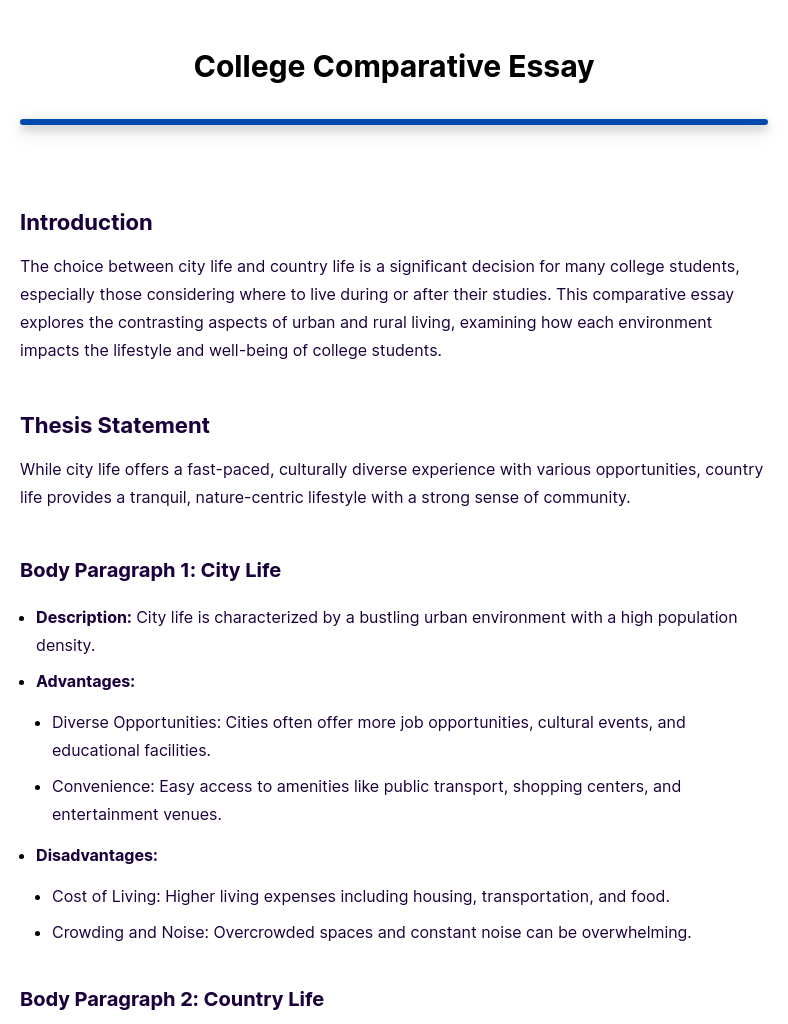
College Comparative Essay
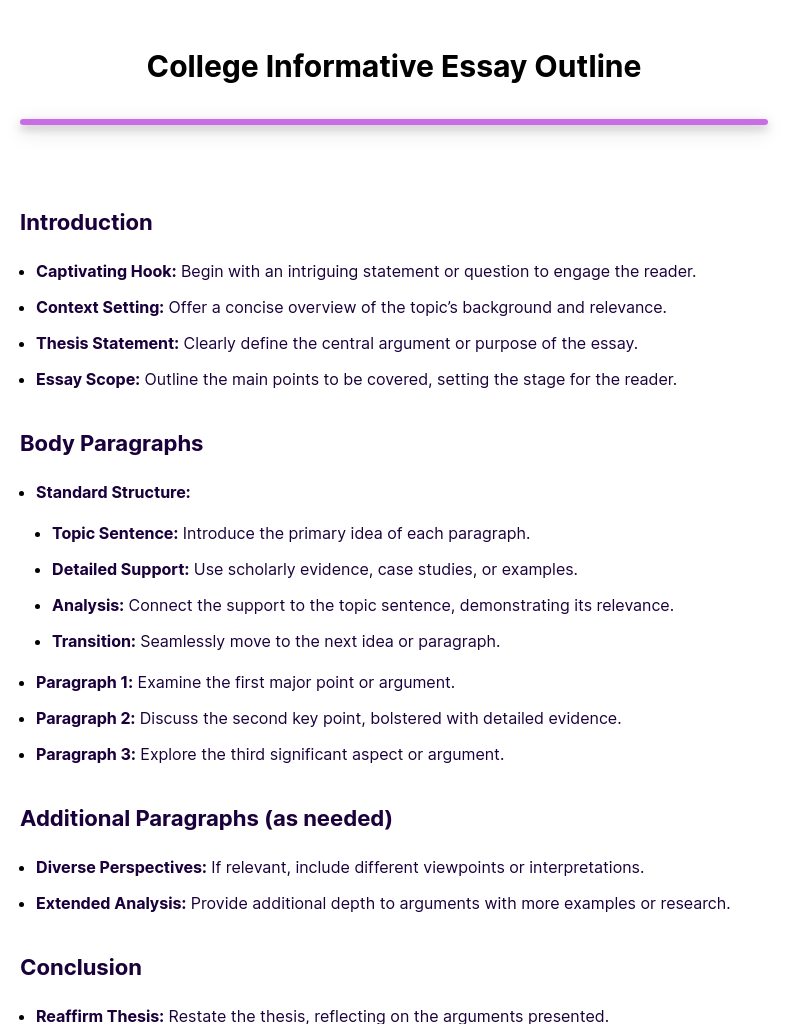
College Informative Essay Outline
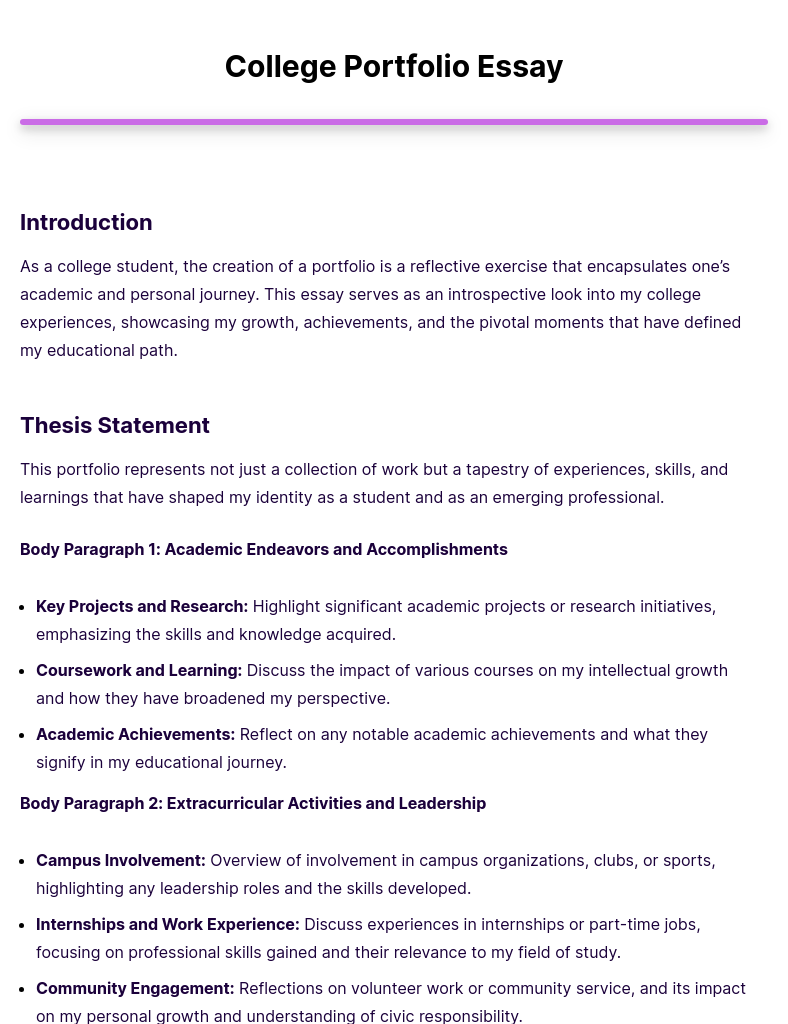
College Portfolio Essay

College Synthesis Essay
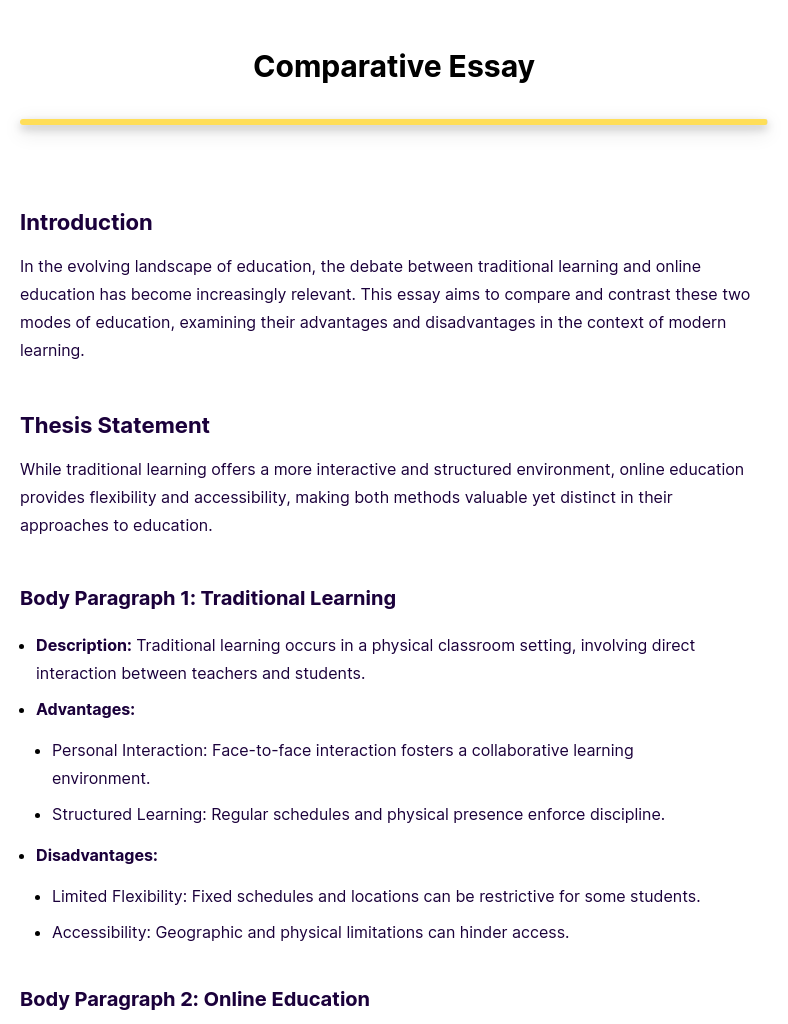
Comparative Essay
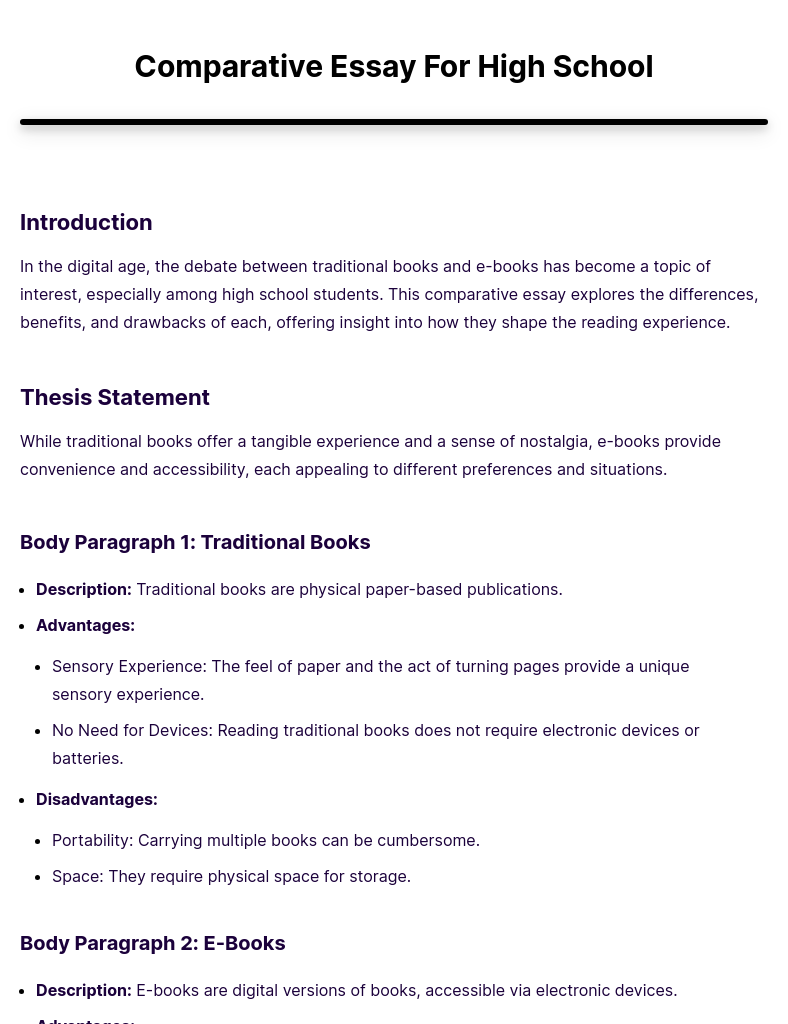
Comparative Essay For High School
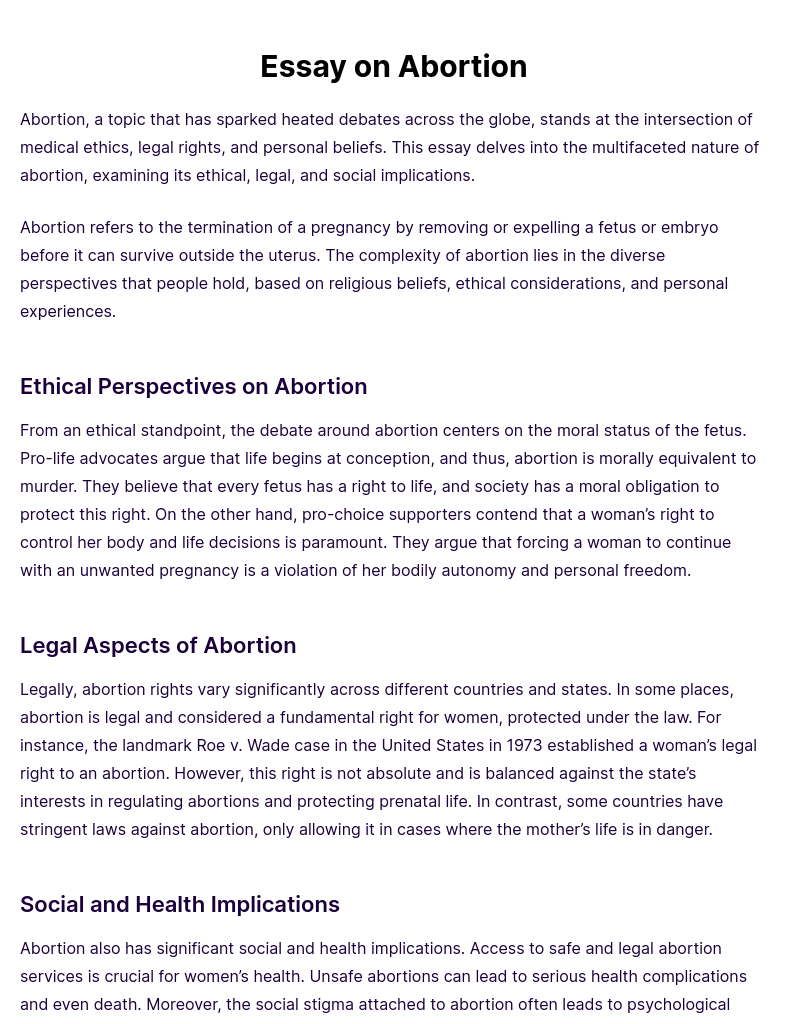
Essay on Abortion
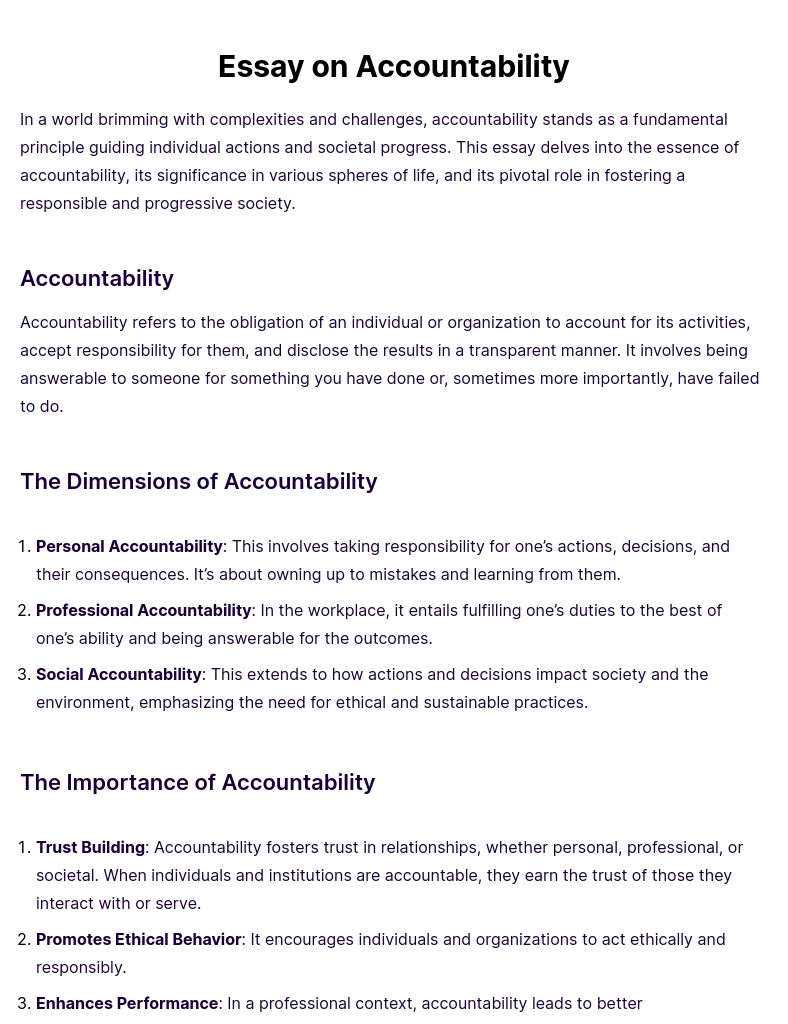
Essay on Accountability

Essay on Addiction
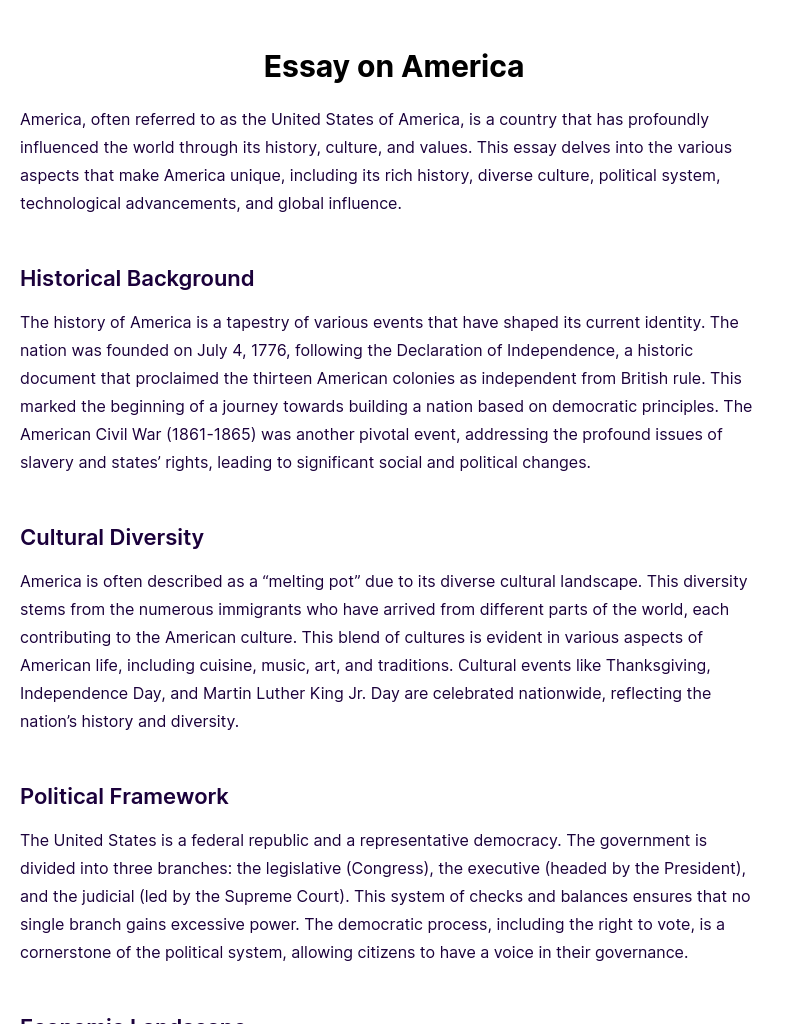
Essay on America
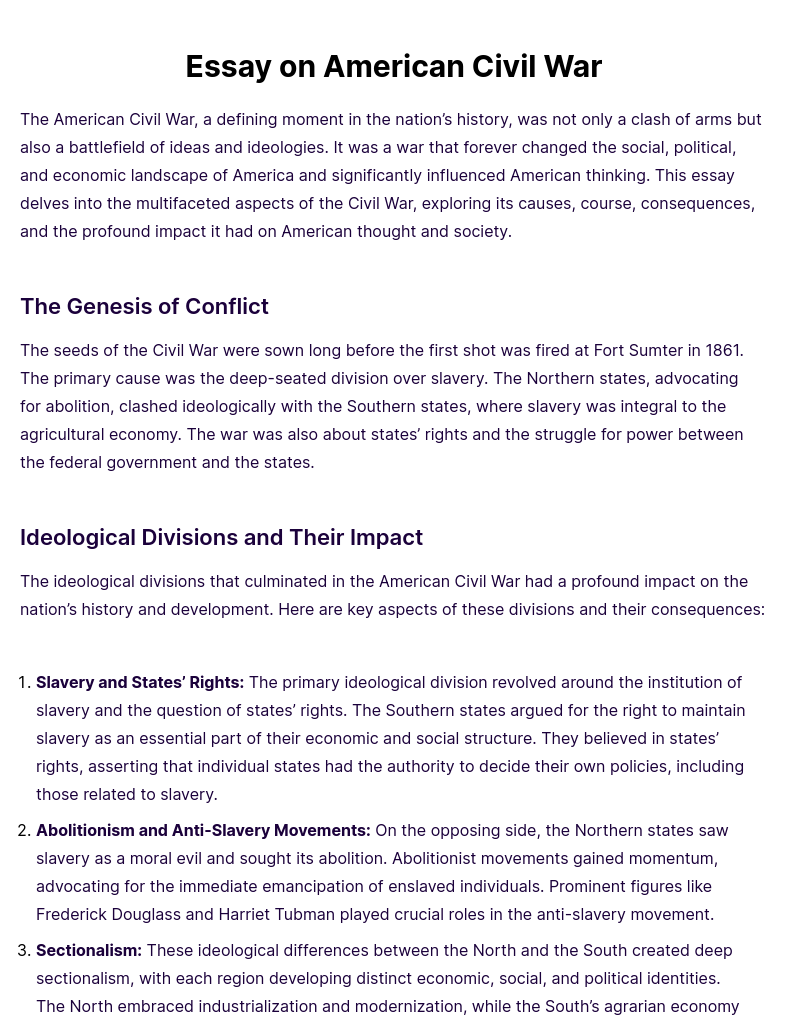
Essay on American Civil War
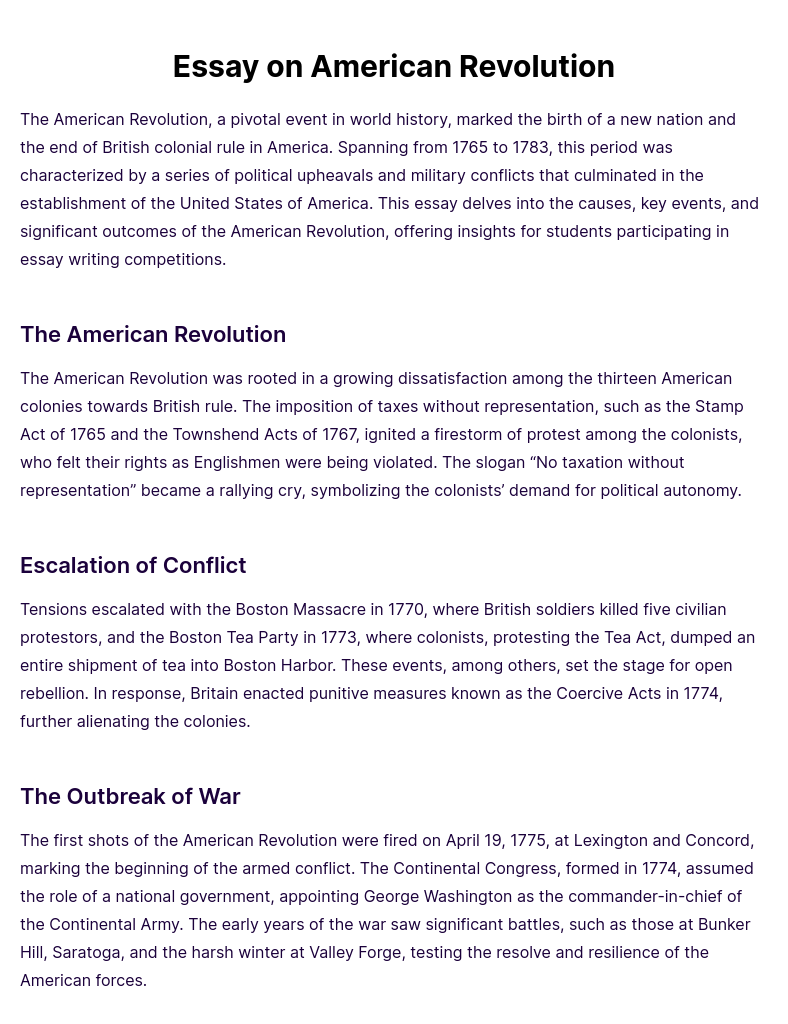
Essay on American Revolution
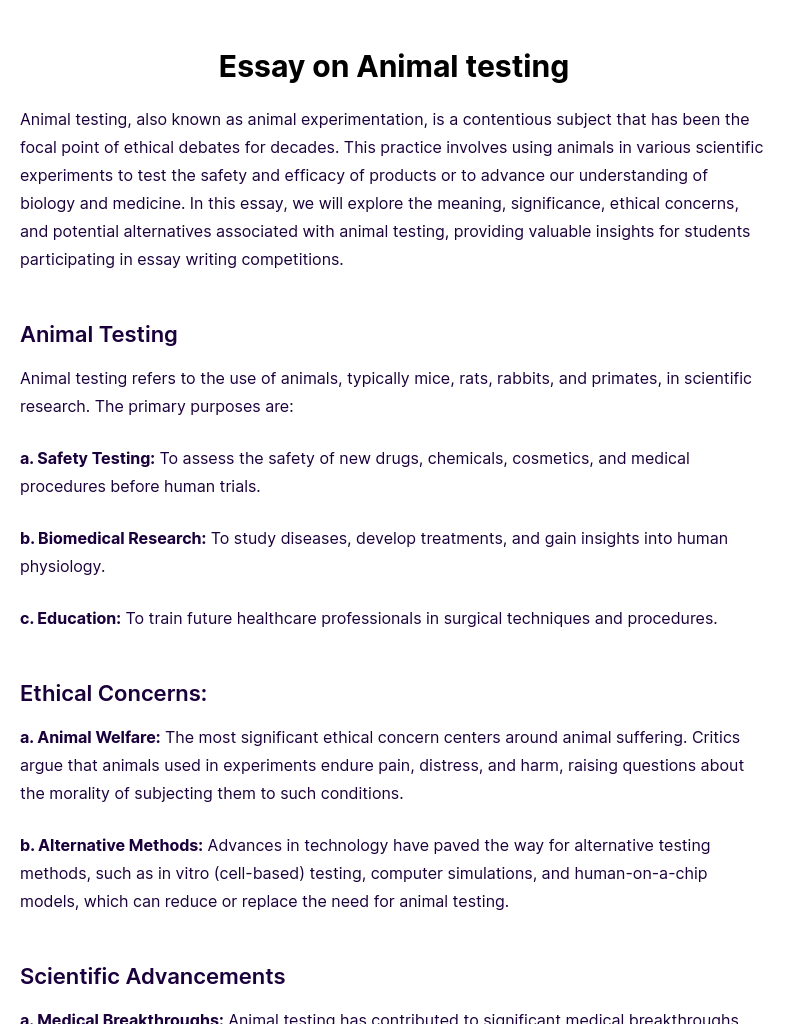
Essay on Animal testing
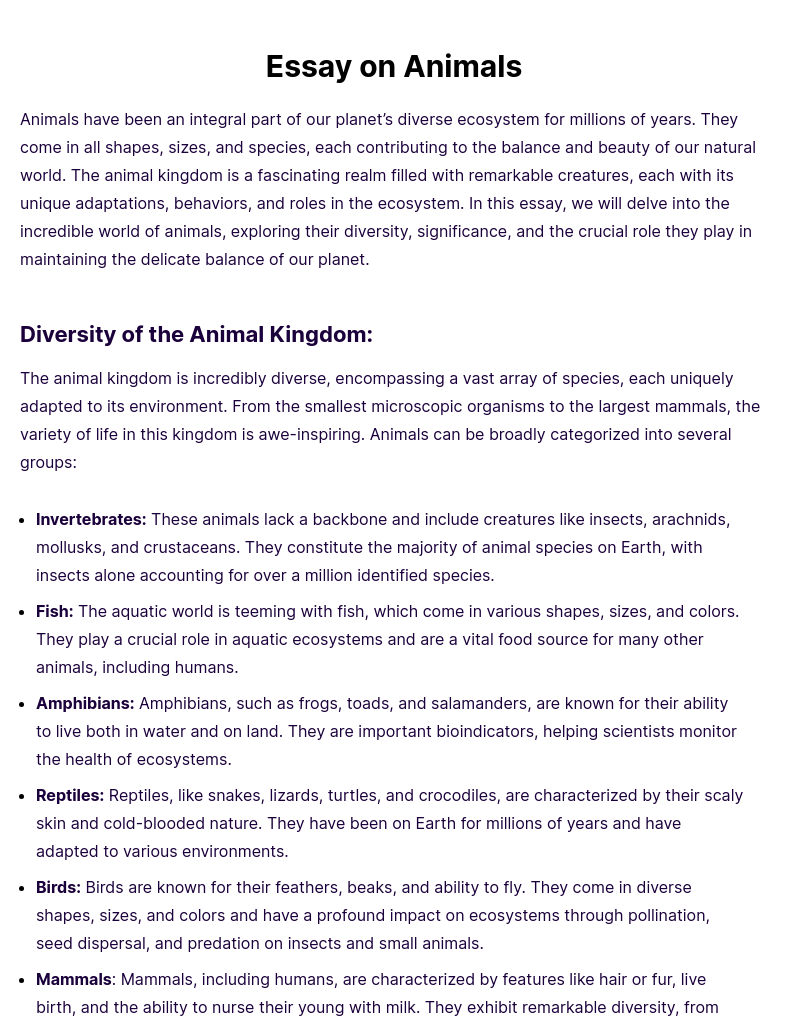
Essay on Animals

Essay on Anxiety
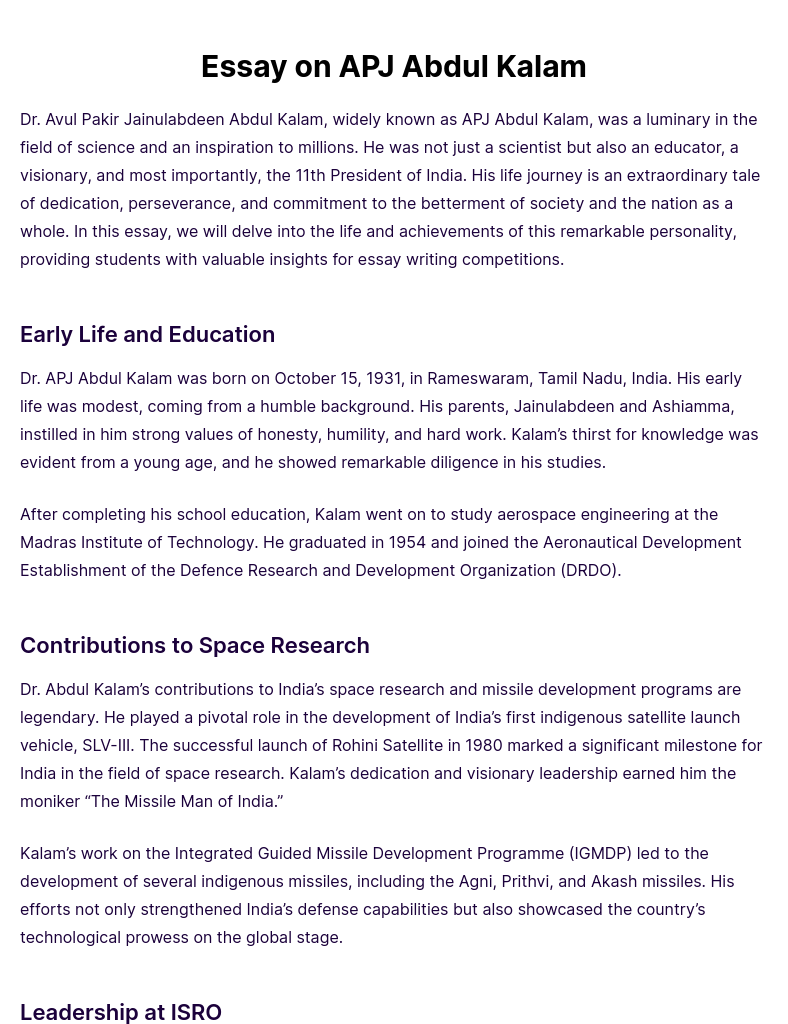
Essay on APJ Abdul Kalam

Essay on Art

Essay on Artificial Intelligence (AI)
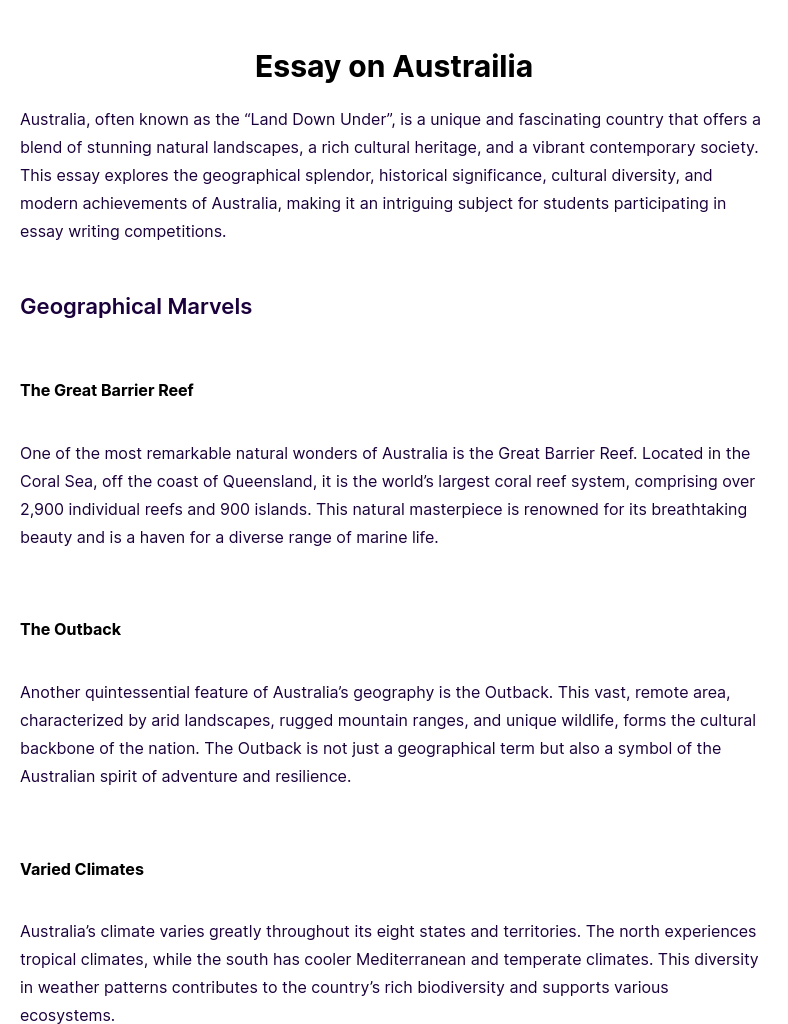
Essay on Austrailia

Essay on Basketball
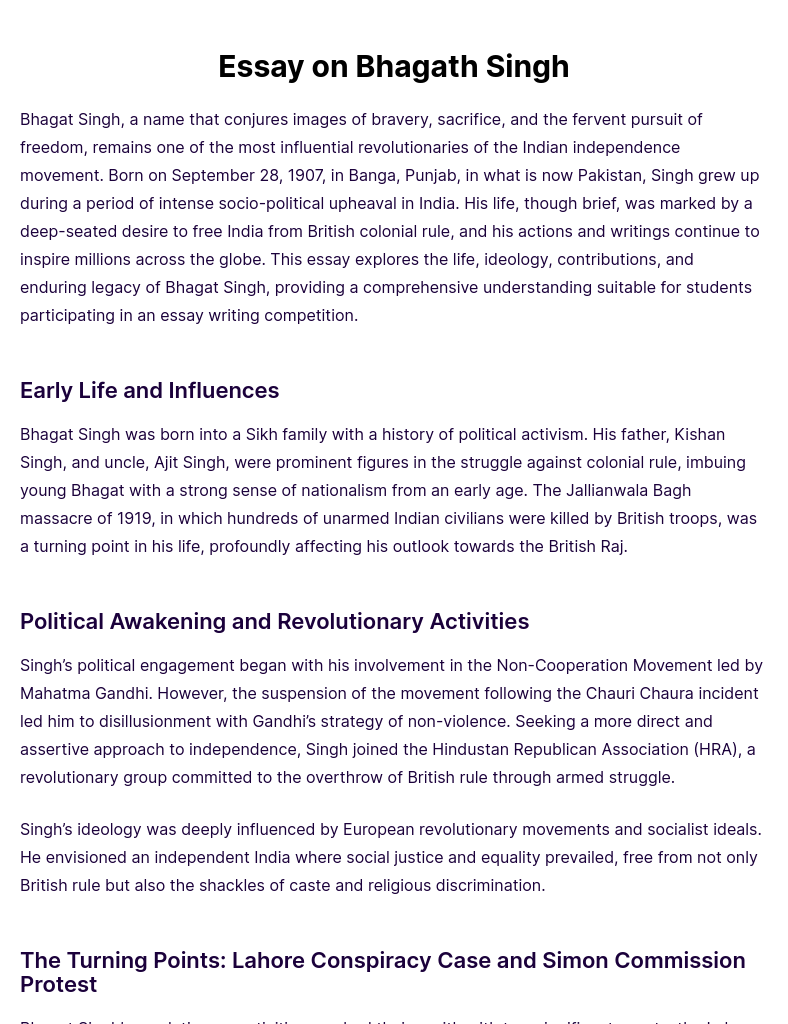
Essay on Bhagath Singh
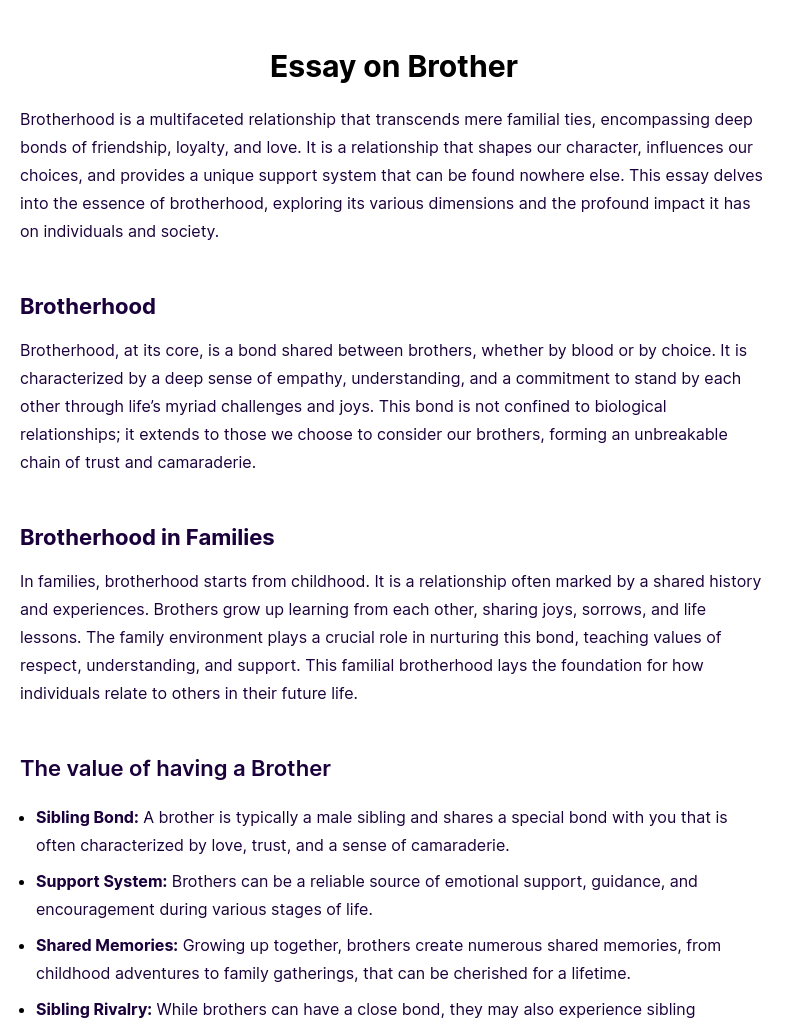
Essay on Brother
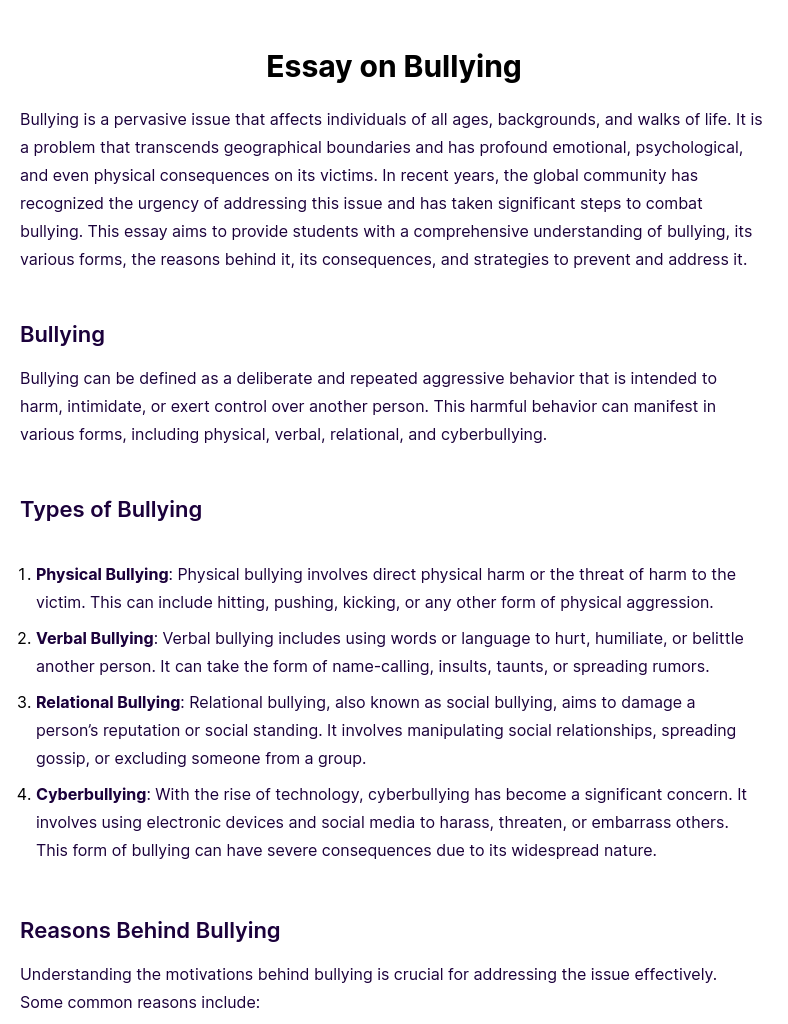
Essay on Bullying

Essay on Career Goals
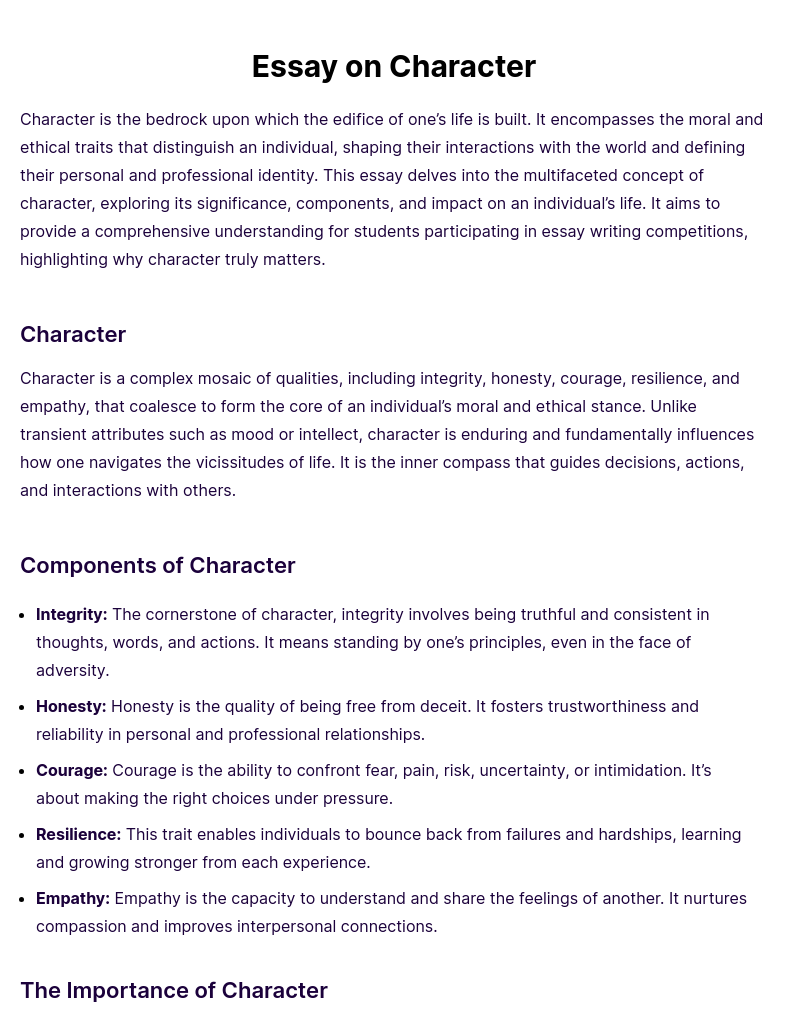
Essay on Character
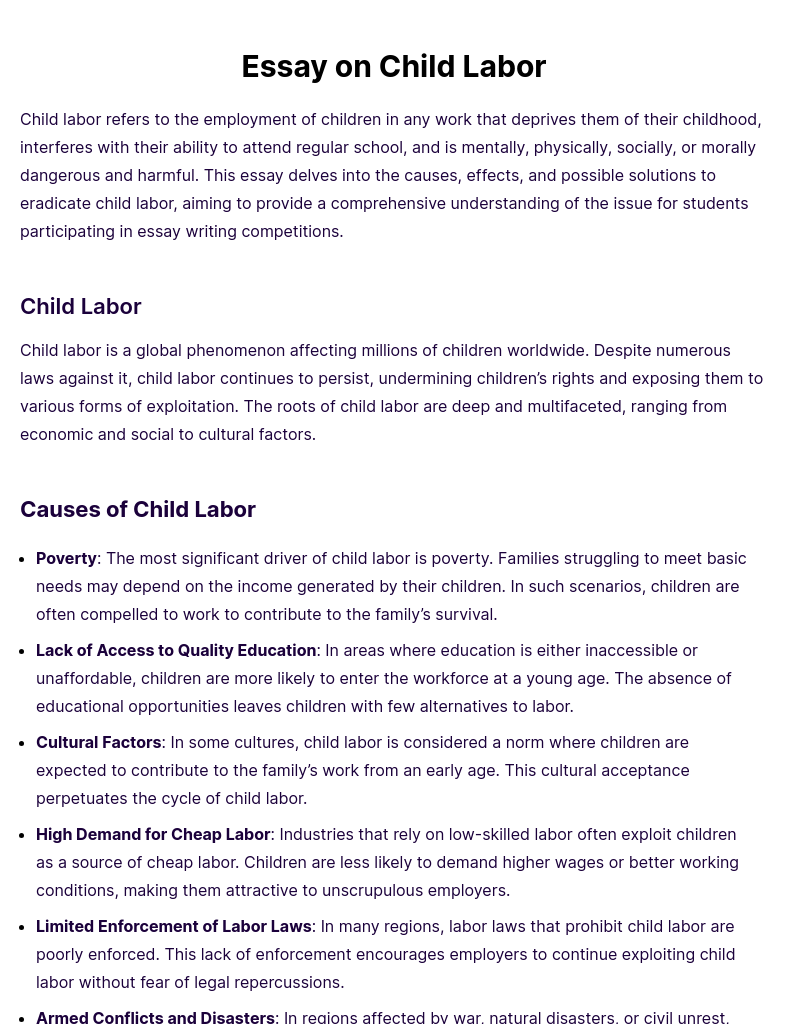
Essay on Child Labor
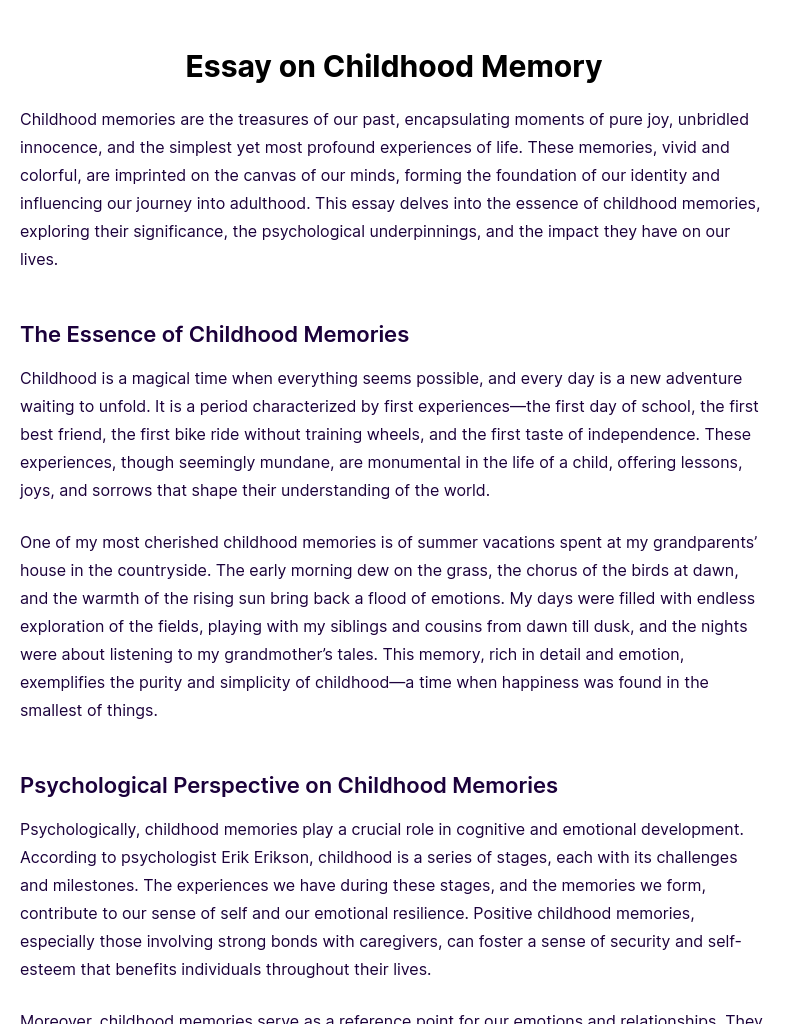
Essay on Childhood Memory
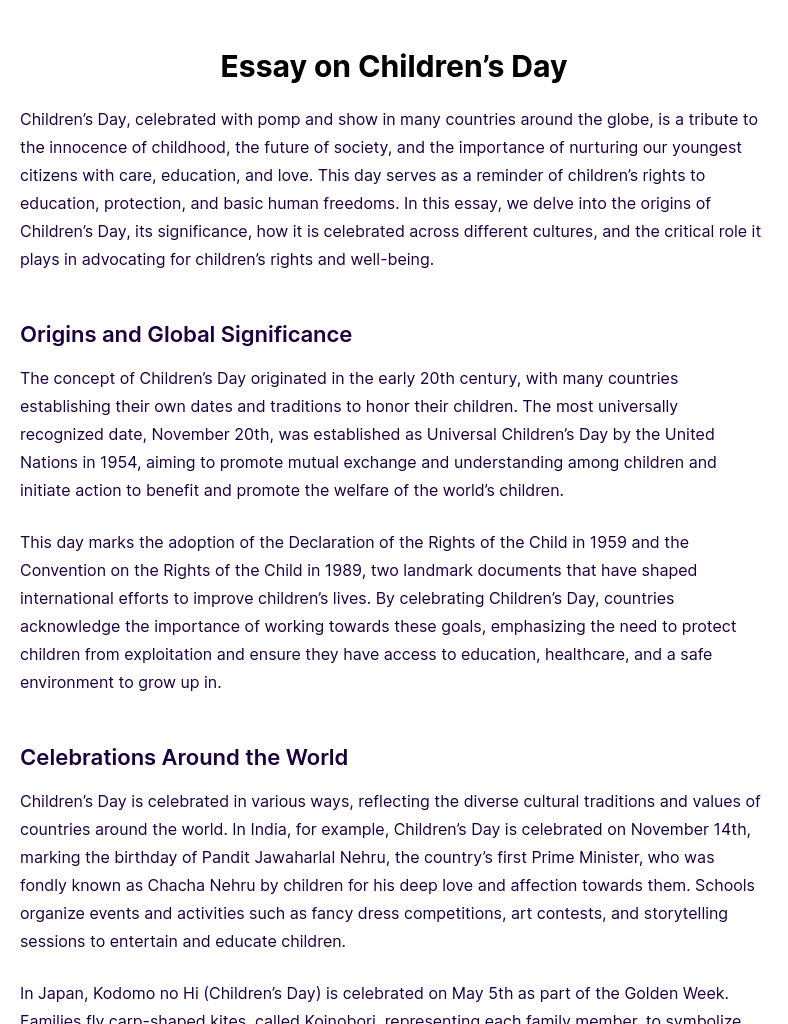
Essay on Children’s Day
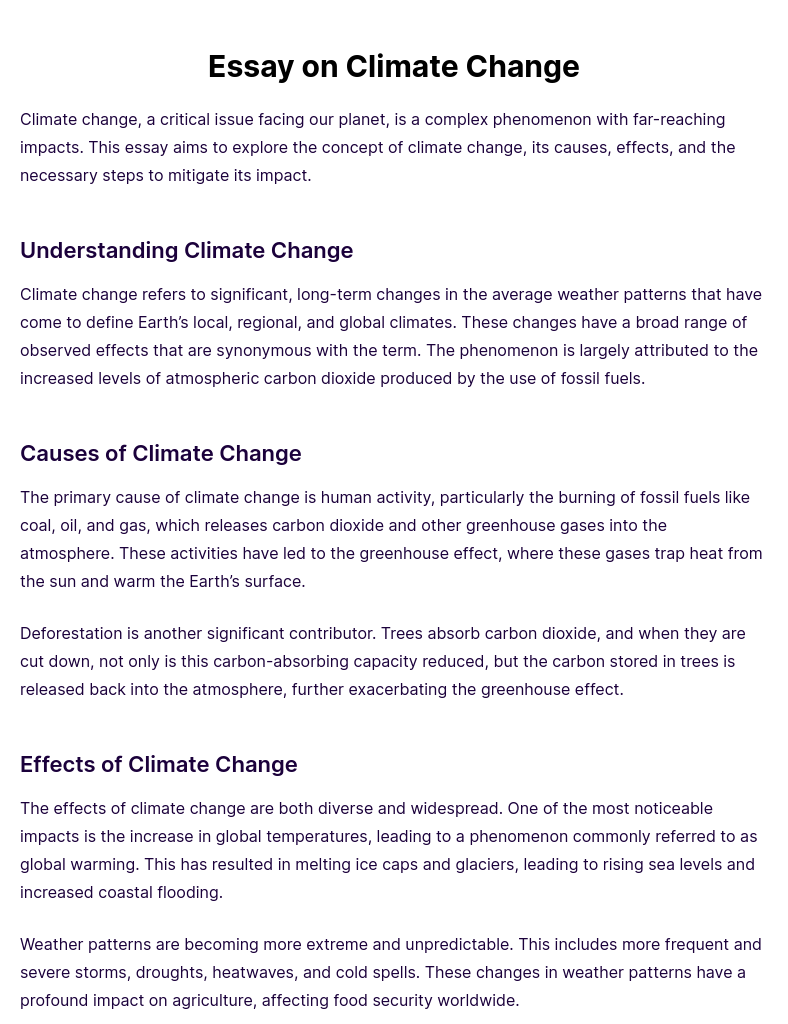
Essay on Climate Change
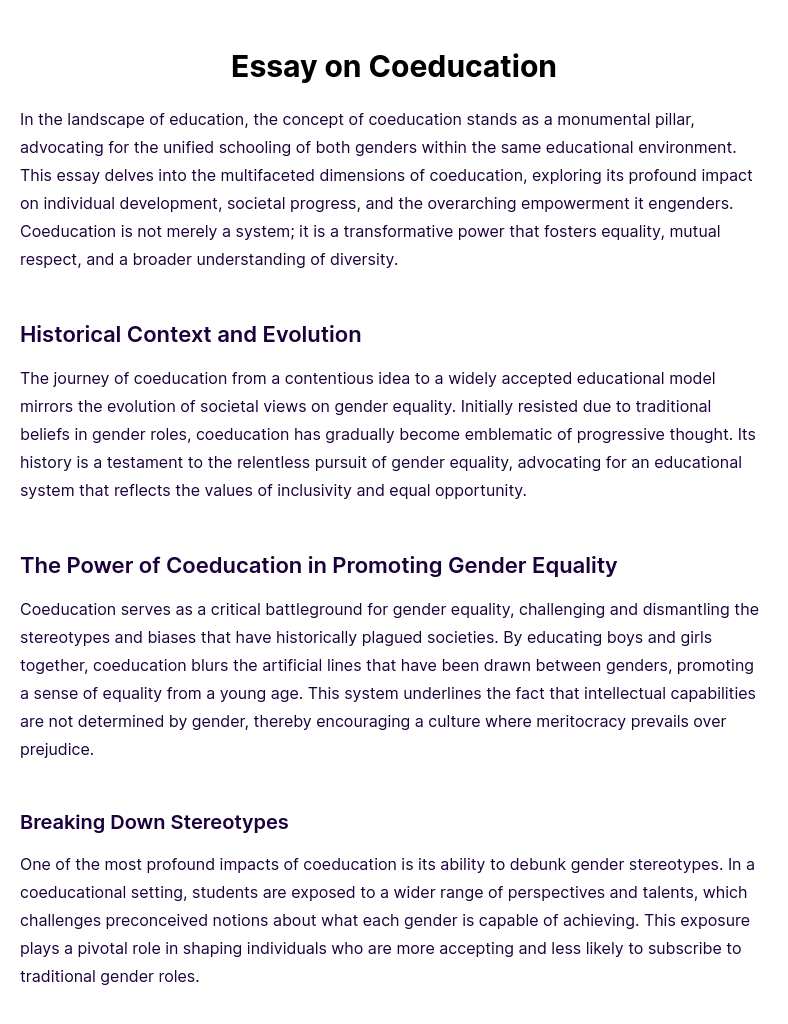
Essay on Coeducation
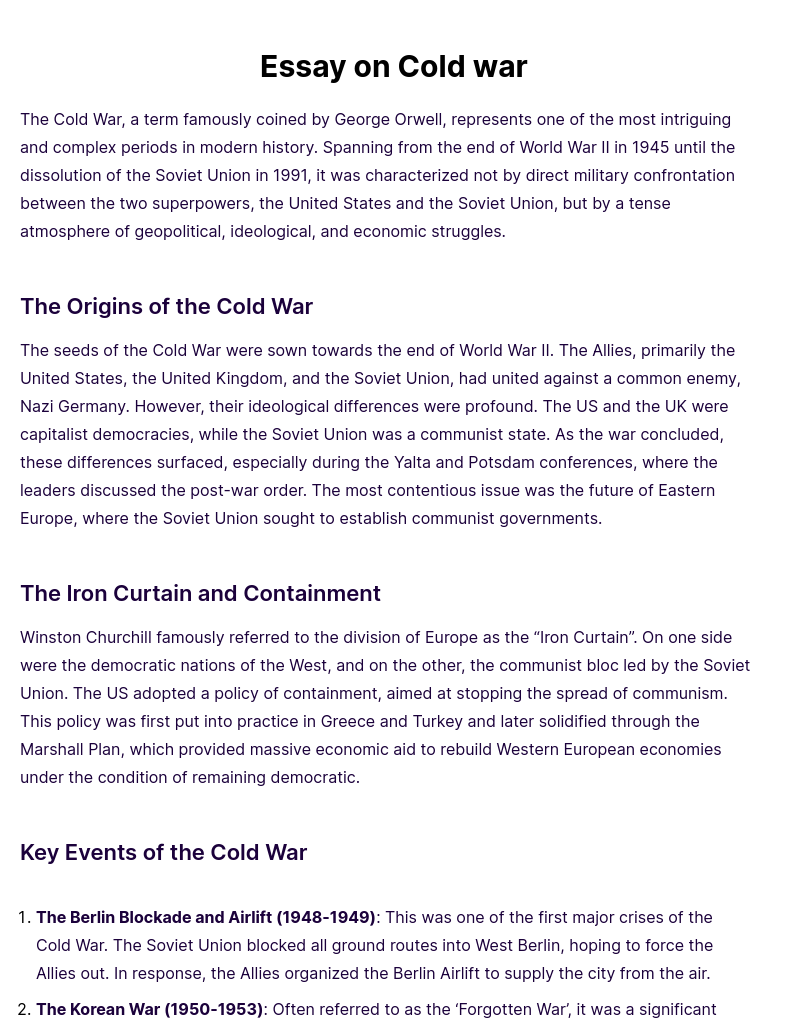
Essay on Cold war
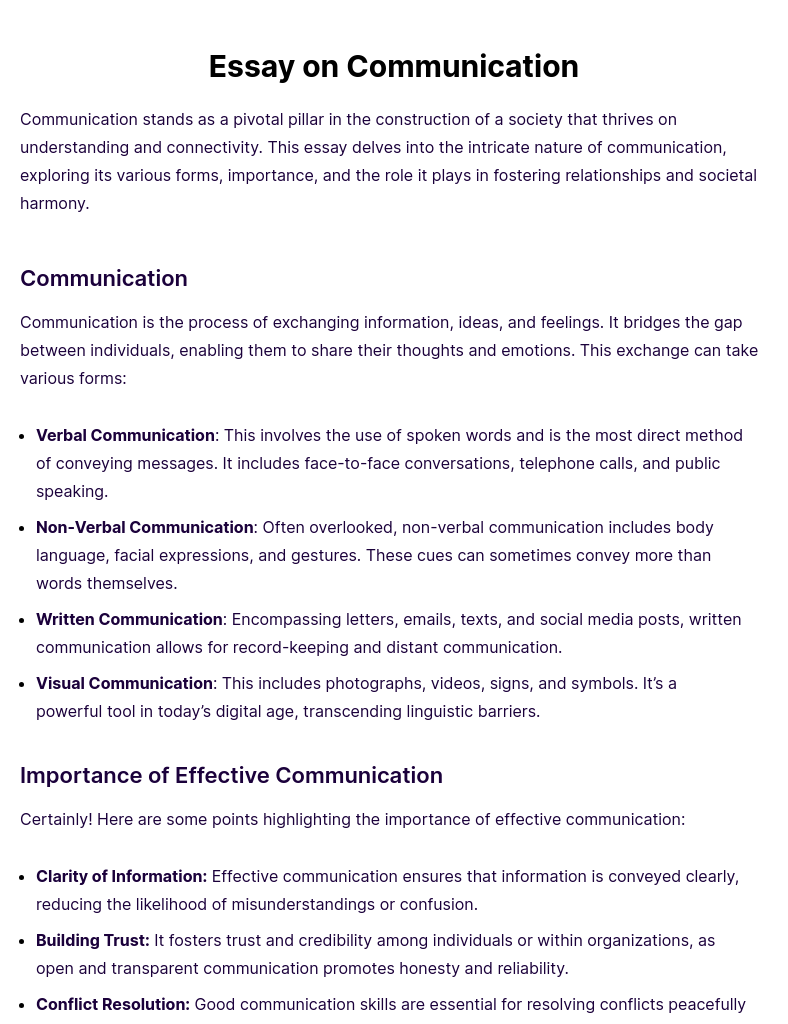
Essay on Communication

Essay on Computer
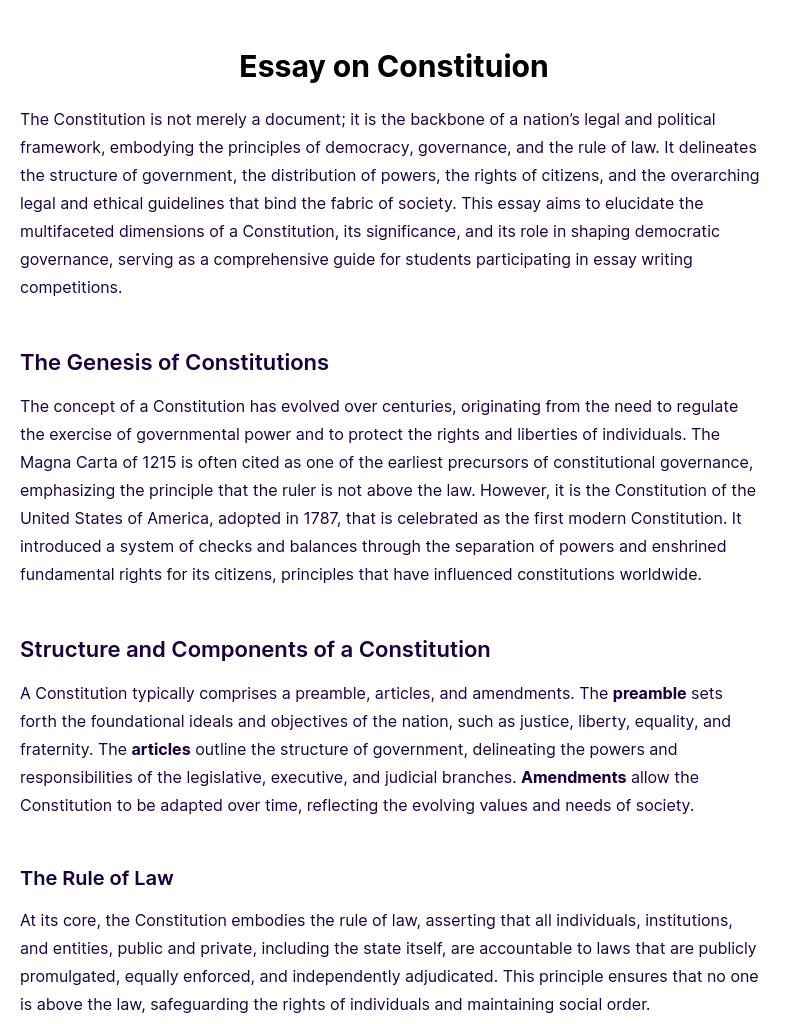
Essay on Constituion
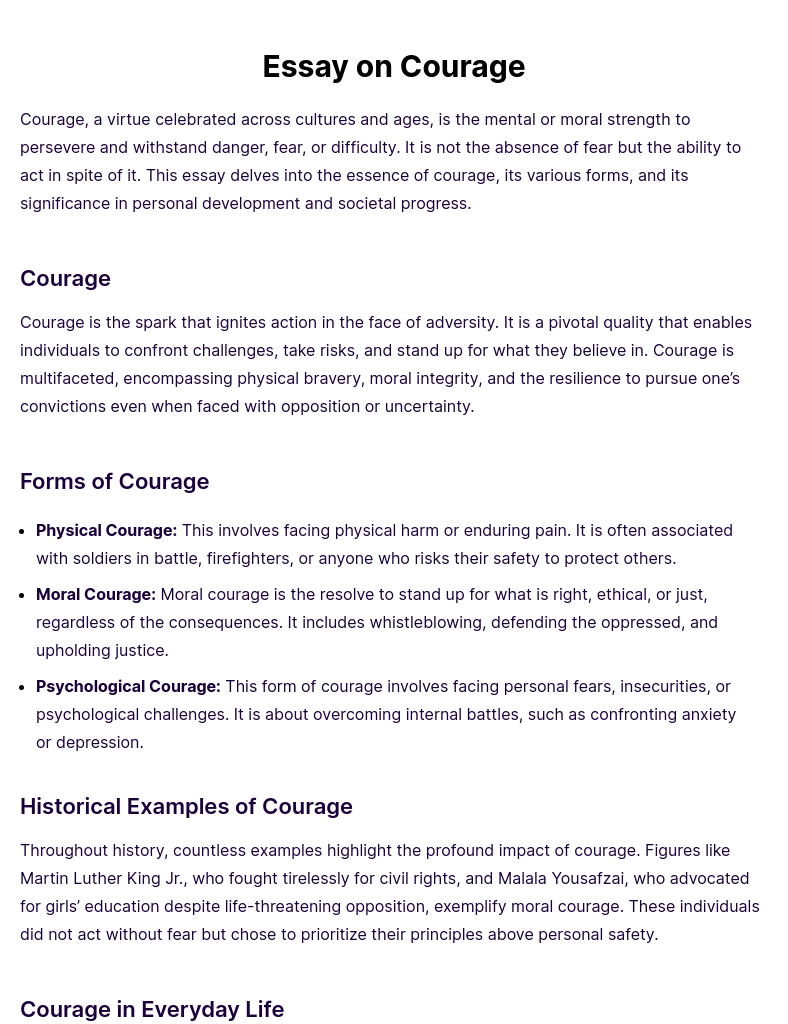
Essay on Courage
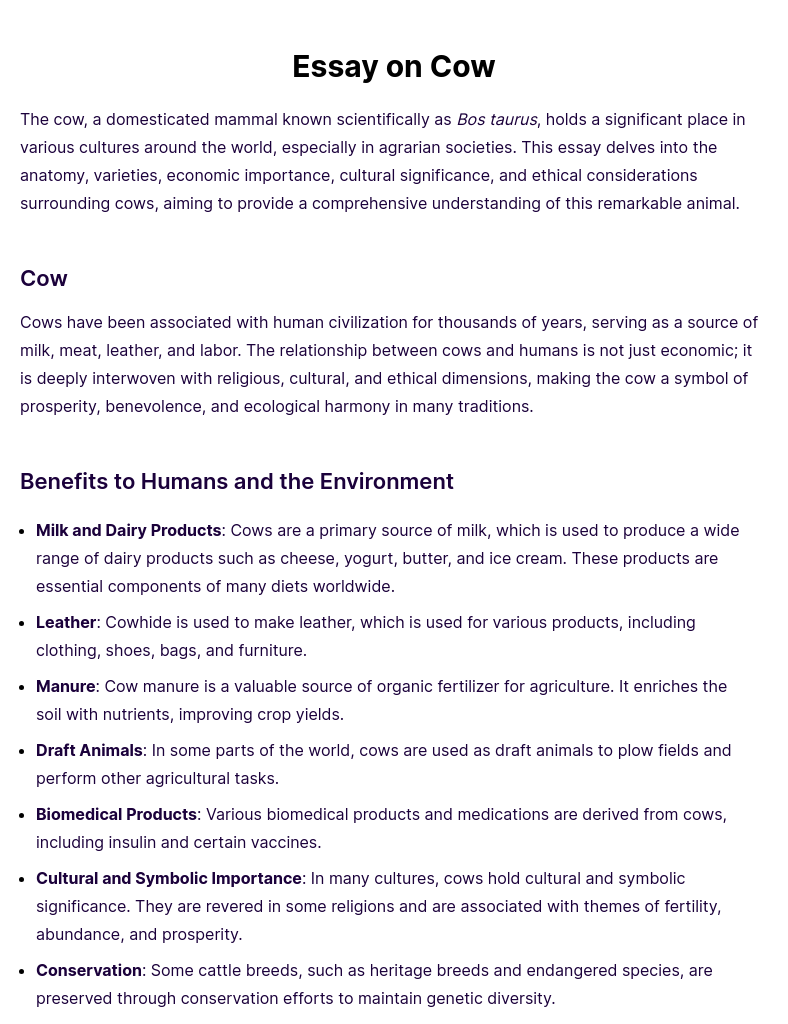
Essay on Cow
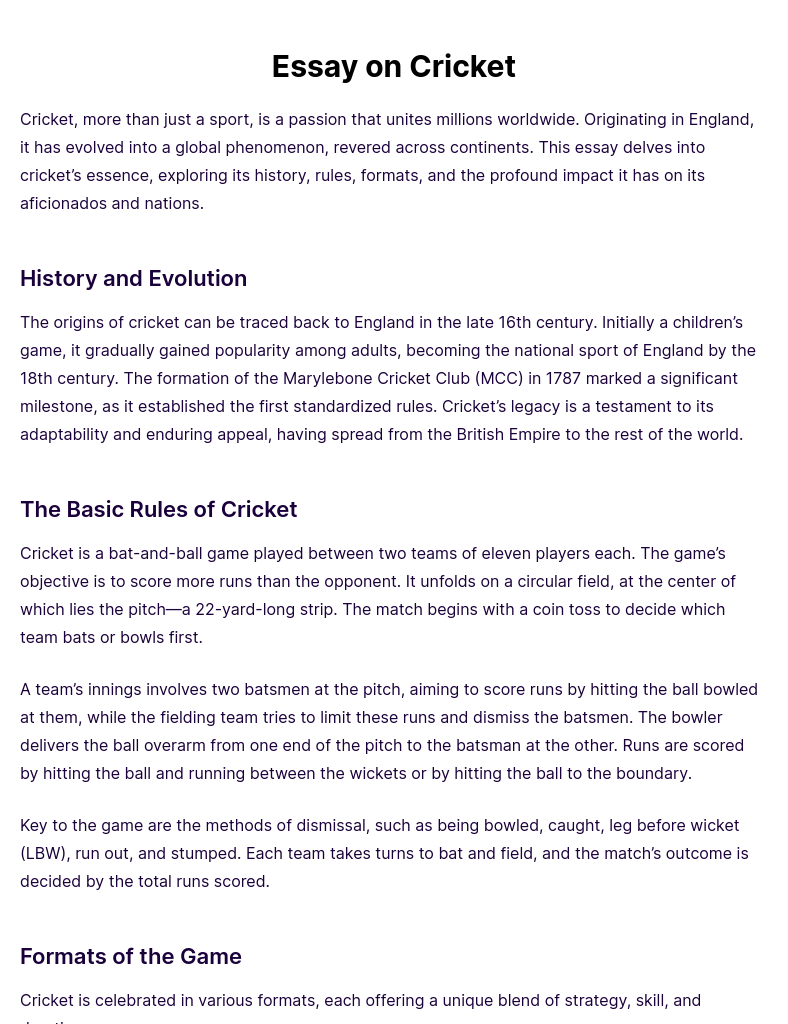
Essay on Cricket
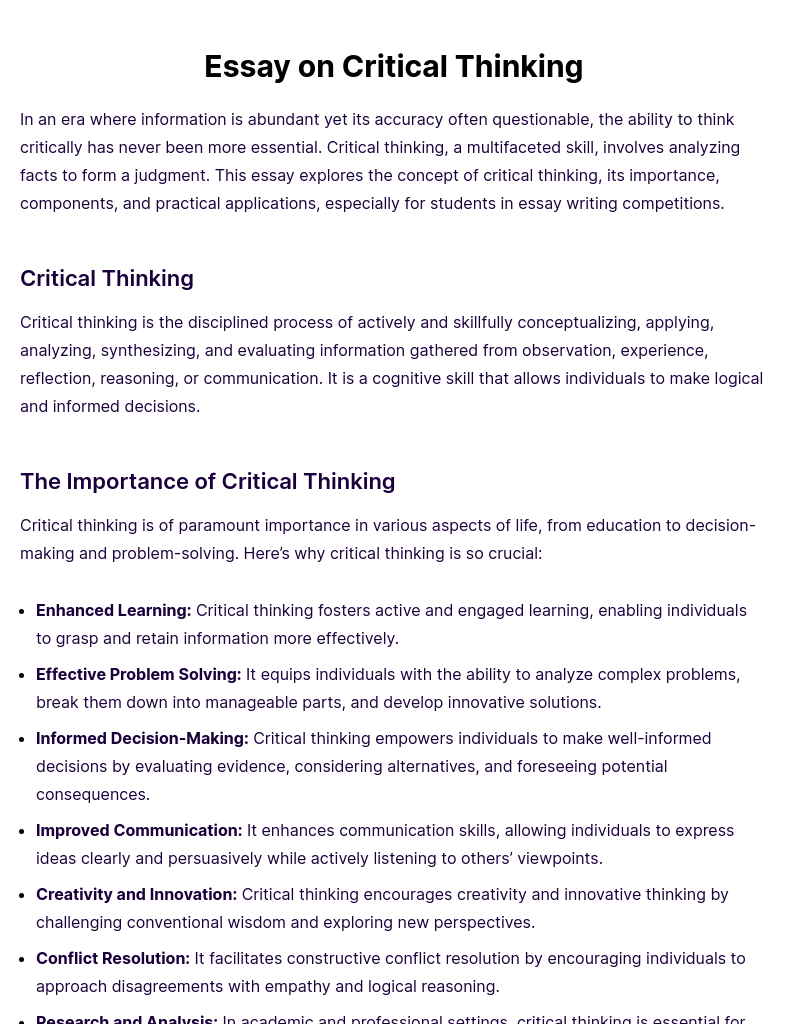
Essay on Critical Thinking
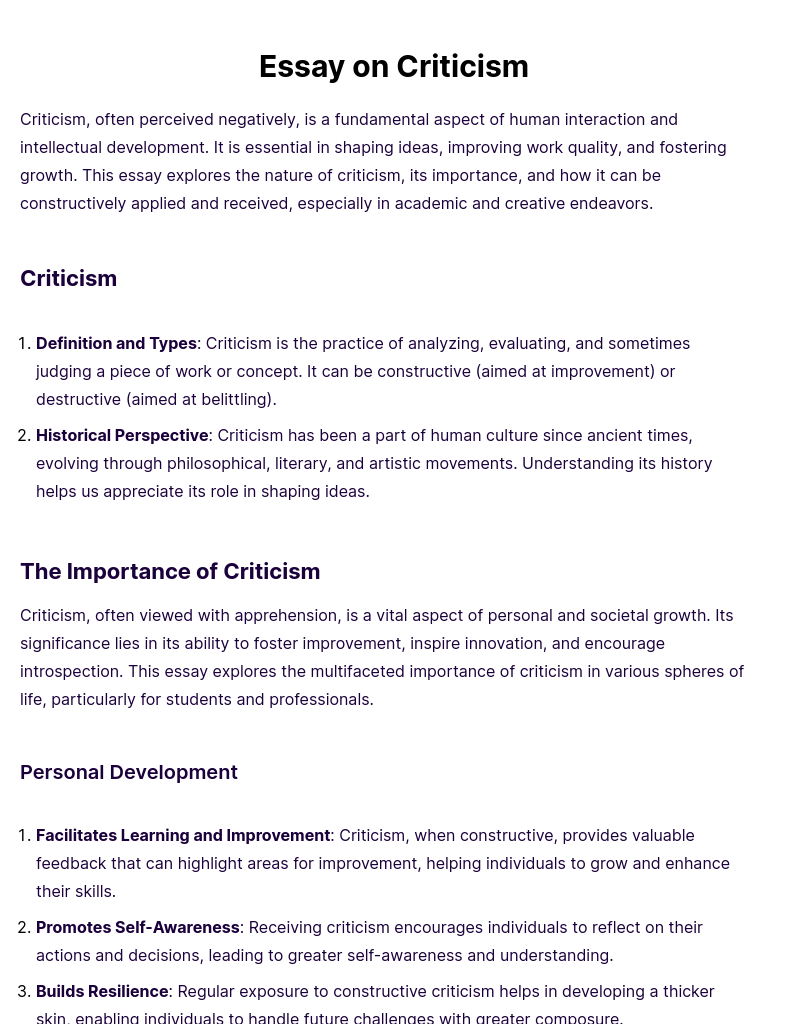
Essay on Criticism
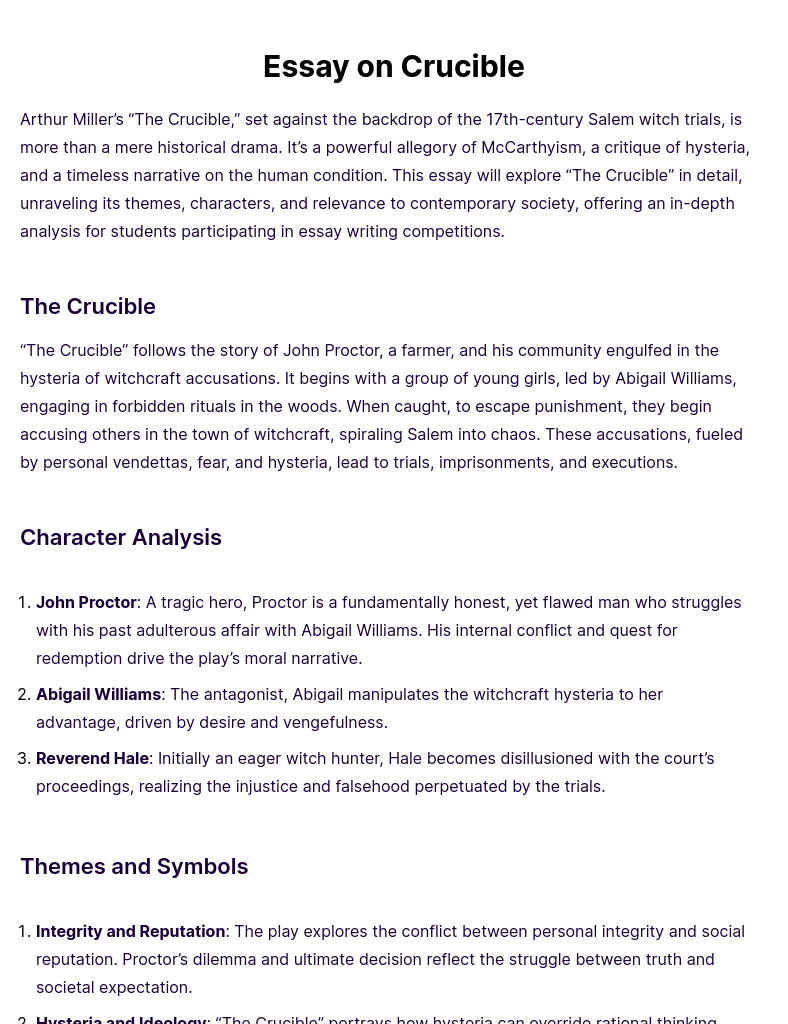
Essay on Crucible
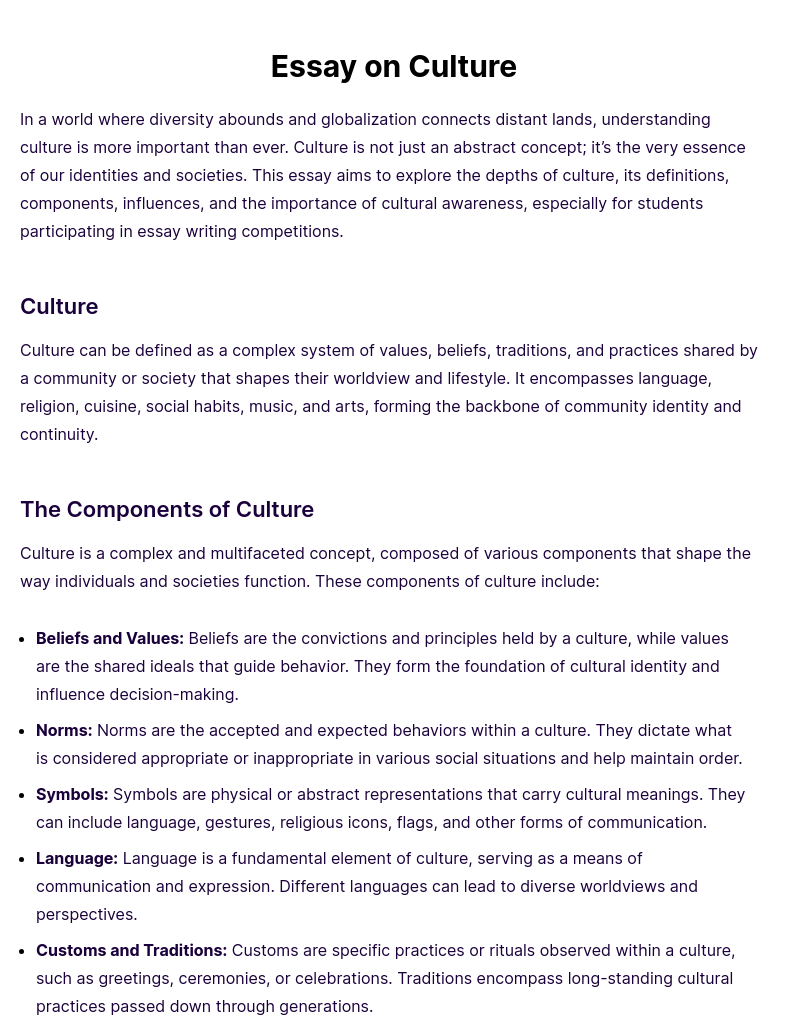
Essay on Culture
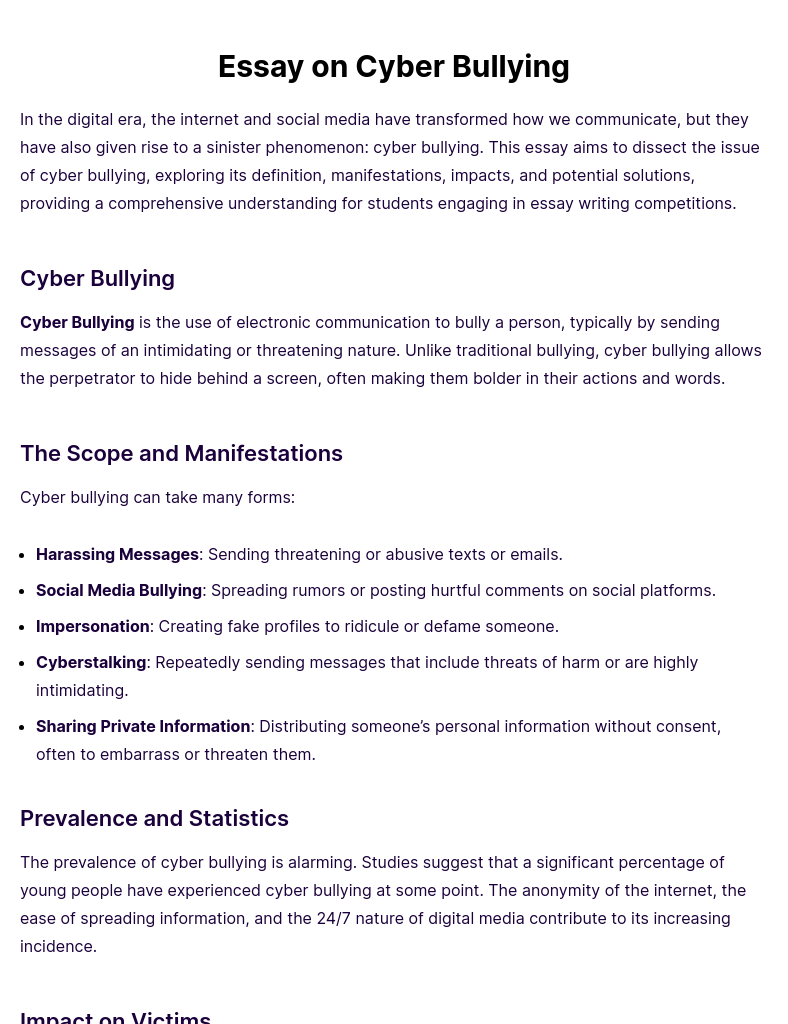
Essay on Cyber Bullying
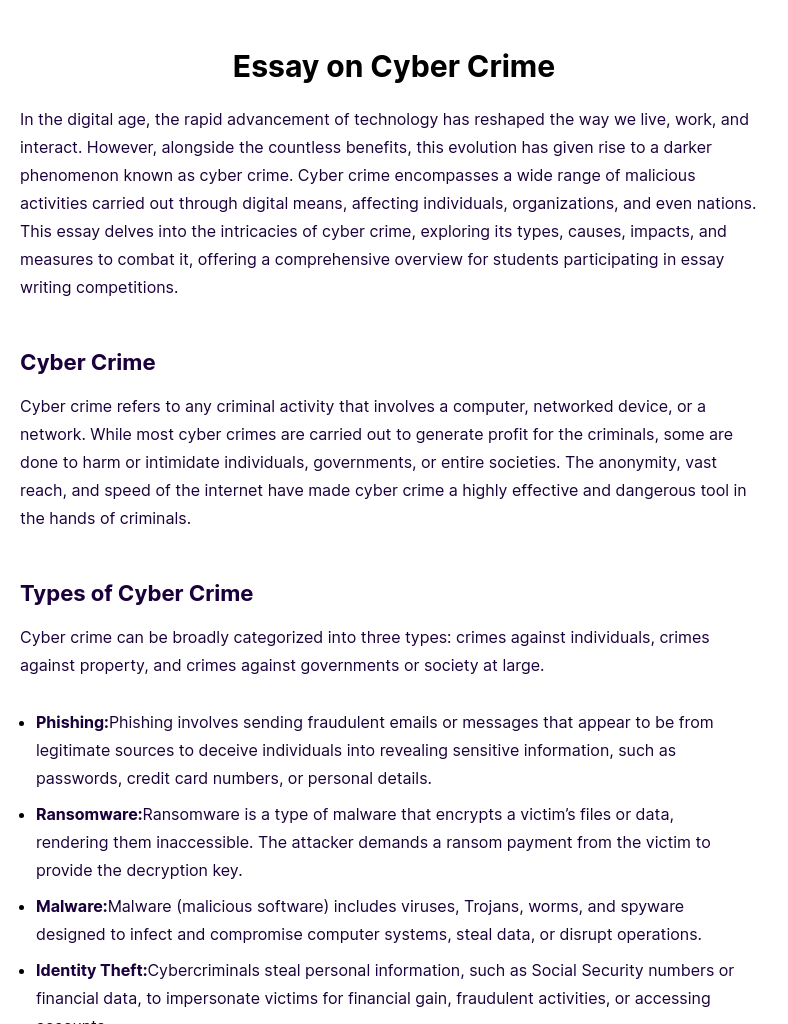
Essay on Cyber Crime
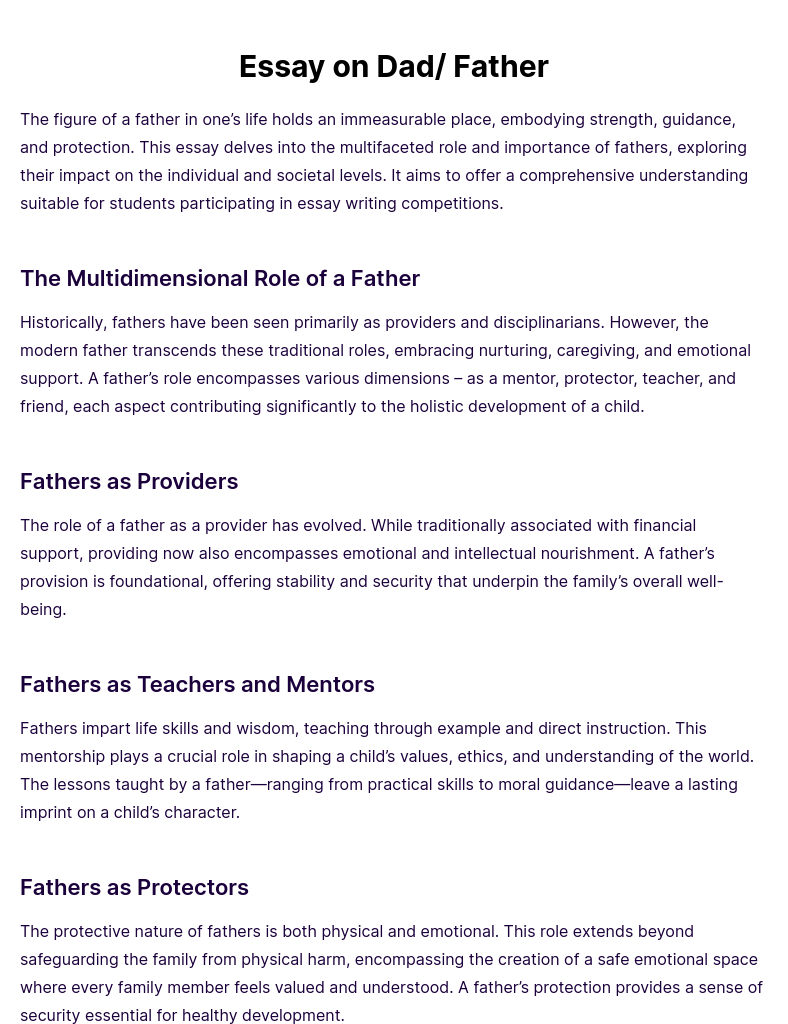
Essay on Dad/ Father

Essay on Daily Routine
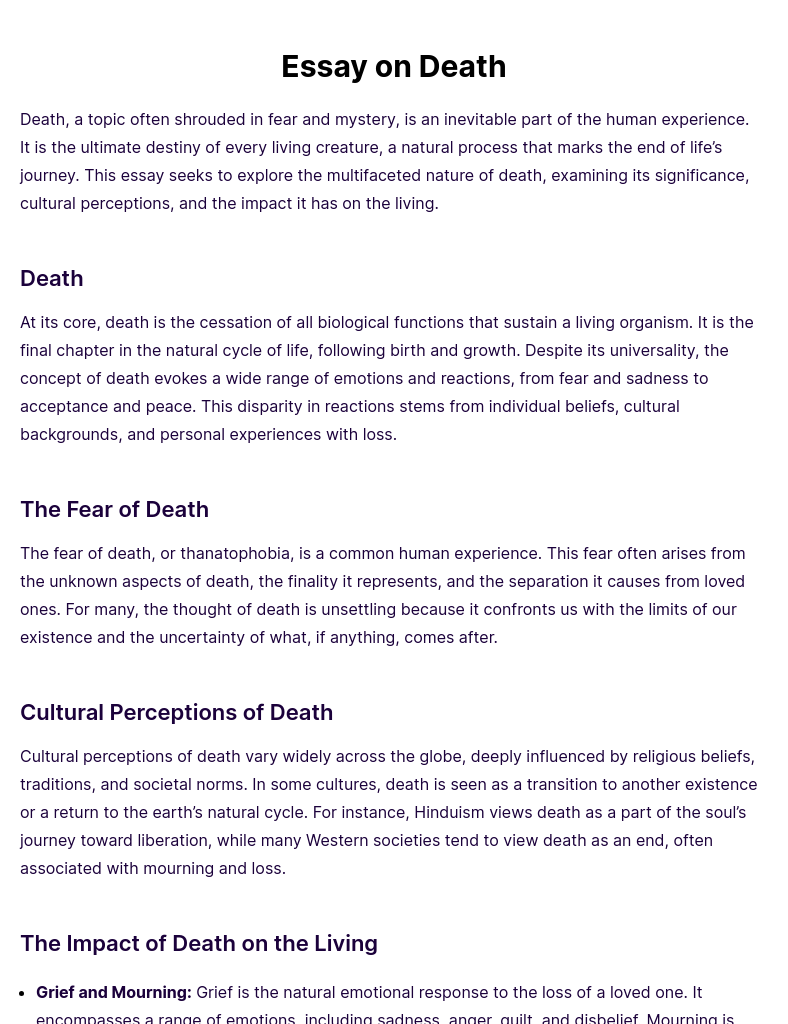
Essay on Death
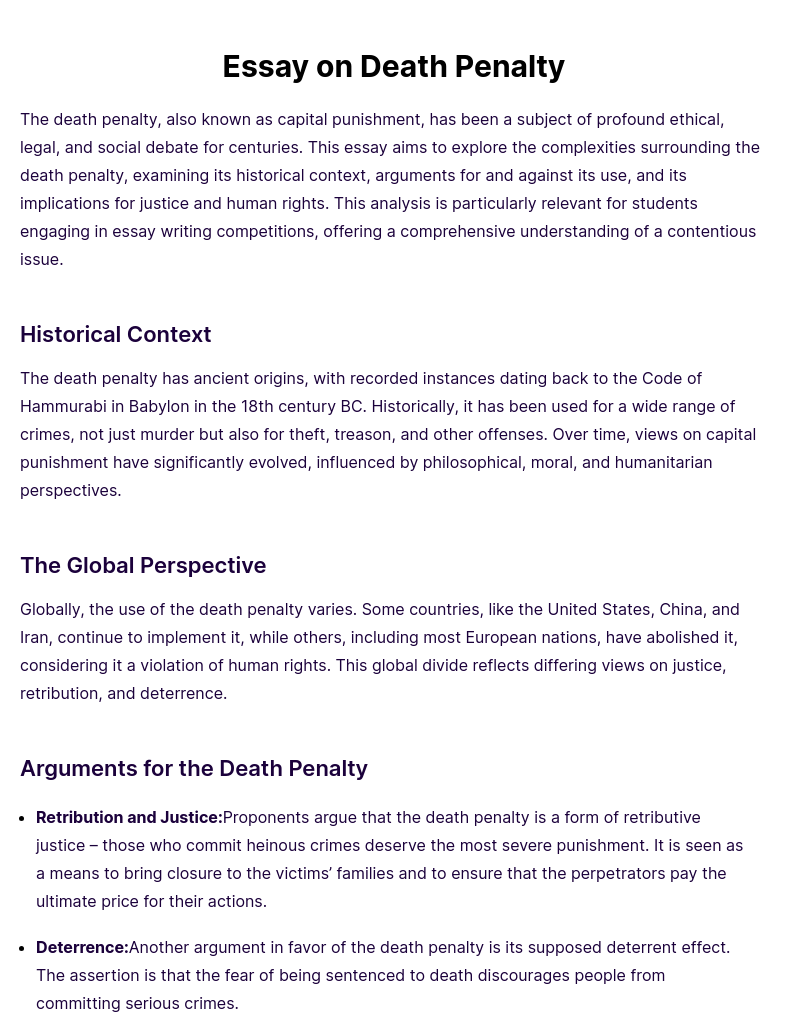
Essay on Death Penalty
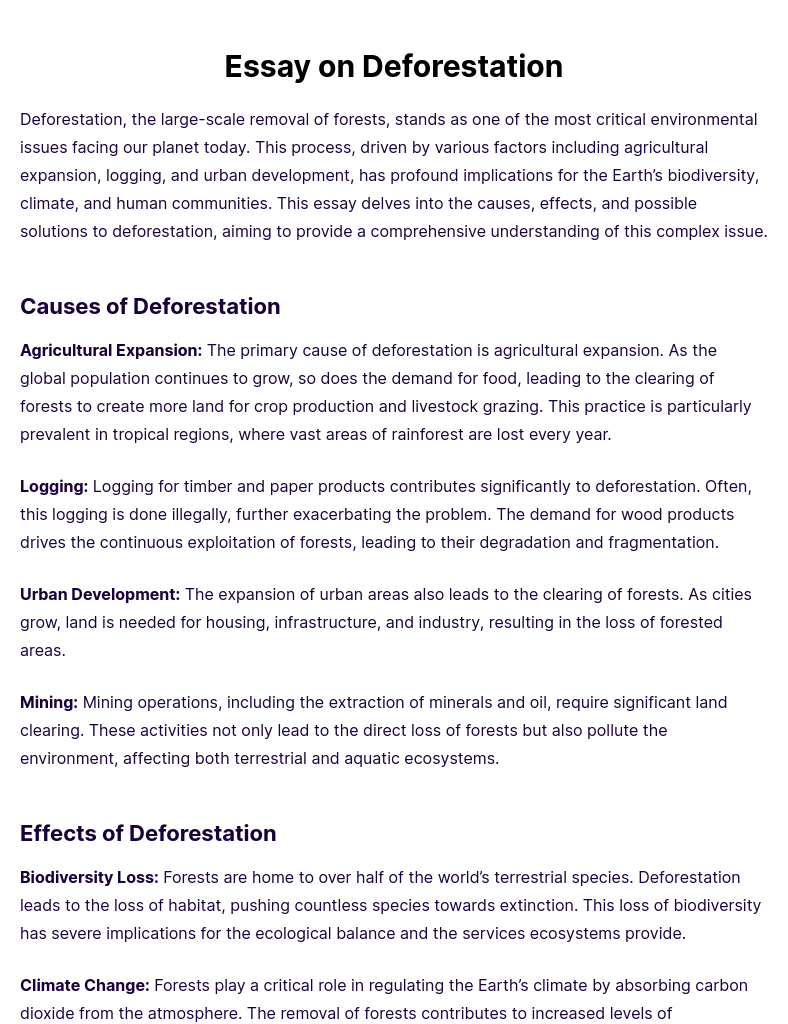
Essay on Deforestation
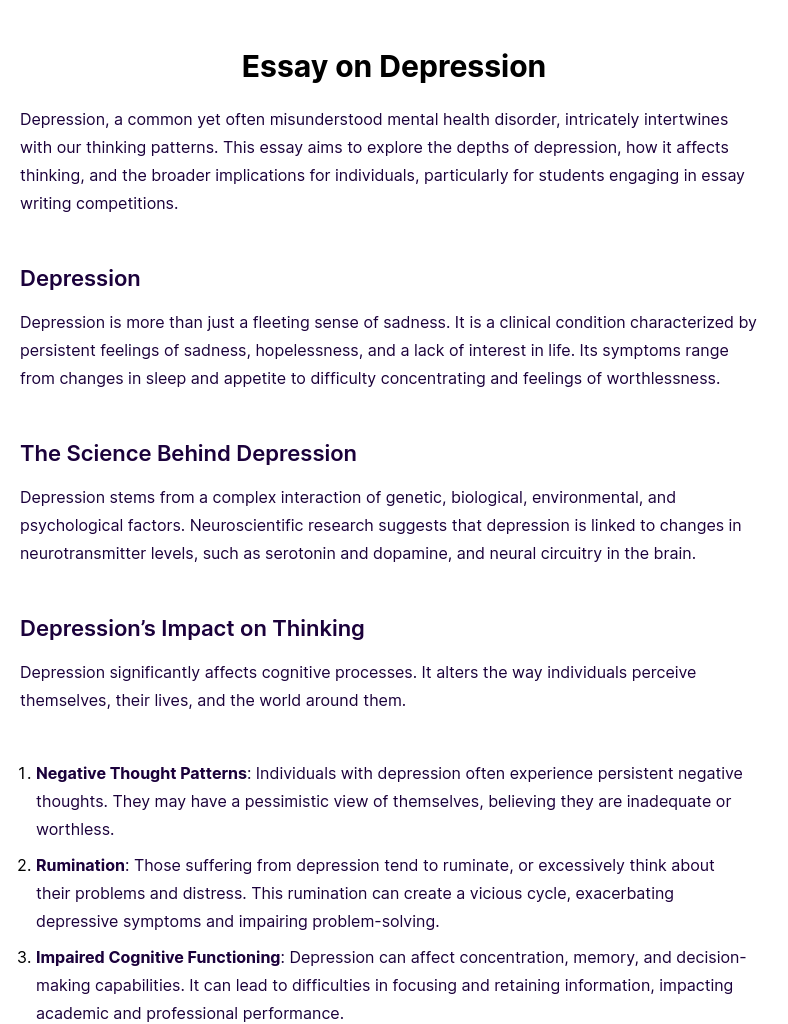
Essay on Depression
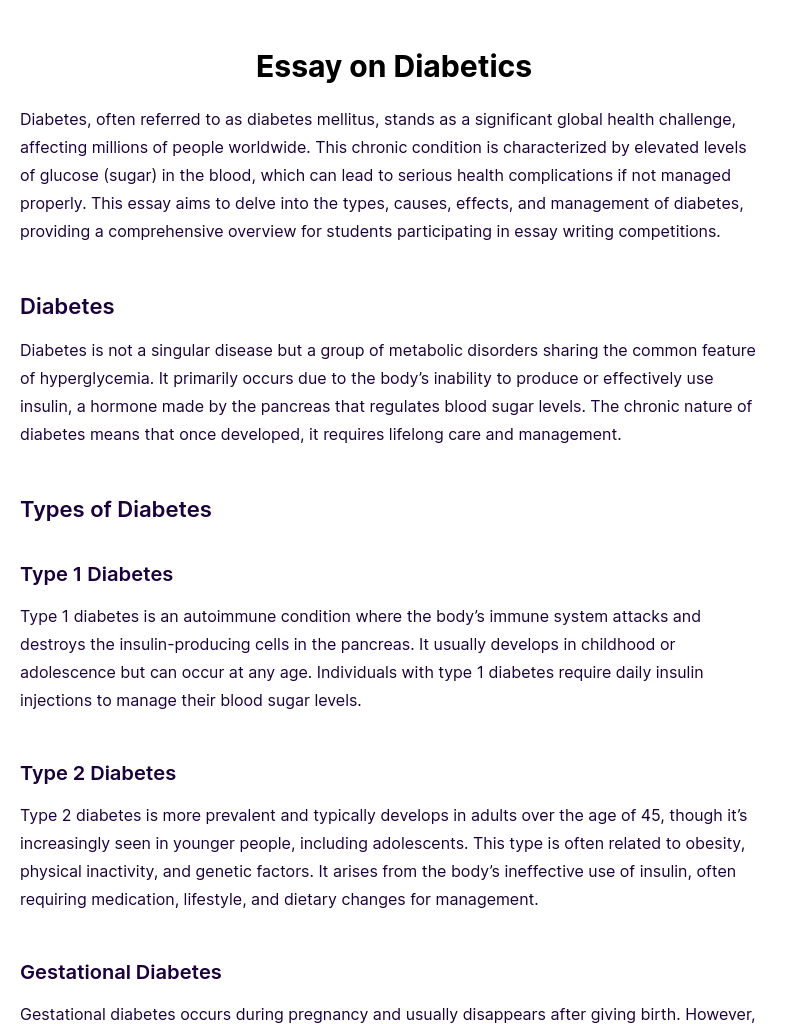
Essay on Diabetics
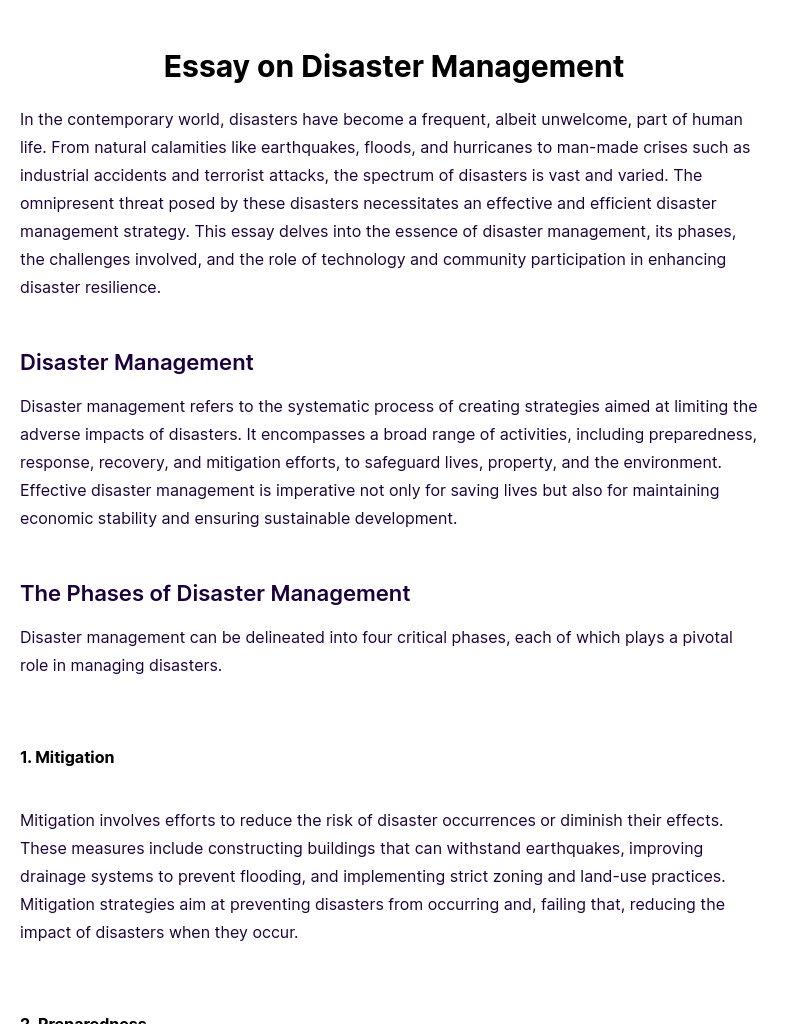
Essay on Disaster Management

Essay on Discipline
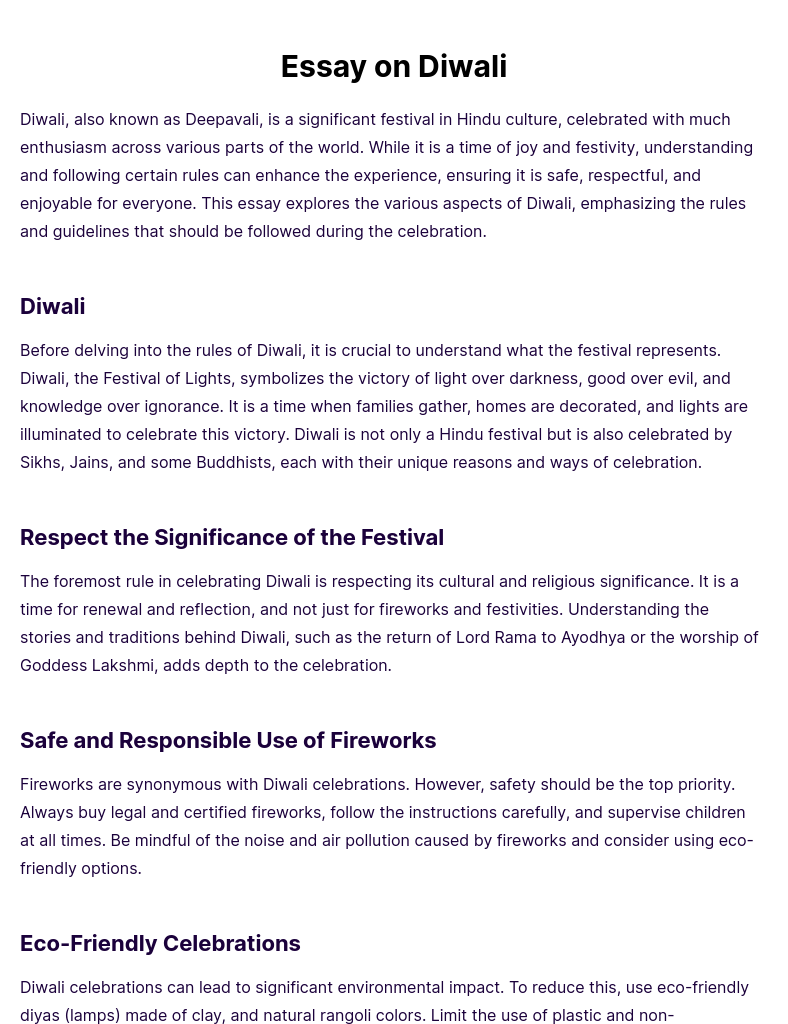
Essay on Diwali
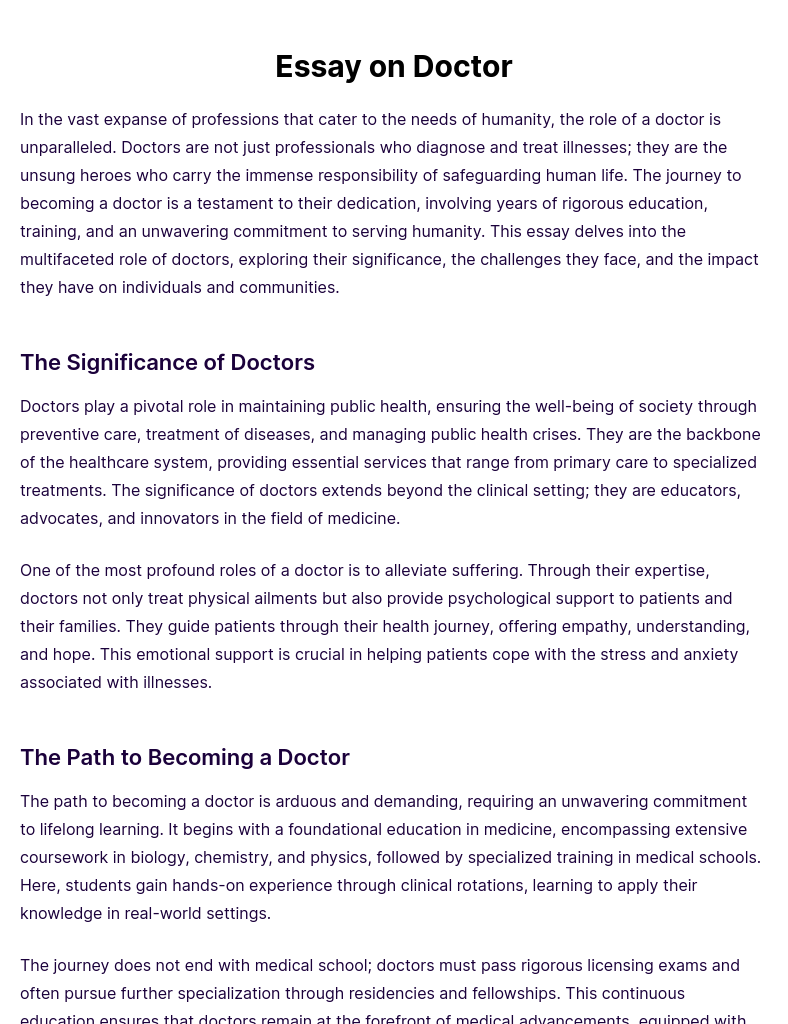
Essay on Doctor
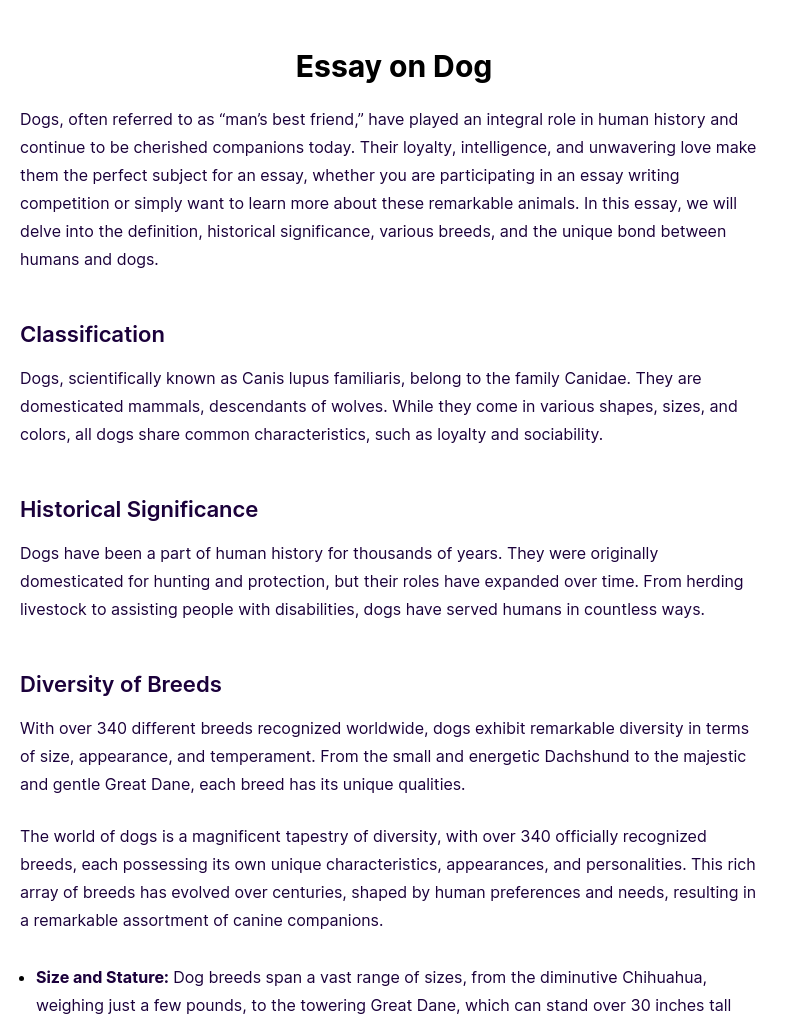
Essay on Dog
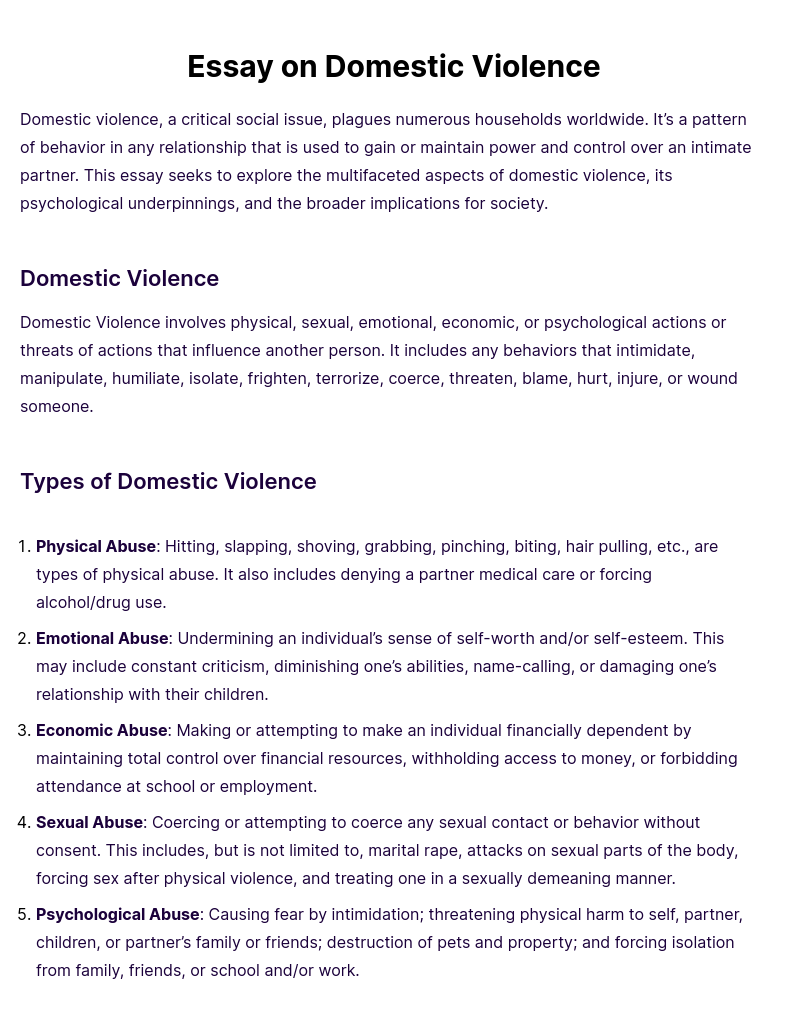
Essay on Domestic Violence
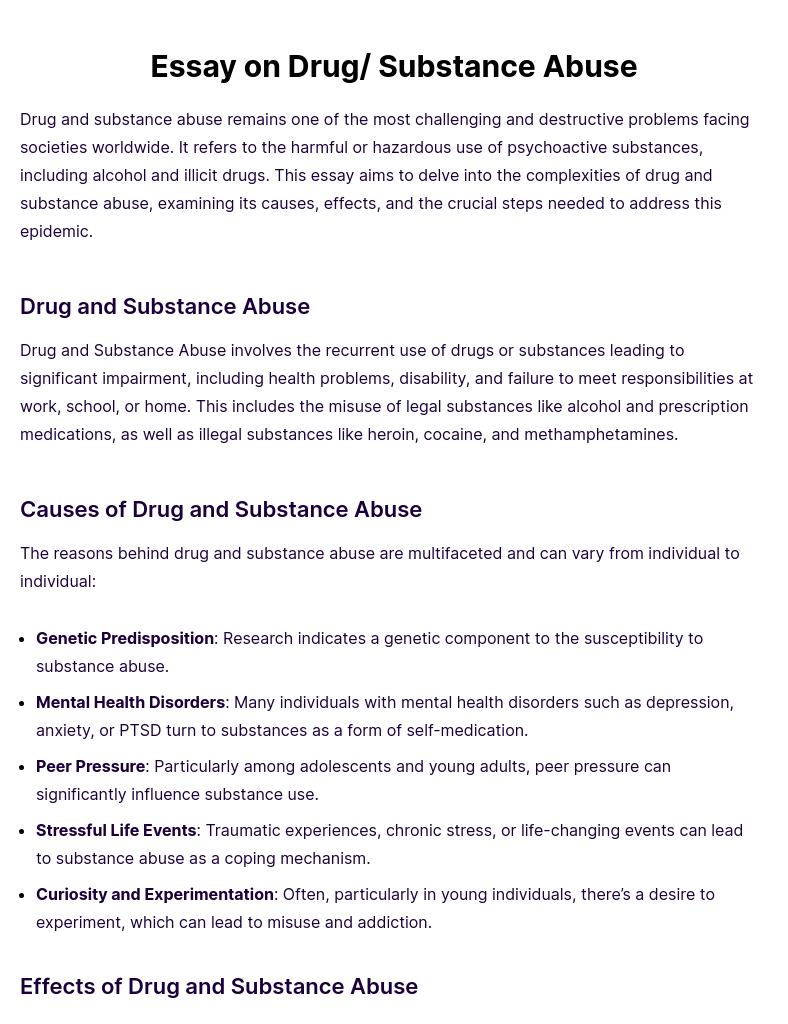
Essay on Drug/ Substance Abuse
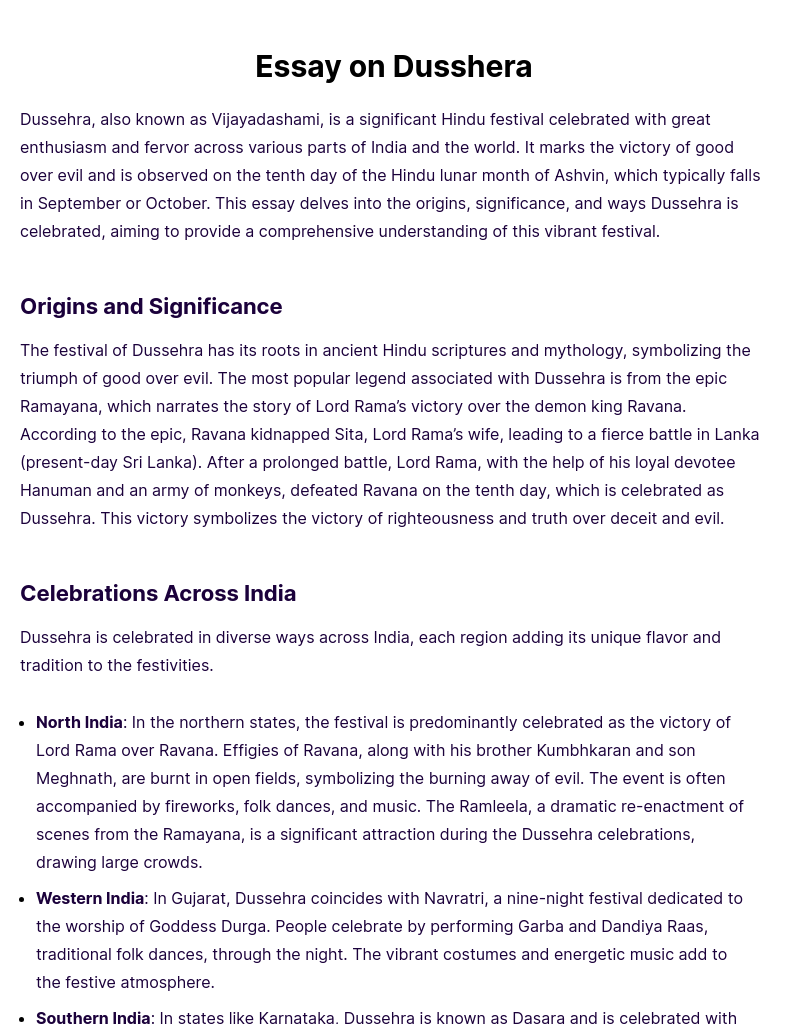
Essay on Dusshera
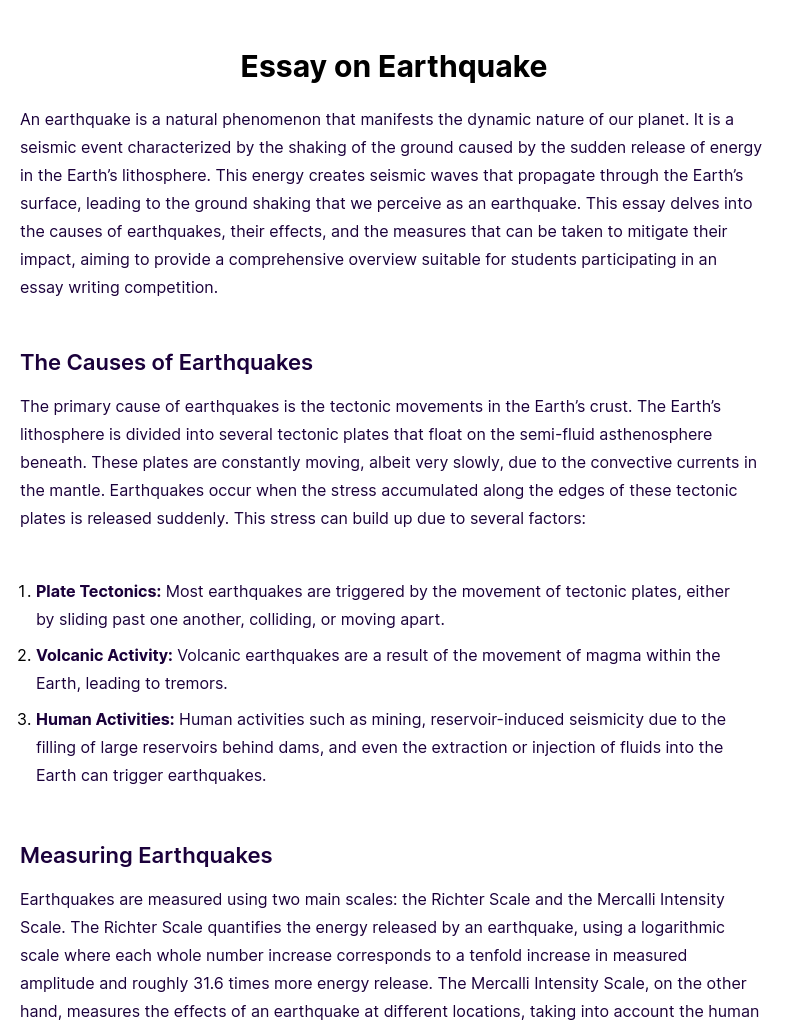
Essay on Earthquake
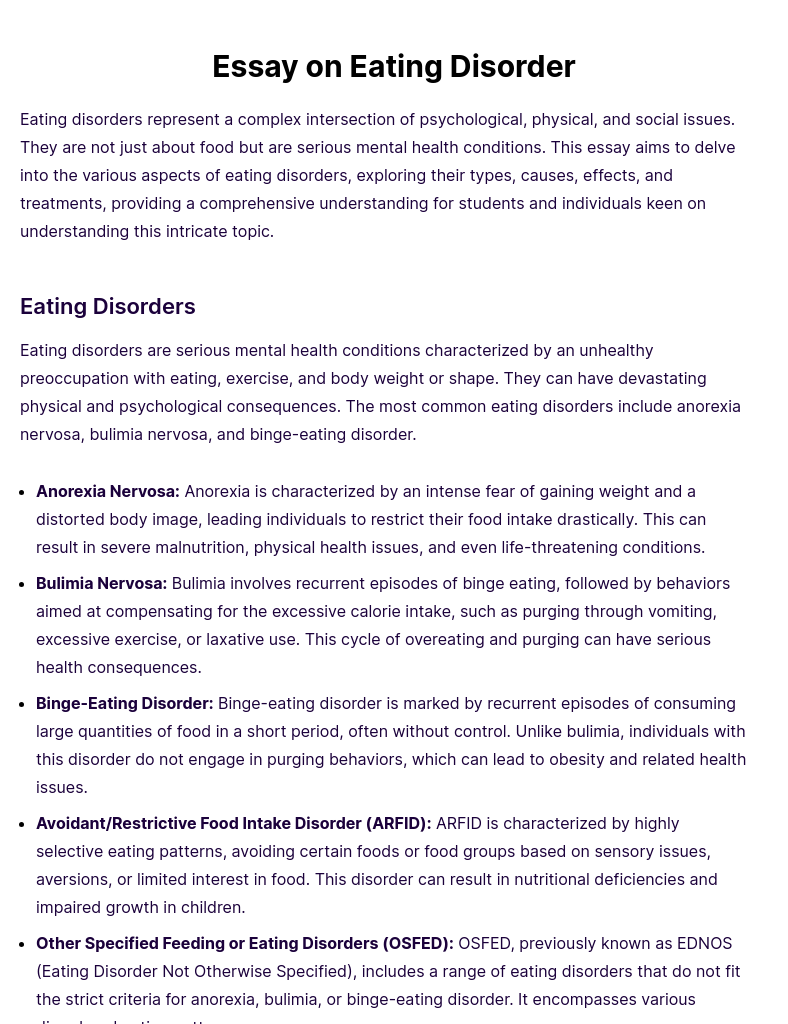
Essay on Eating Disorder
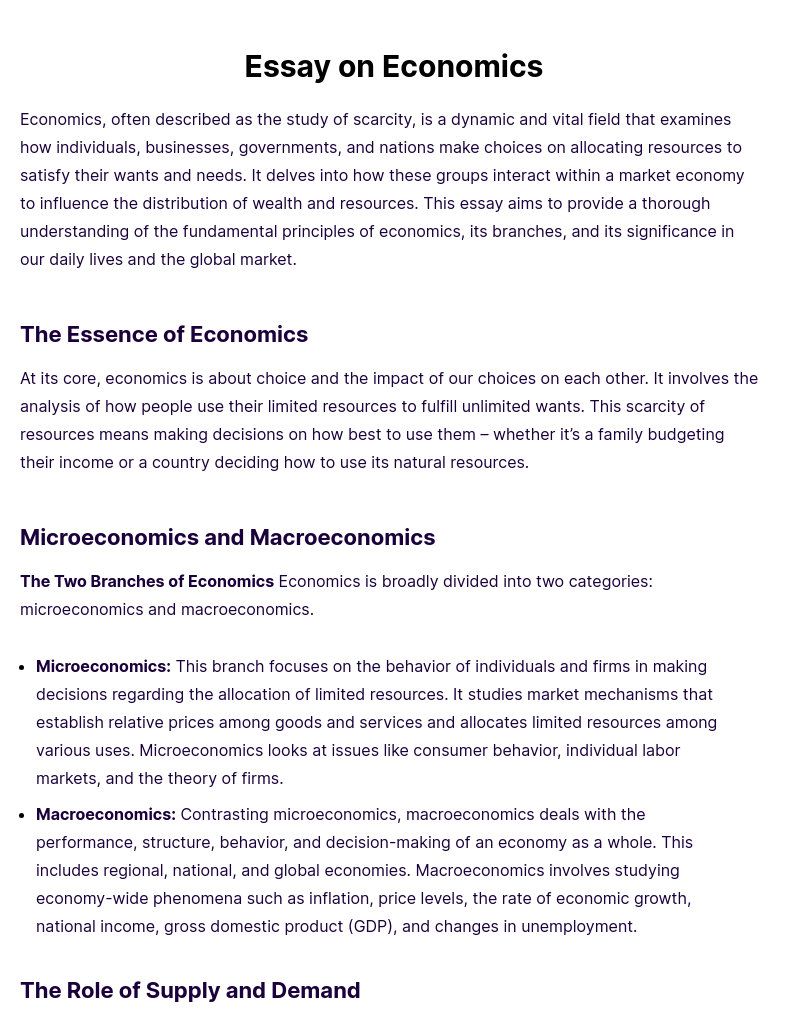
Essay on Economics
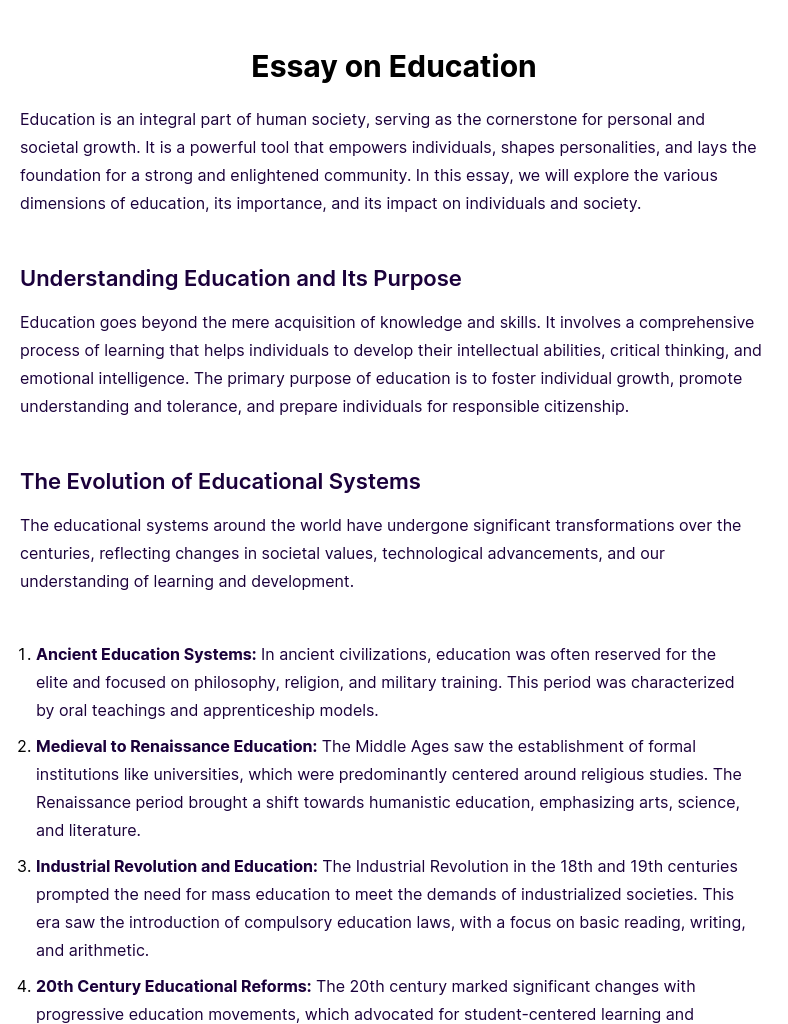
Essay on Education
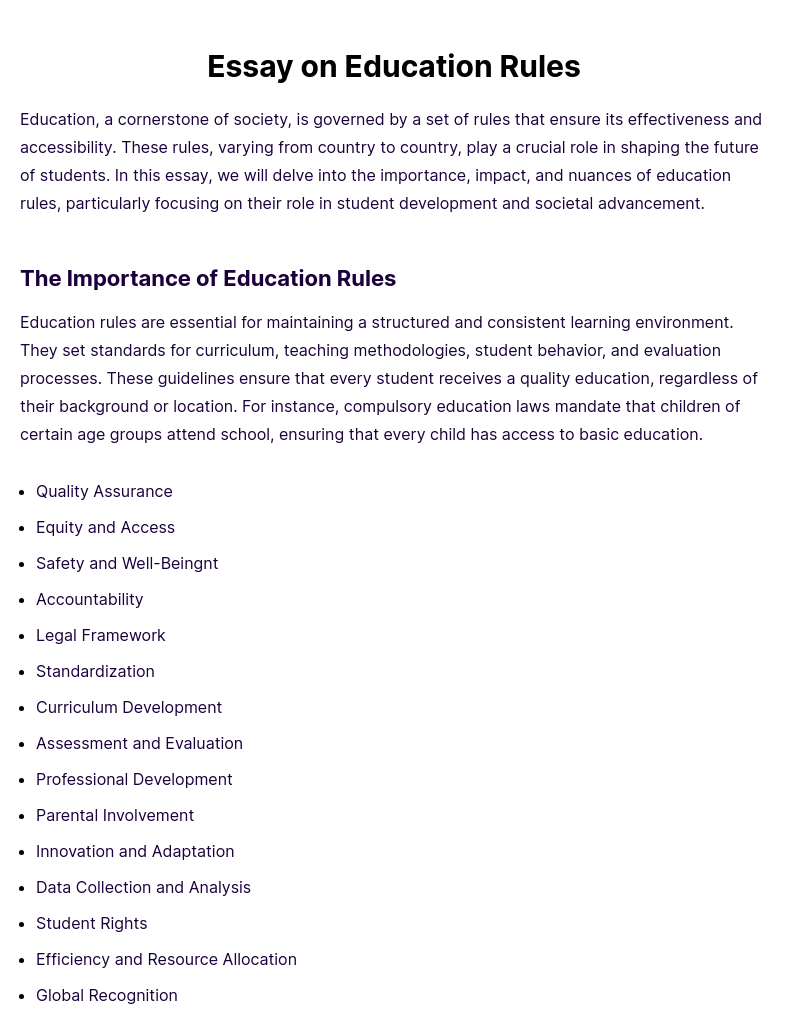
Essay on Education Rules

Essay on Elephant
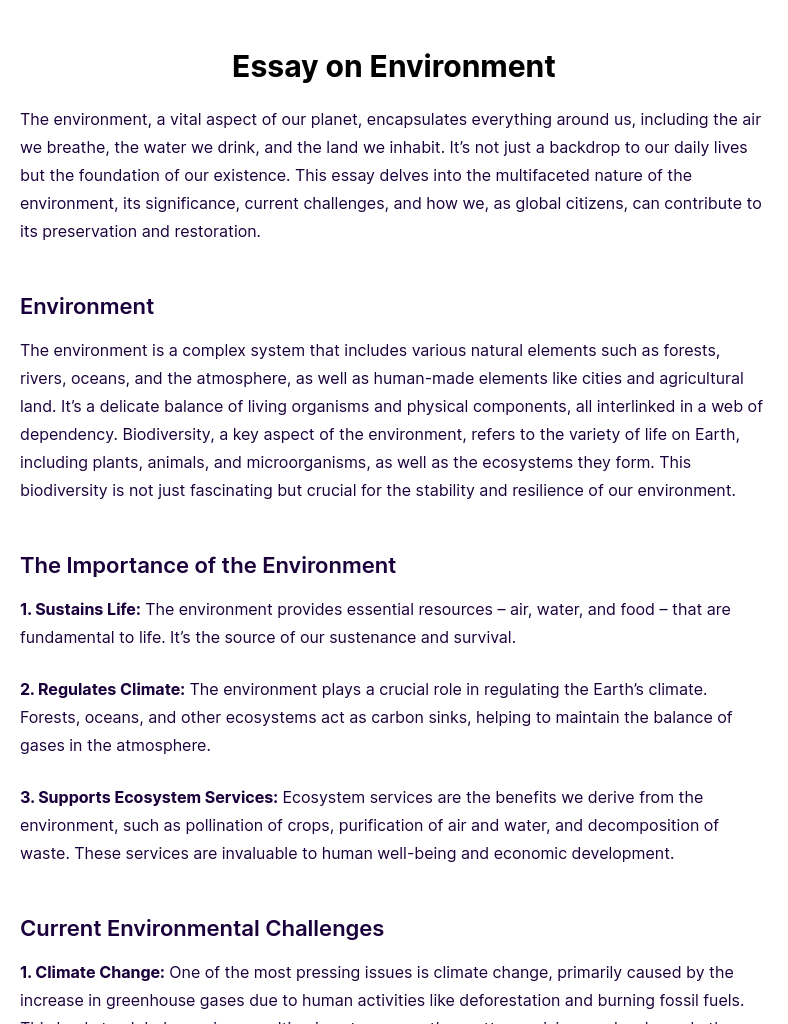
Essay on Environment
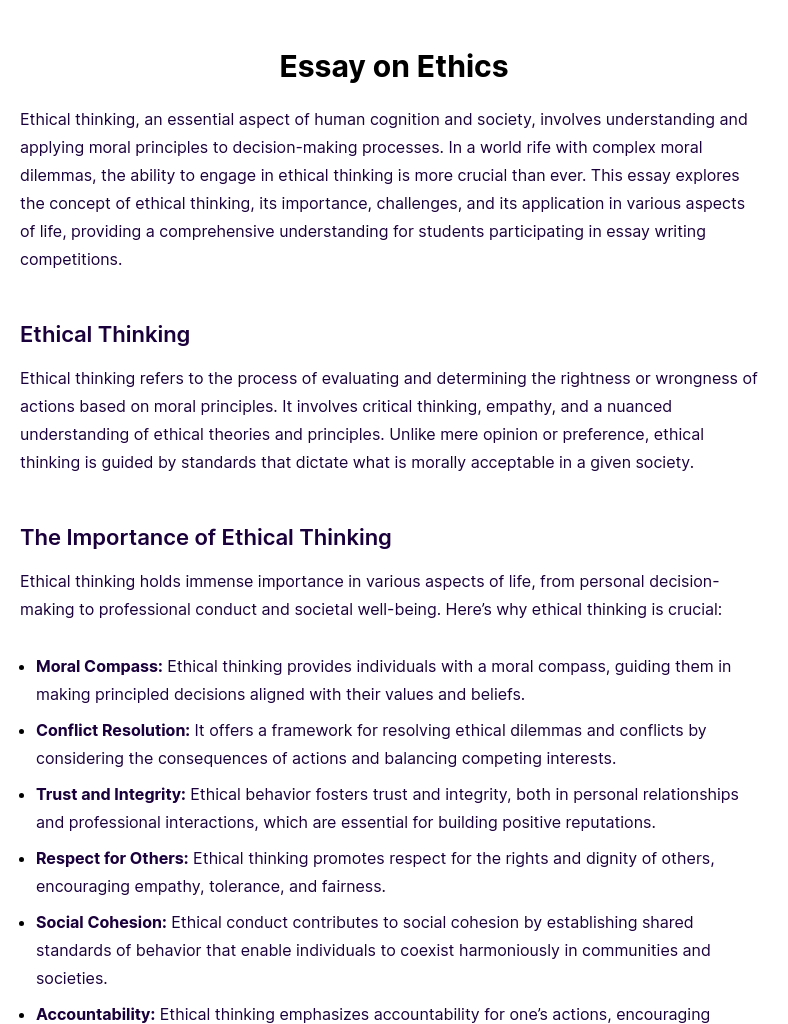
Essay on Ethics
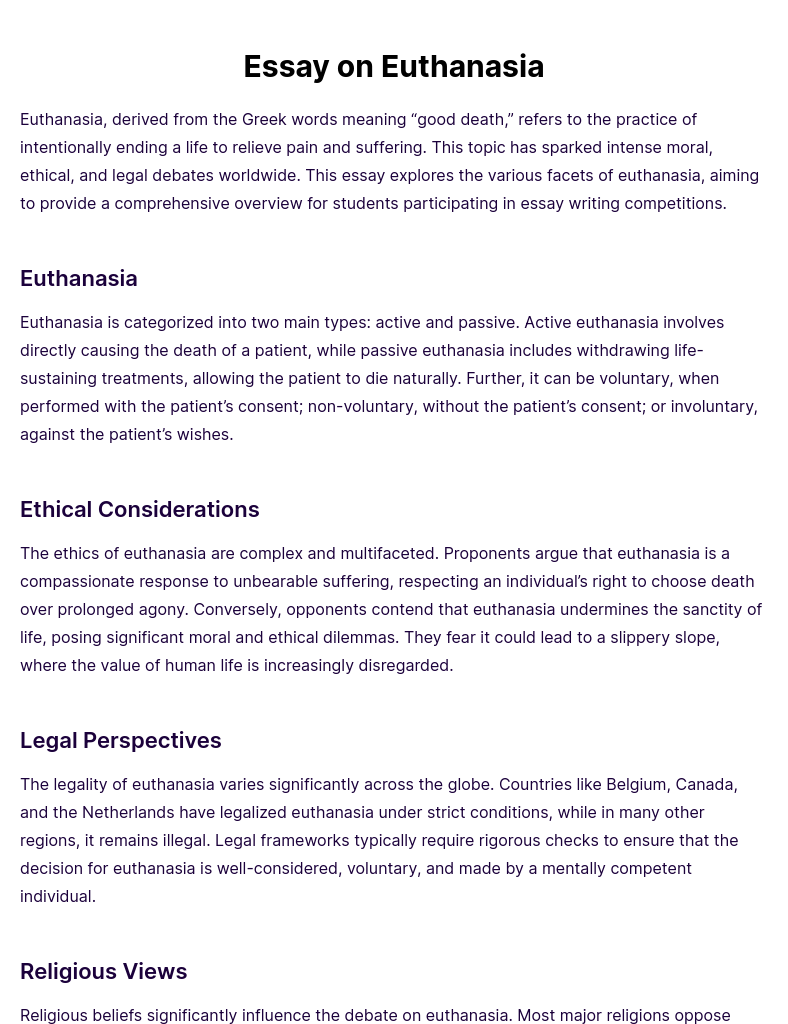
Essay on Euthanasia
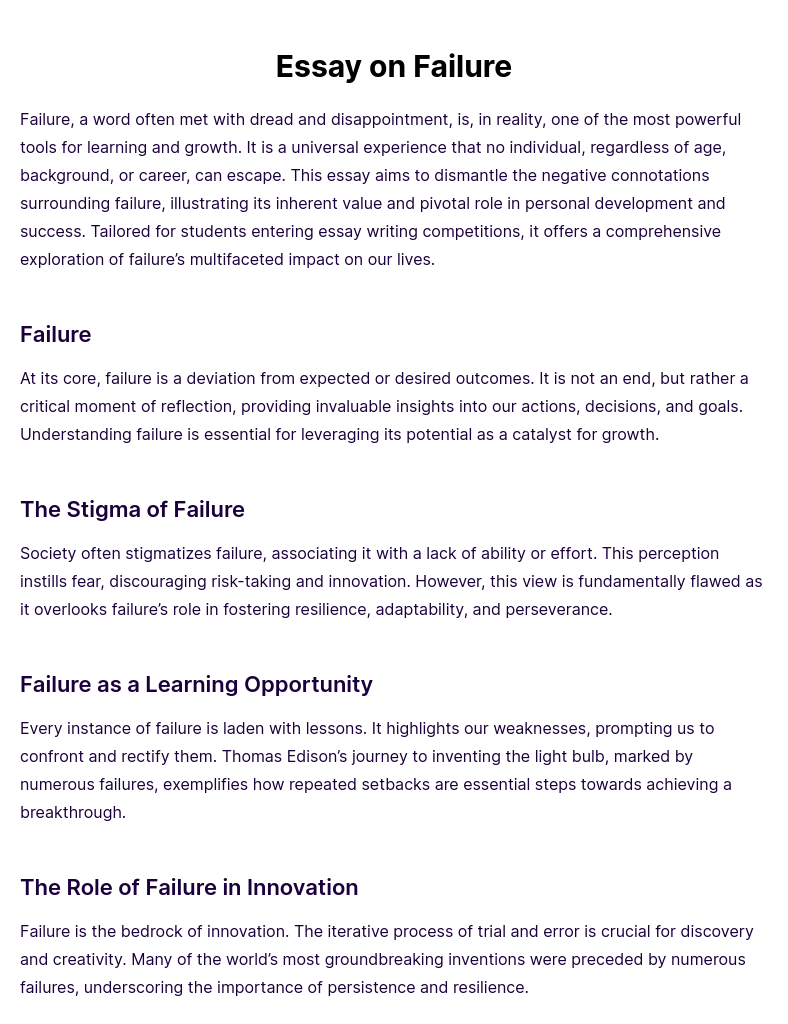
Essay on Failure
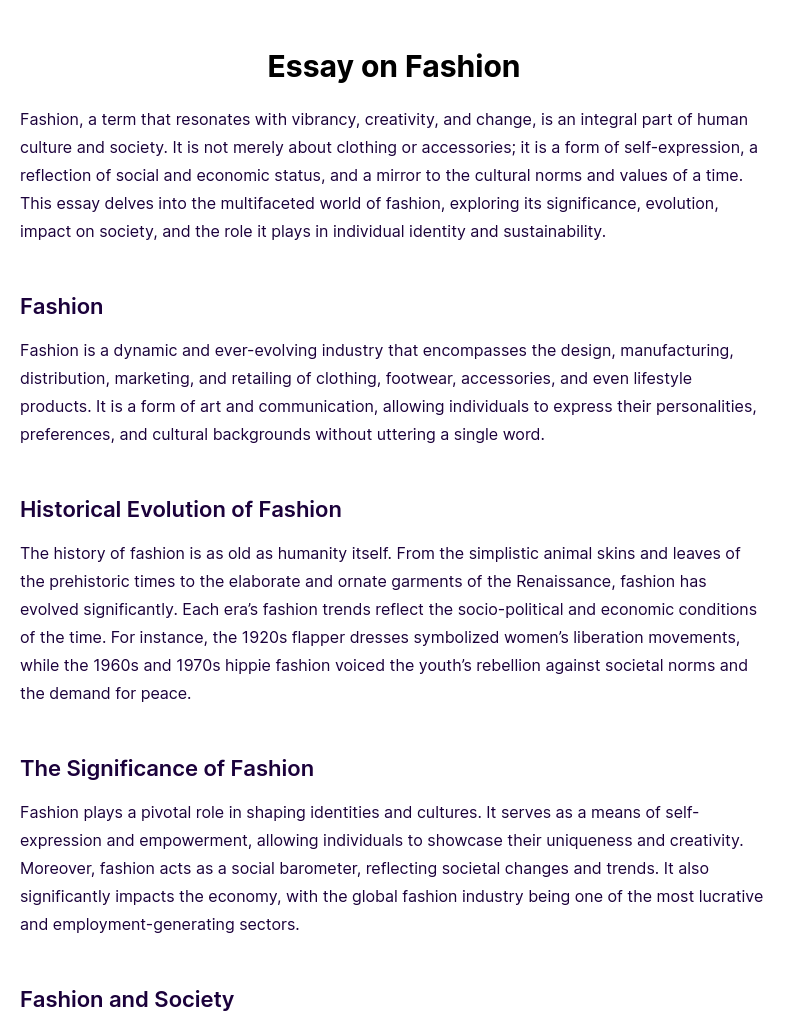
Essay on Fashion
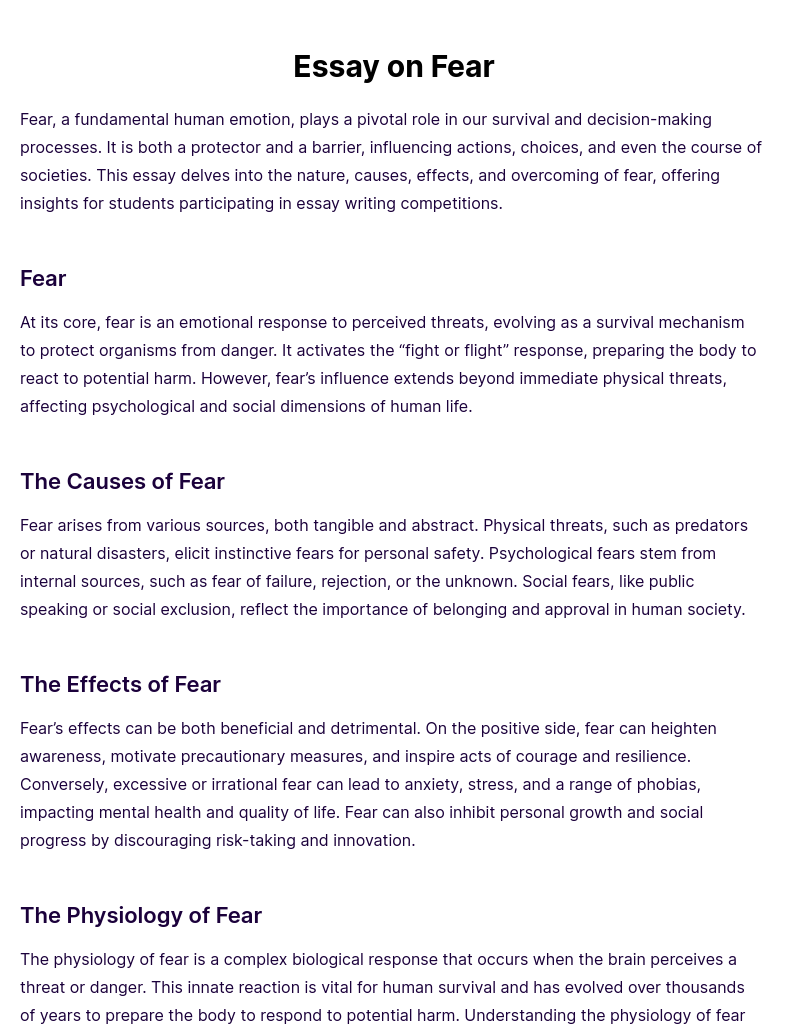
Essay on Fear
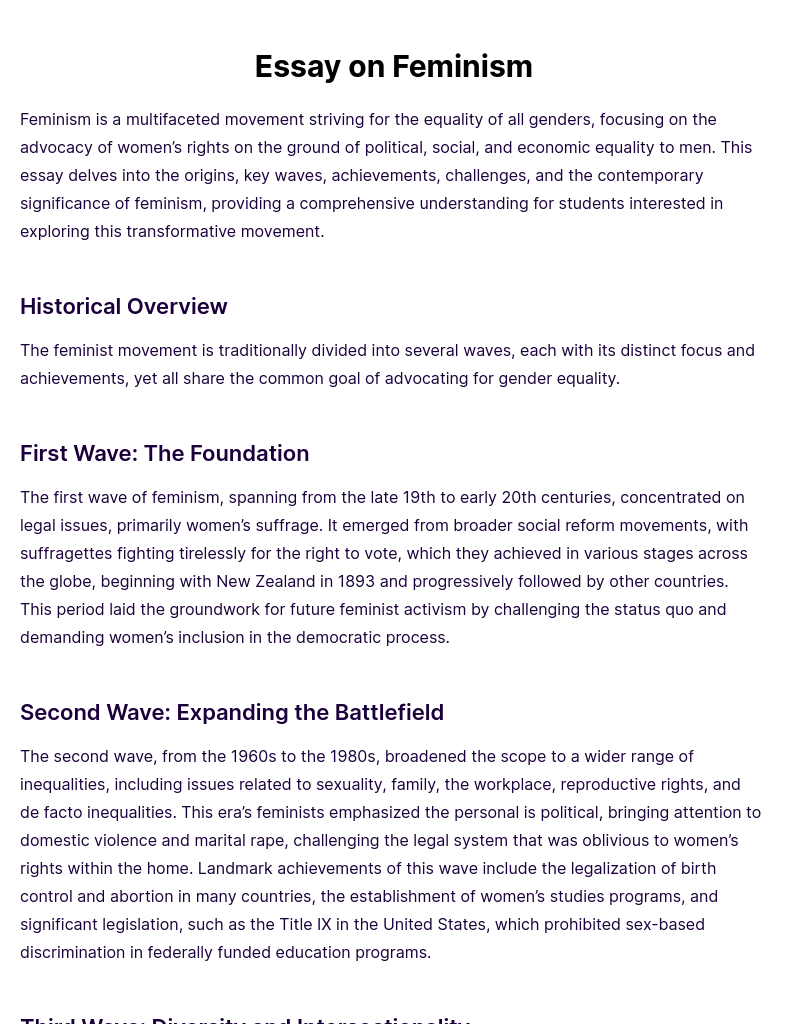
Essay on Feminism

Essay on Floods

Essay on Food
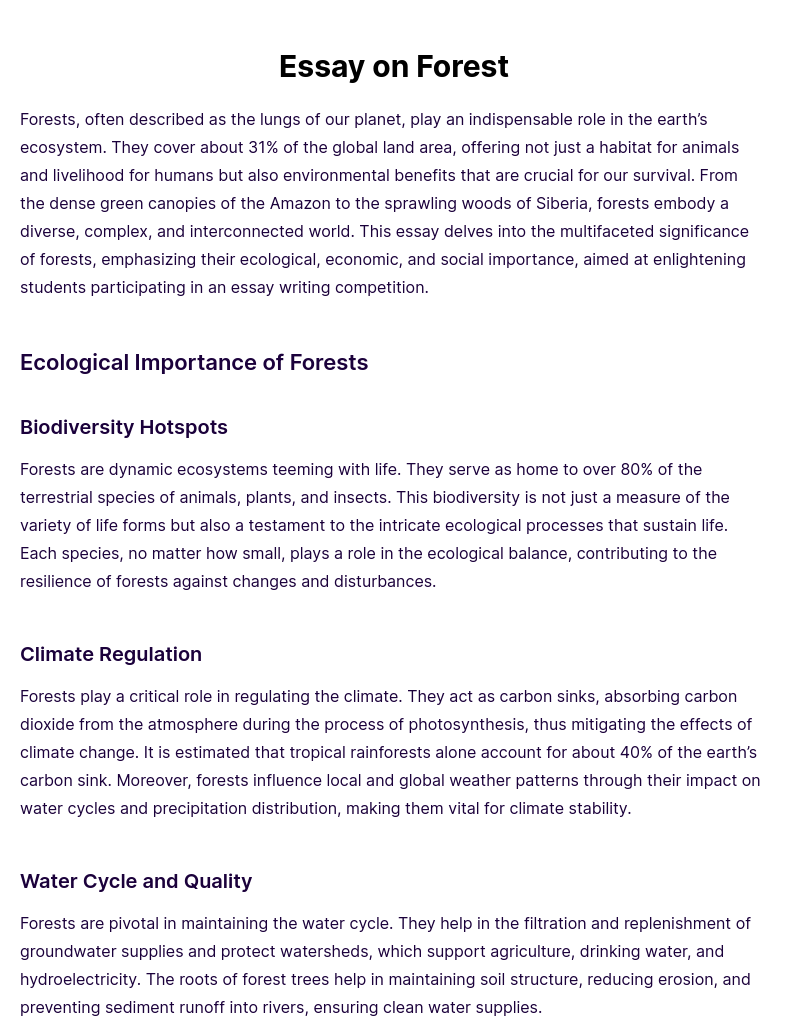
Essay on Forest
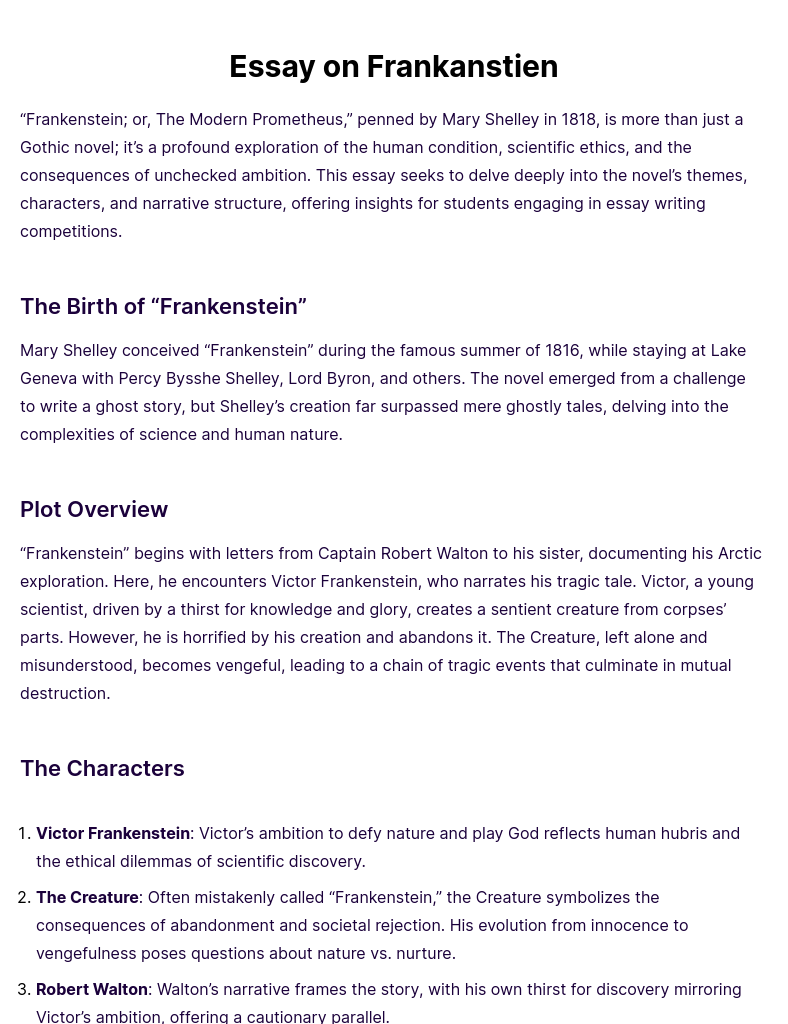
Essay on Frankanstien
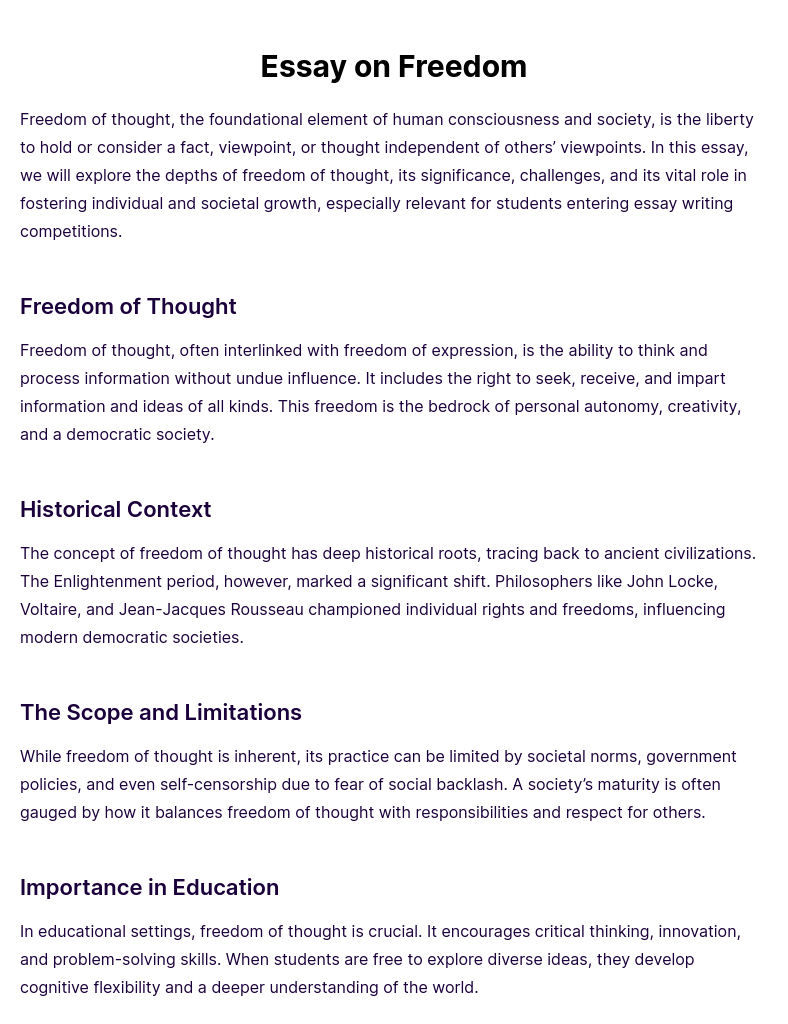
Essay on Freedom
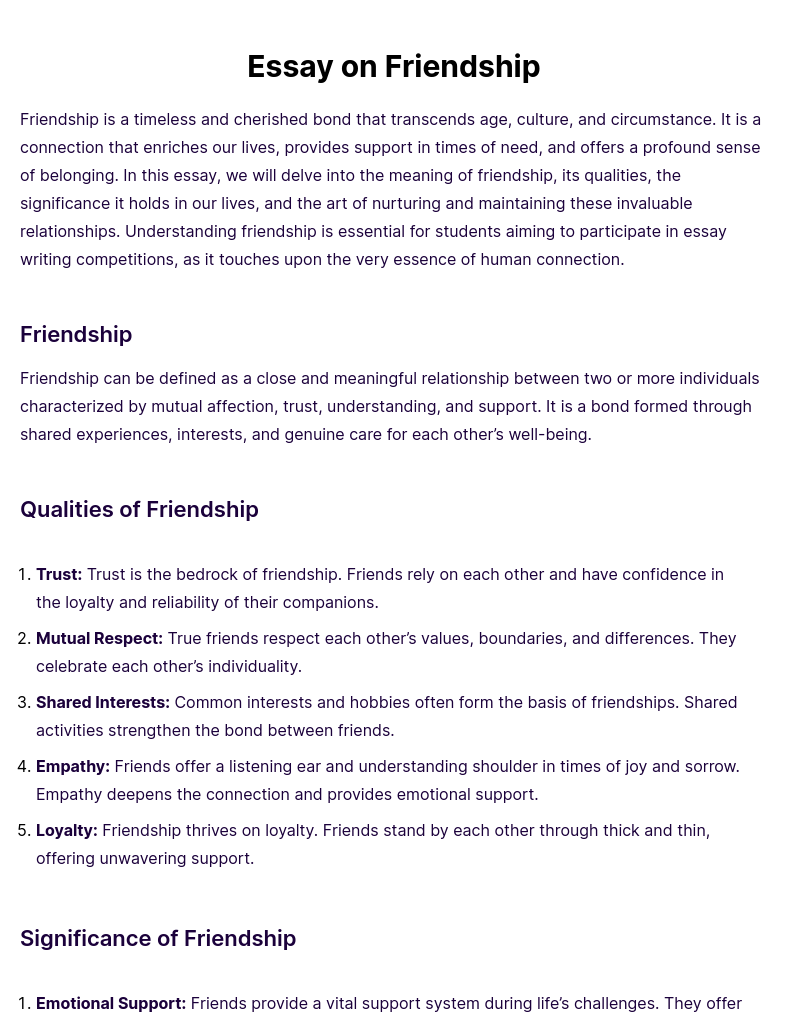
Essay on Friendship

Essay on Gender Inequality

Essay on General Rules
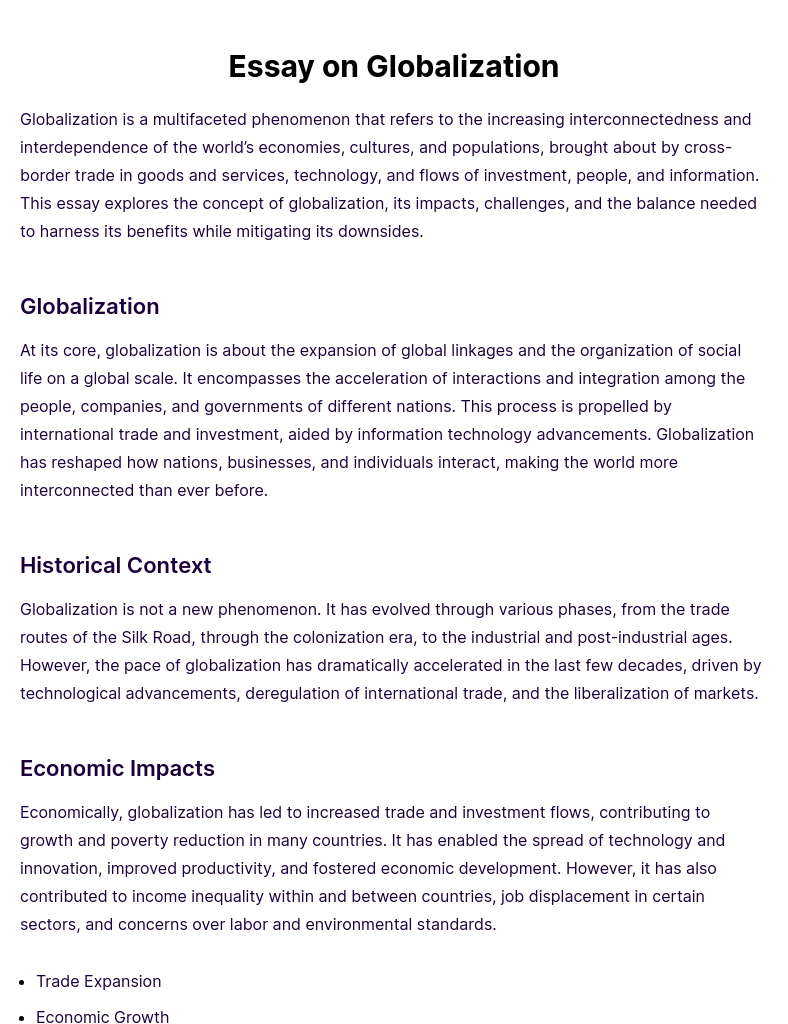
Essay on Globalization
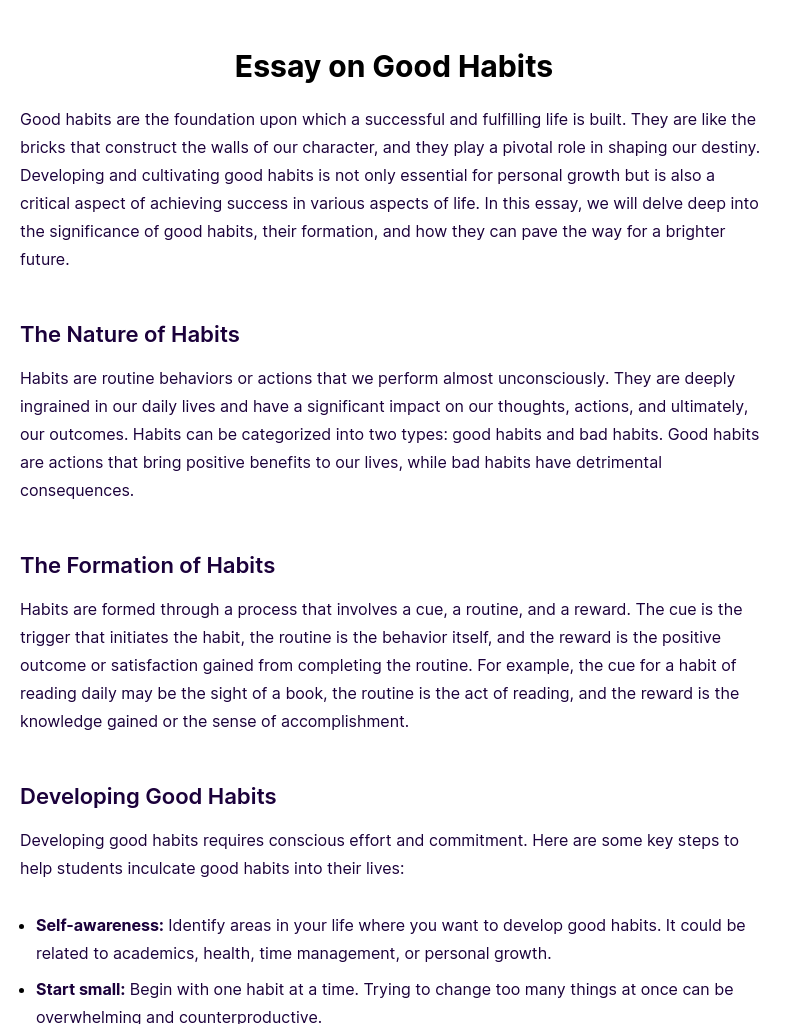
Essay on Good Habits
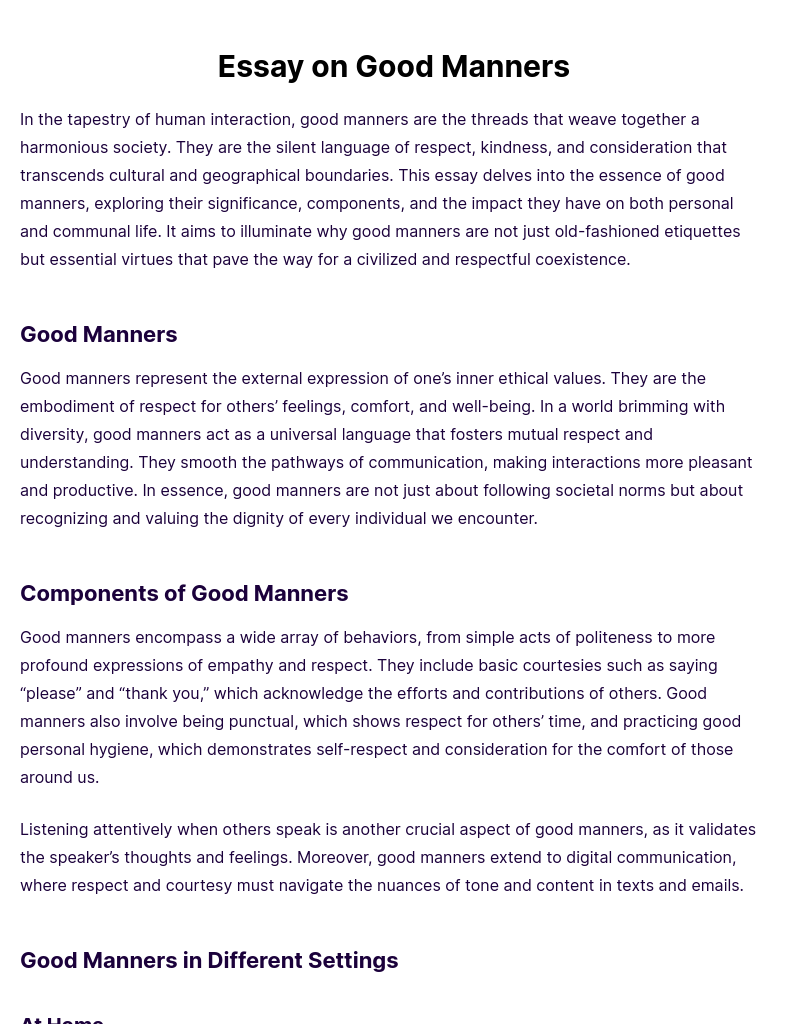
Essay on Good Manners

Essay on Grandparents

Essay on Great Gatsby
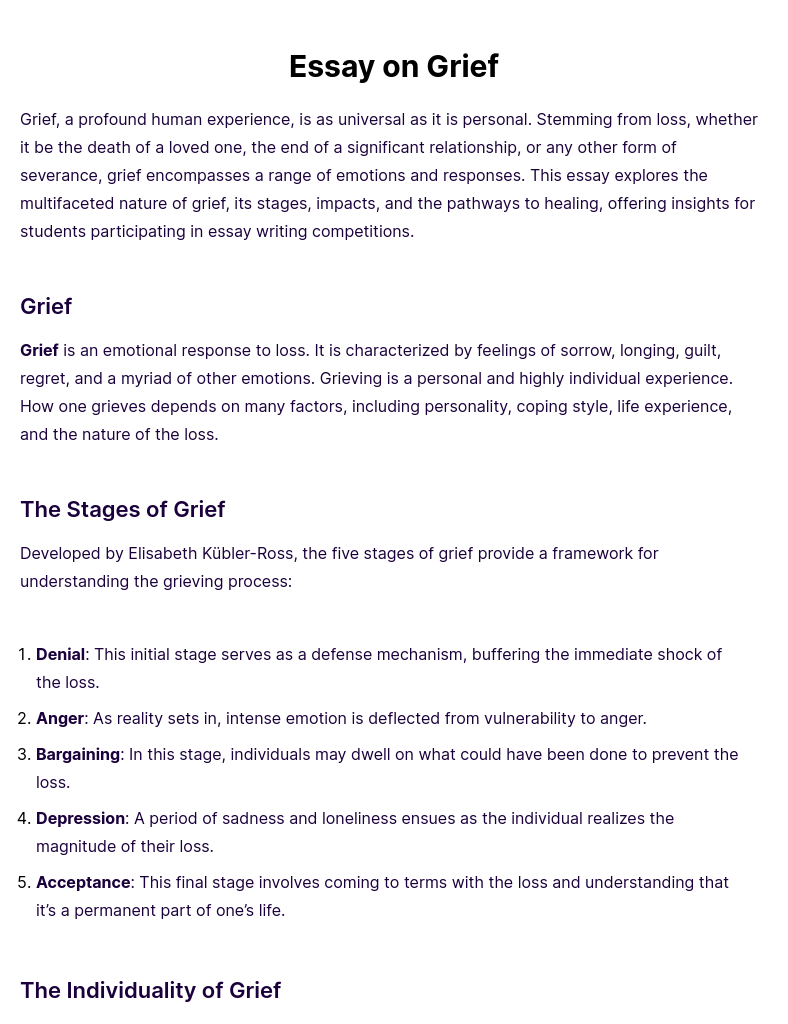
Essay on Grief
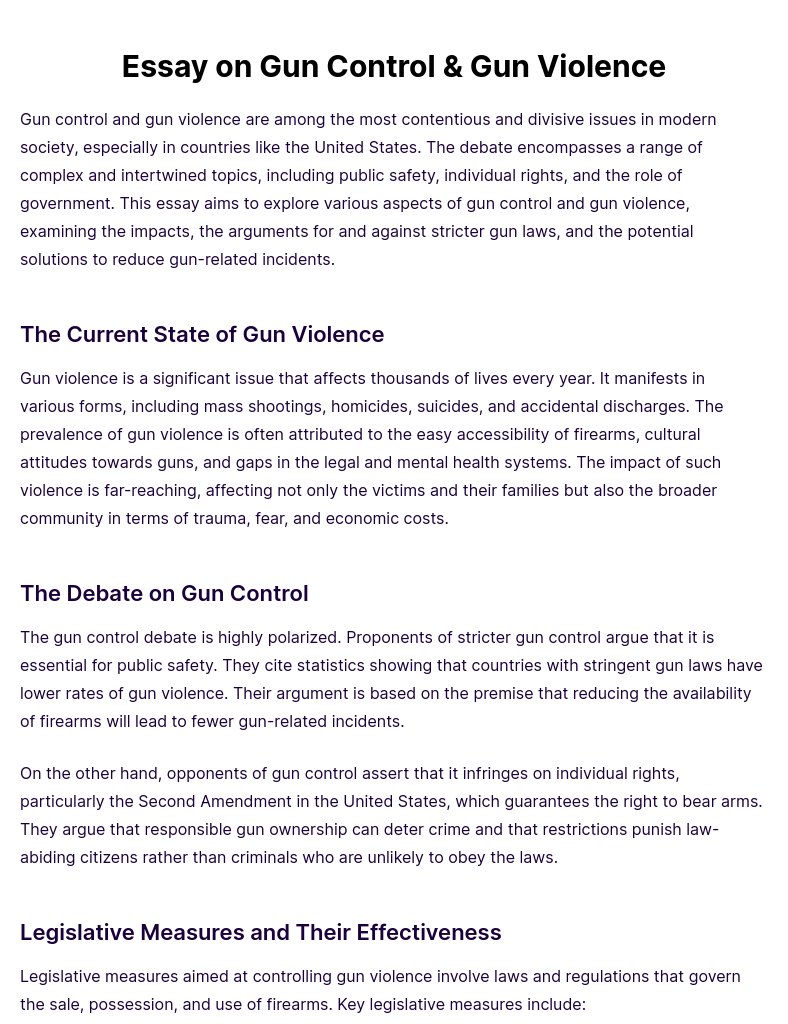
Essay on Gun Control & Gun Violence
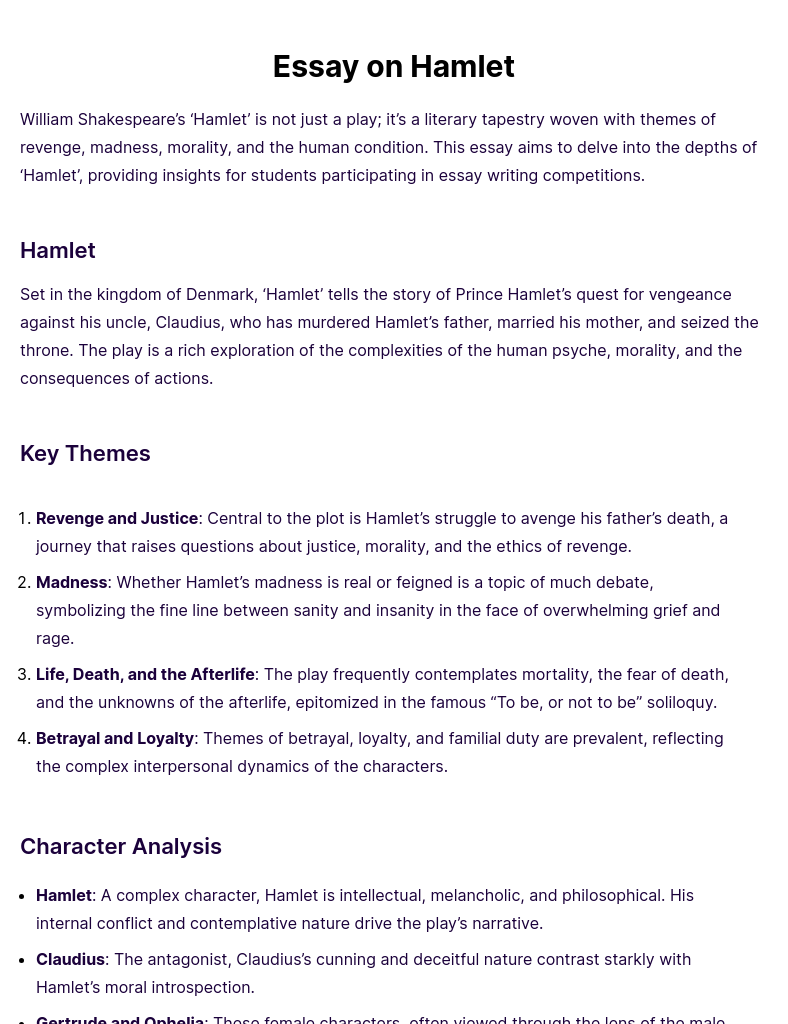
Essay on Hamlet
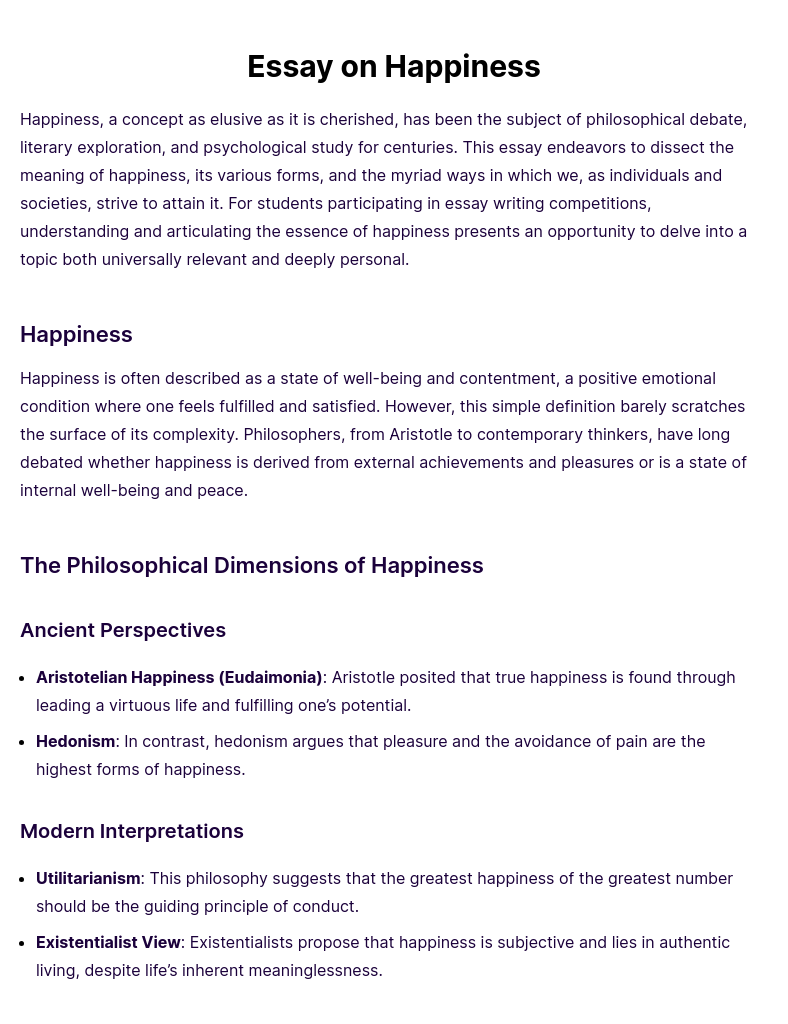
Essay on Happiness
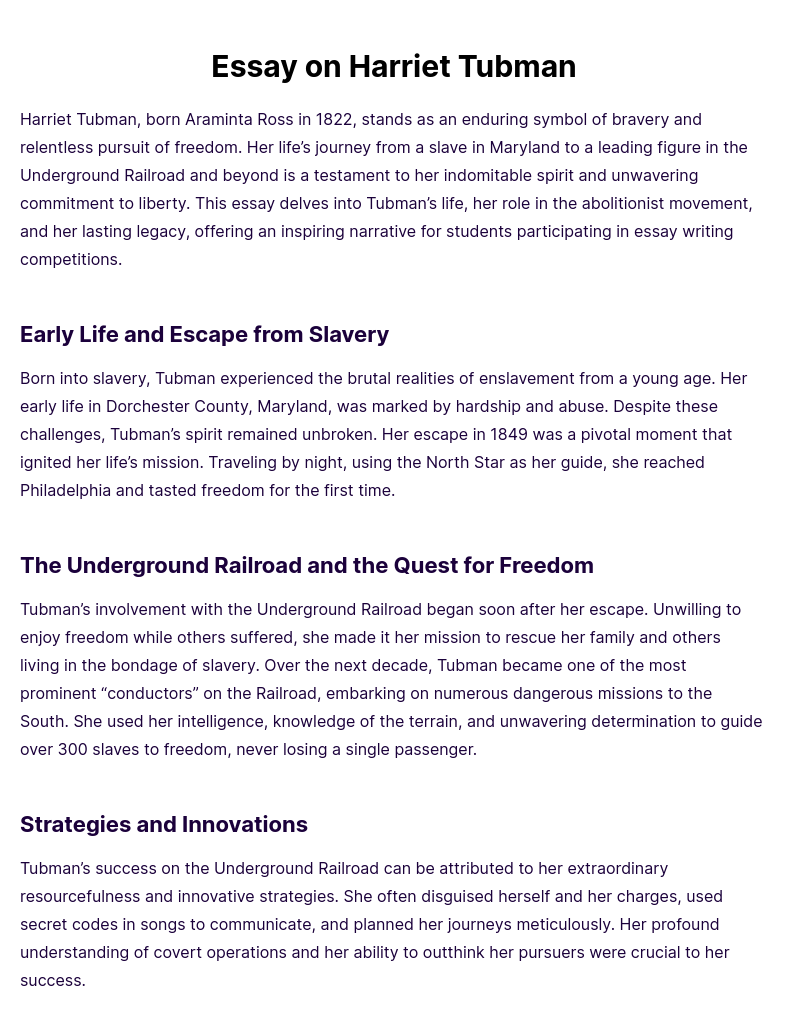
Essay on Harriet Tubman
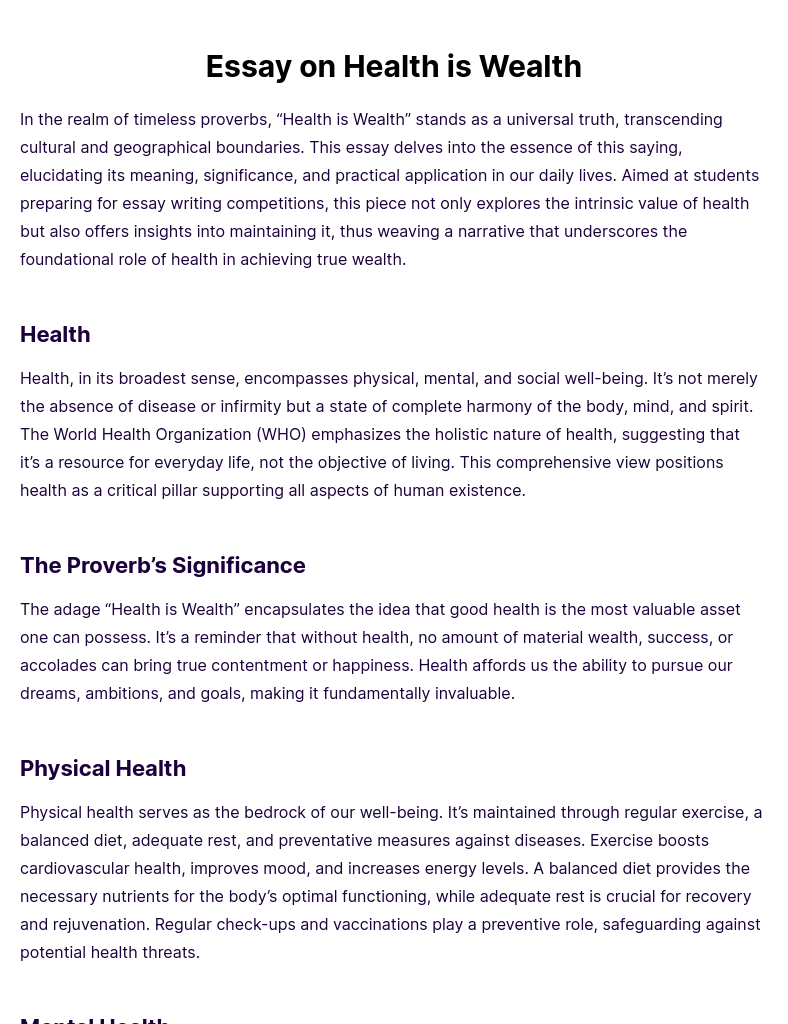
Essay on Health is Wealth
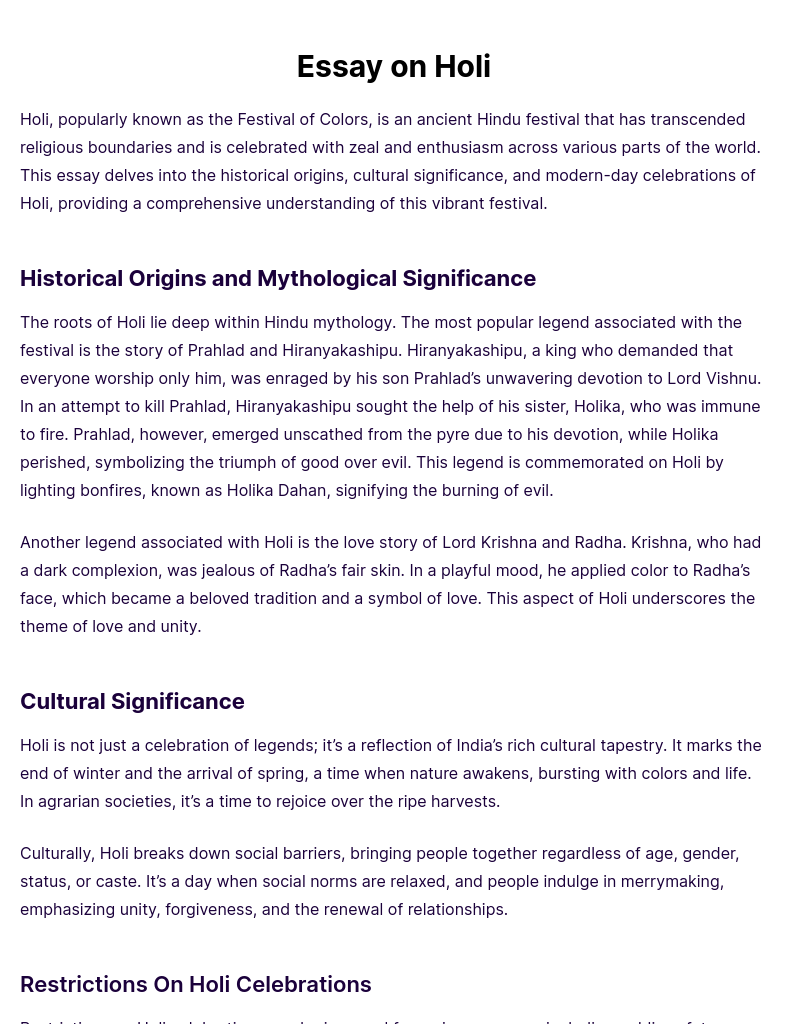
Essay on Holi
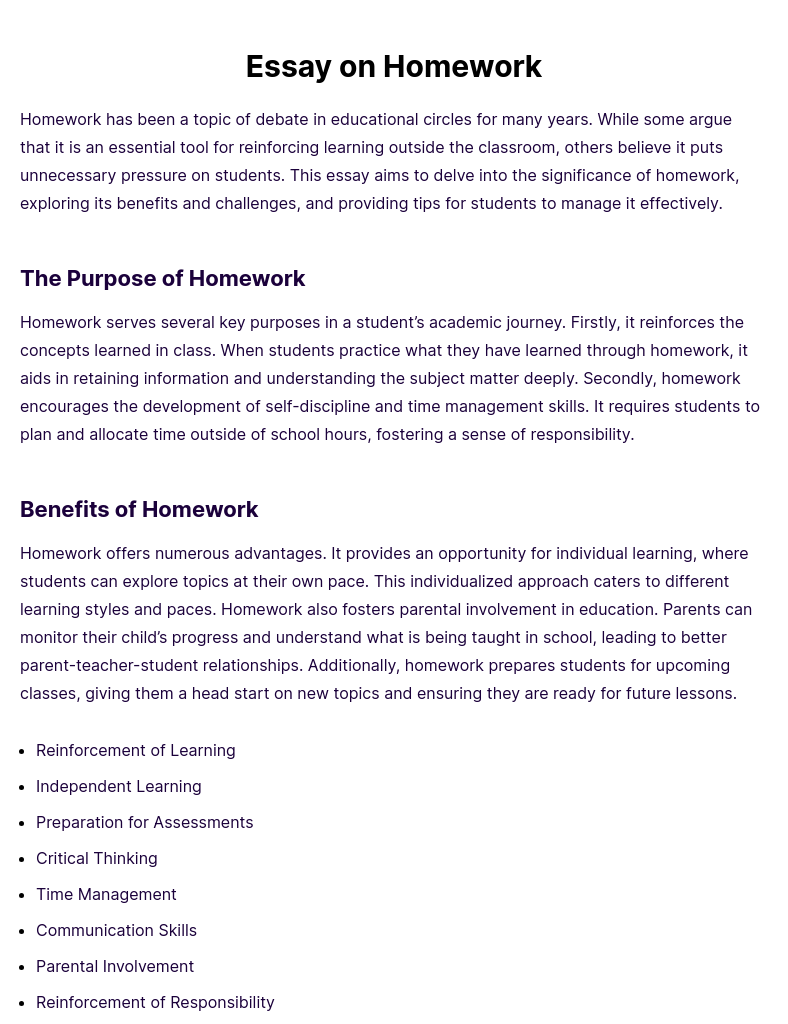
Essay on Homework
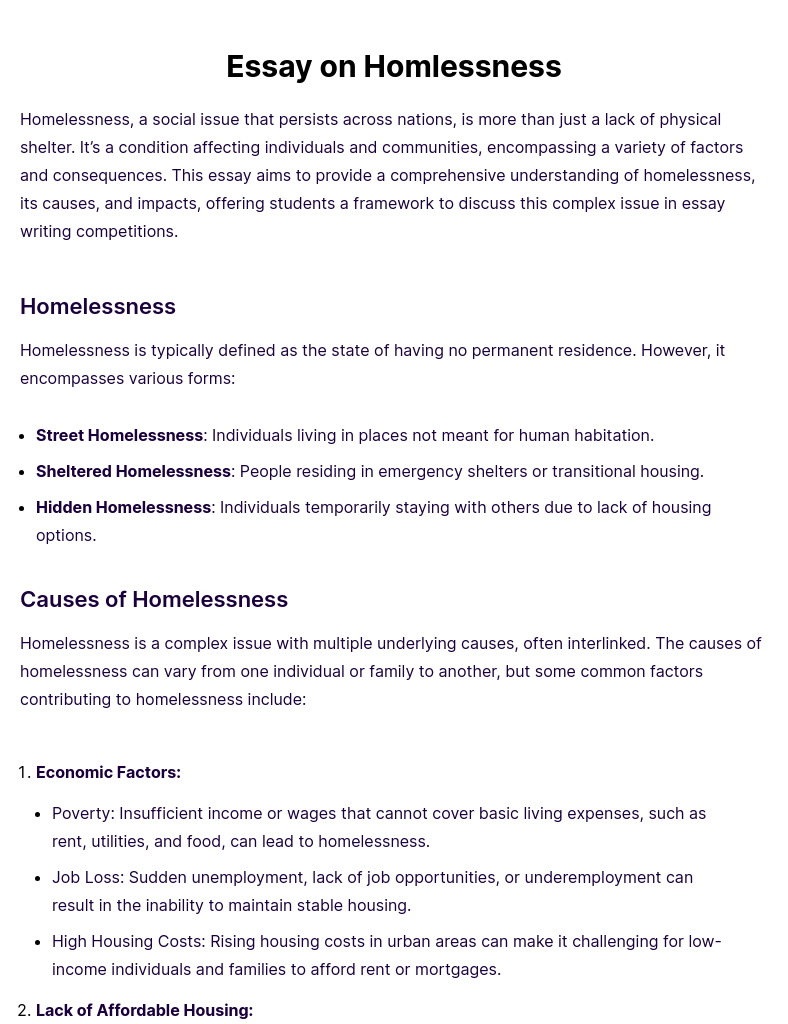
Essay on Homlessness
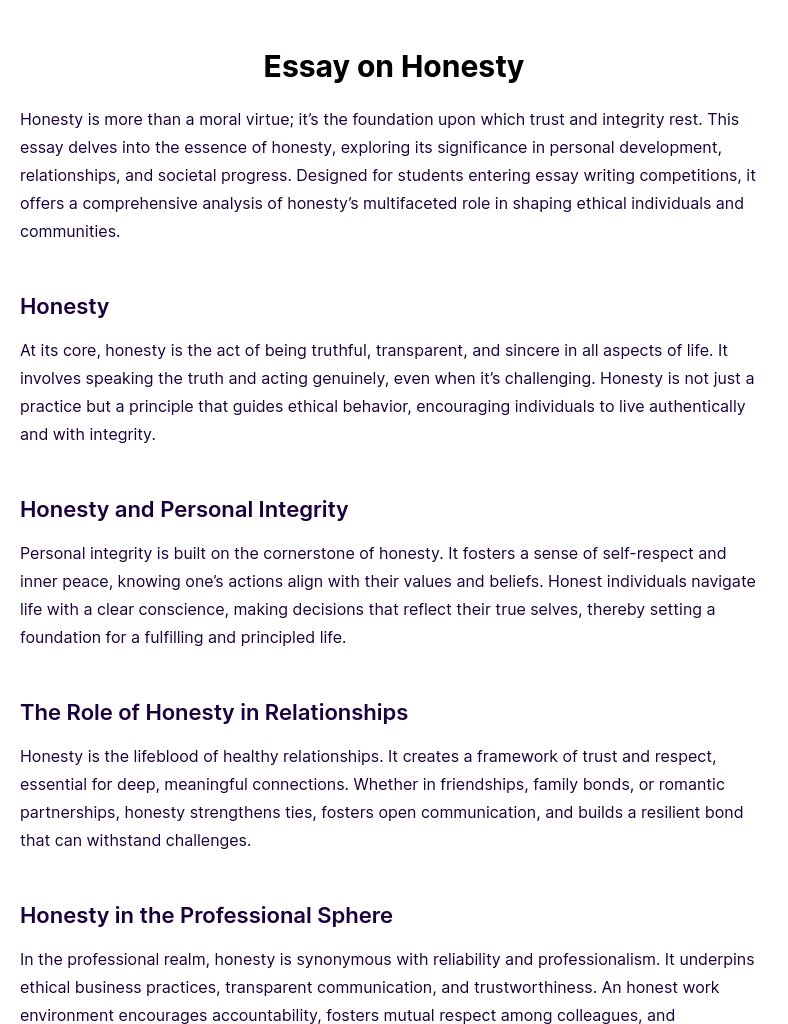
Essay on Honesty
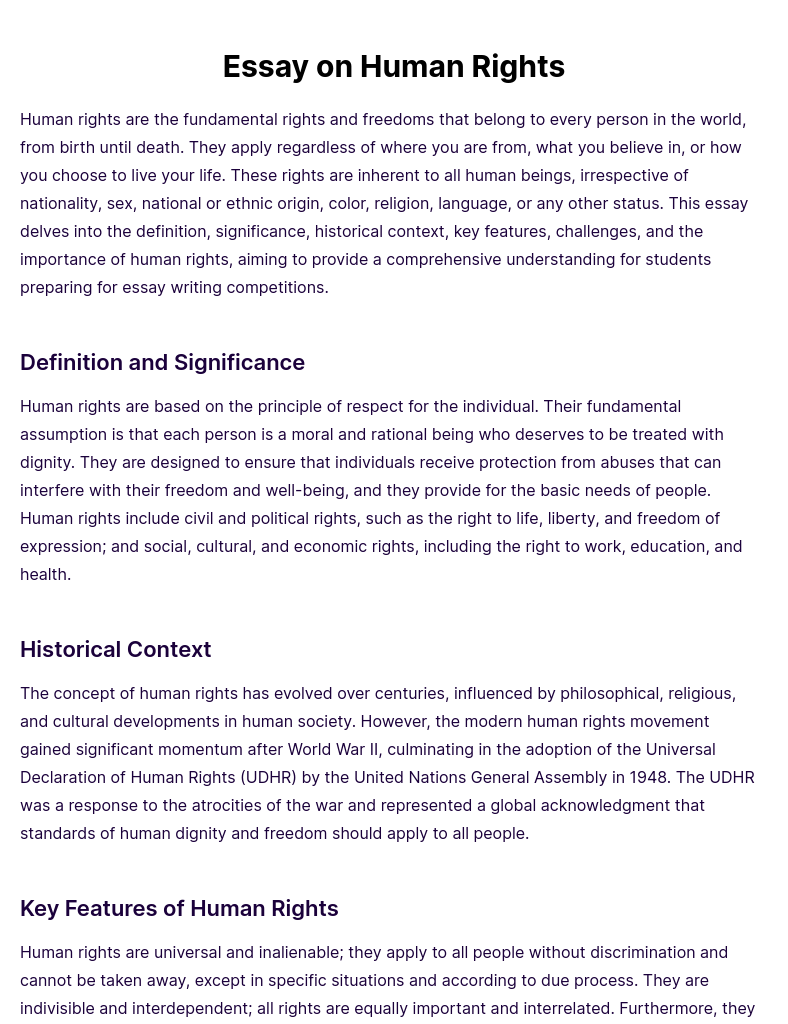
Essay on Human Rights
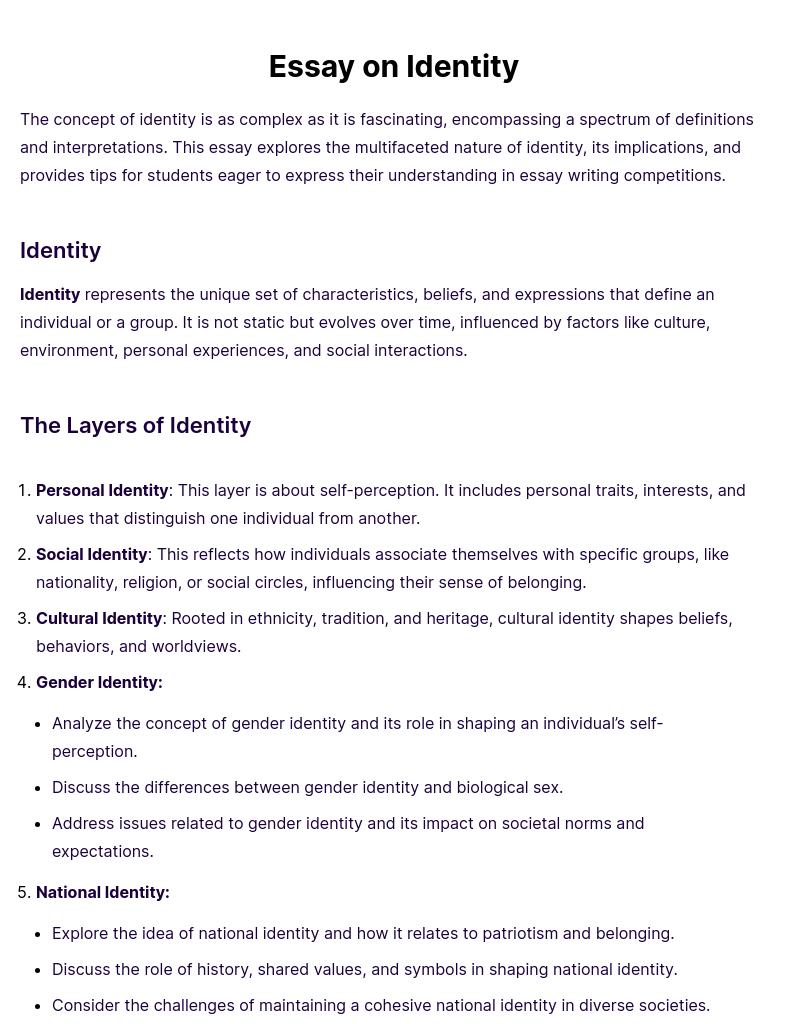
Essay on Identity
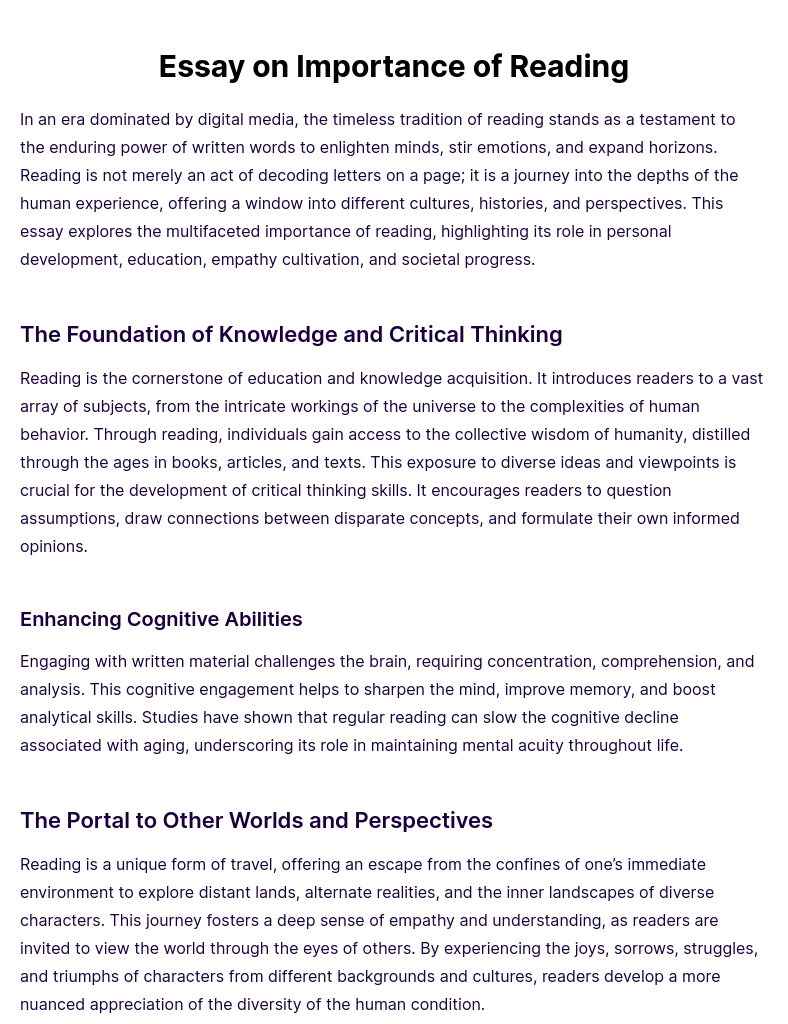
Essay on Importance of Reading
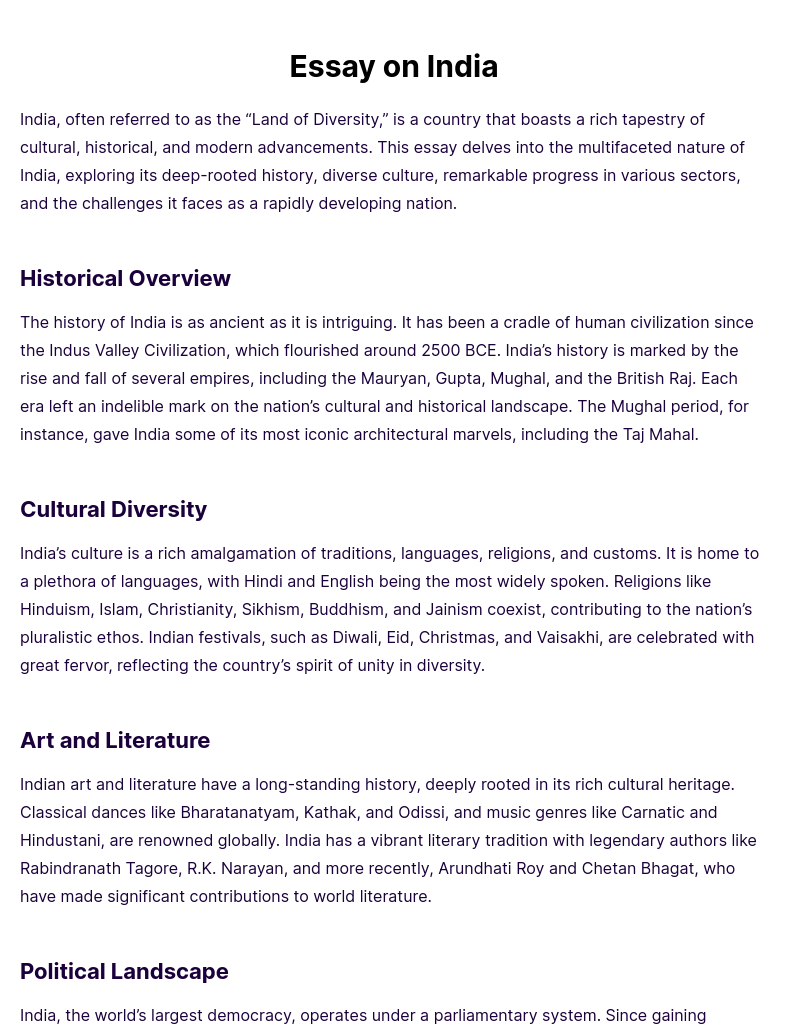
Essay on India
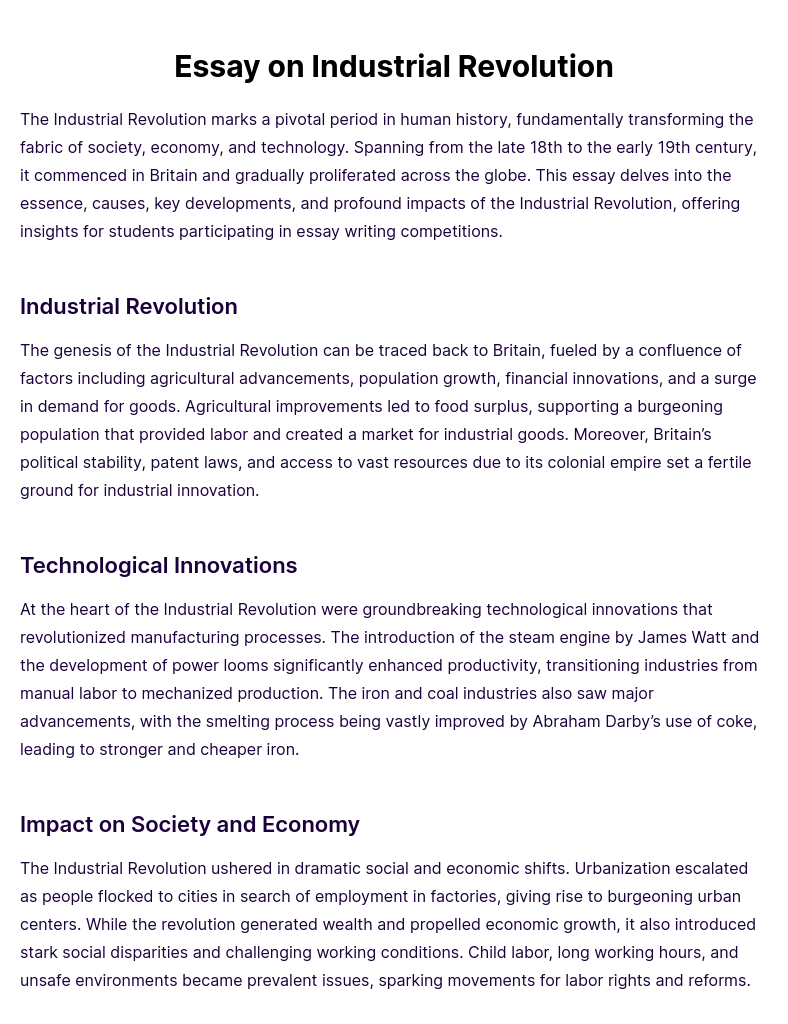
Essay on Industrial Revolution
RSC Advances
Acoustic levitation combined with laboratory-based small-angle x-ray scattering (saxs) to probe changes in crystallinity and molecular organisation.

* Corresponding authors
a School of Geography, Earth and Environmental Sciences, University of Birmingham, Edgbaston, Birmingham, UK E-mail: [email protected]
b Department of Chemistry, University of Bath, South Building, Soldier Down Ln, Claverton Down, Bath, UK
c Diamond Light Source, Diamond House, Harwell Science and Innovation Campus, Didcot, UK
d Department of Meteorology, University of Reading, Whiteknights, Earley Gate, Reading, UK
Single particle levitation techniques allow us to probe samples in a contactless way, negating the effect that surfaces could have on processes such as crystallisation and phase transitions. Small-angle X-ray scattering (SAXS) is a common method characterising the nanoscale order in aggregates such as colloidal, crystalline and liquid crystalline systems. Here, we present a laboratory-based small-angle X-ray scattering (SAXS) setup combined with acoustic levitation. The capability of this technique is highlighted and compared with synchrotron-based levitation-SAXS and X-ray diffraction. We were able to follow the deliquescence and crystallisation of sucrose, a commonly used compound for the study of viscous atmospheric aerosols. The observed increased rate of the deliquescence–crystallisation transitions on repeated cycling could suggest the formation of a glassy sucrose phase. We also followed a reversible phase transition in an oleic acid-based lyotropic liquid crystal system under controlled humidity changes. Our results demonstrate that the coupling of acoustic levitation with an offline SAXS instrument is feasible, and that the time resolution and data quality are sufficient to draw physically meaningful conclusions. There is a wide range of potential applications including topics such as atmospheric aerosol chemistry, materials science, crystallisation and aerosol spray drying.

Article information
Download Citation
Permissions.
A. Milsom, A. M. Squires, J. Macklin, P. Wady and C. Pfrang, RSC Adv. , 2024, 14 , 17519 DOI: 10.1039/D4RA01418A
This article is licensed under a Creative Commons Attribution 3.0 Unported Licence . You can use material from this article in other publications without requesting further permissions from the RSC, provided that the correct acknowledgement is given.
Read more about how to correctly acknowledge RSC content .
Social activity
Search articles by author, advertisements.
Physical Review Letters
- Collections
- Editorial Team
Biorthogonal Dynamical Quantum Phase Transitions in Non-Hermitian Systems
Yecheng jing, jian-jun dong, yu-yu zhang, and zi-xiang hu, phys. rev. lett. 132 , 220402 – published 29 may 2024.
- No Citing Articles
- Supplemental Material
By utilizing biorthogonal bases, we develop a comprehensive framework for studying biorthogonal dynamical quantum phase transitions in non-Hermitian systems. With the help of the previously overlooked associated state, we define the automatically normalized biorthogonal Loschmidt echo. This approach is capable of handling arbitrary non-Hermitian systems with complex eigenvalues and naturally eliminates the negative value of Loschmidt rate obtained without the biorthogonal bases. Taking the non-Hermitian Su-Schrieffer-Heeger model as a concrete example, a 1 / 2 change of dynamical topological order parameter in biorthogonal bases is observed which is not shown in self-normal bases. Furthermore, we discover that the periodicity of biorthogonal dynamical quantum phase transitions depends on whether the two-level subsystem at the critical momentum oscillates or reaches a steady state.
- Received 23 July 2023
- Accepted 29 April 2024
DOI: https://doi.org/10.1103/PhysRevLett.132.220402
© 2024 American Physical Society
Physics Subject Headings (PhySH)
- Research Areas
Authors & Affiliations
- Department of Physics and Chongqing Key Laboratory for Strongly Coupled Physics, Chongqing University, Chongqing 401331, China
- * [email protected]
- † [email protected]
- ‡ [email protected]
Article Text (Subscription Required)
Supplemental material (subscription required), references (subscription required).
Vol. 132, Iss. 22 — 31 May 2024
Access Options
- Buy Article »
- Log in with individual APS Journal Account »
- Log in with a username/password provided by your institution »
- Get access through a U.S. public or high school library »

Authorization Required
Other options.
- Buy Article »
- Find an Institution with the Article »
Download & Share
(a) The sketch of non-Hermitian Su-Schrieffer-Heeger model. The box indicates the unit cell. (b) The γ − η phase diagram. Each region filled with a different color corresponds to a phase with a topological winding number w . The boundaries between the regions are determined using ε k = 0 . The black points represent different parameters ( η , γ ) which will be used below. Specifically, the points A to G represent ( − 2 , 5), ( − 0.2 , 5), (0.2, 5), (2, 5), ( − 2 , 1), ( − 0.2 , 1), and (0.2, 1), respectively.
(a) The Loschmidt rate and (b) the DTOP with self-normal and biorthogonal bases for a typical quench process (from G to F).
Five different types of quenching processes showing a 1 2 change in the biorthogonal DTOP. (a) and (b) illustrate the biorthogonal Loschmidt rate and biorthogonal DTOP, respectively. The 1 2 change in the biorthogonal DTOP appears if and only if the prequench phases are in the middle of the phase diagram, with winding numbers of 1 2 or 0.
(a),(b) The dynamical Fisher zeros in the complex plane z n ( k ) = i t n ( k ) with k lies in the first Brillouin zone for two typical quench processes. (c),(d) The corresponding transition probability p ( k c , t ) between | u k c − i ( t ) ⟩ and | u k c + i ⟩ at the critical momentum k c .
Sign up to receive regular email alerts from Physical Review Letters
- Forgot your username/password?
- Create an account
Article Lookup
Paste a citation or doi, enter a citation.
Circularity of critical metals in the energy transition: What we can learn from platinum group metals

Many renewable technologies rely on critical metals. Image: REUTERS/Yuriko Nakao
.chakra .wef-1c7l3mo{-webkit-transition:all 0.15s ease-out;transition:all 0.15s ease-out;cursor:pointer;-webkit-text-decoration:none;text-decoration:none;outline:none;color:inherit;}.chakra .wef-1c7l3mo:hover,.chakra .wef-1c7l3mo[data-hover]{-webkit-text-decoration:underline;text-decoration:underline;}.chakra .wef-1c7l3mo:focus,.chakra .wef-1c7l3mo[data-focus]{box-shadow:0 0 0 3px rgba(168,203,251,0.5);} Margery Ryan
Anis nassar.

.chakra .wef-9dduvl{margin-top:16px;margin-bottom:16px;line-height:1.388;font-size:1.25rem;}@media screen and (min-width:56.5rem){.chakra .wef-9dduvl{font-size:1.125rem;}} Explore and monitor how .chakra .wef-15eoq1r{margin-top:16px;margin-bottom:16px;line-height:1.388;font-size:1.25rem;color:#F7DB5E;}@media screen and (min-width:56.5rem){.chakra .wef-15eoq1r{font-size:1.125rem;}} Circular Economy is affecting economies, industries and global issues

.chakra .wef-1nk5u5d{margin-top:16px;margin-bottom:16px;line-height:1.388;color:#2846F8;font-size:1.25rem;}@media screen and (min-width:56.5rem){.chakra .wef-1nk5u5d{font-size:1.125rem;}} Get involved with our crowdsourced digital platform to deliver impact at scale
Stay up to date:, reuse portal.
- Three-quarters of energy greenhouse gas emission reductions will come from the scaleup of renewable technologies, many of which rely on critical metals.
- Despite their scarcity, the critical metals recycling rate is very low, with the total percentage of recycled metals in batteries currently around 1% .
- Here are six takeaways on circularity from the platinum group metals industry on how to boost recycling of critical metals used for the green transition.
The energy transition is the most important lever to decrease greenhouse gas (GHG) emissions, and 75% of energy GHG reductions will come from the scaleup of renewable technologies, such as solar, wind and electric vehicles (EVs) – all of which rely on critical metals.
The exploding demand for these metals is expected to result in undersupply, threatening the realization of the energy transition. Despite their scarcity, the recycling rate for many critical metals is below 5%, with total recycled metals in batteries currently around 1%, and recycling rate of certain rare earths even below 1% .

The World Economic Forum Centre for Nature and Climate is actively promoting the transition to a circular economy through various initiatives. The objective is to create a more sustainable and resilient economic system by reducing waste and maximizing resource efficiency.
- The Circular Transformation of Industries initiative engages leaders from industry, government, academia, and civil society to drive circularity across sectors and economies. It consolidates information from previous efforts, shares best practices and creates new partnerships. Learn more about Unlocking New Value in a Resource-Constrained World .
- The Circular Cars Initiative aims to create a climate-friendly automobility system by minimizing lifecycle emissions, particularly in manufacturing. Its goal is the development of a convenient, affordable, 1.5°C-aligned system by 2030. Discover the benefits of circular economy in the car industry here .
- The Global Plastic Action Partnership (GPAP) brings together global stakeholders to promote the transition to a circular plastics economy. GPAP provides a platform for global learning and local action in nine countries coordinating efforts and maximizing impact. Learn more in our Impact Report .
In contrast, the platinum group metals (PGMs) have been in industrial use globally for decades, and their value has incentivized recycling. Today, the PGMs benefit from a mature recycling network and substantial recycling capacity around the world.
So, what can the experience gained in the platinum group metals industry tell us about how best to accomplish circularity in critical metals for the energy transition?
1. Aim for an open circular economy
Efficient recycling requires a degree of specialisation coupled to scale. The complexity of processing PGMs means recycling is typically undertaken by specialist secondary PGM refiners that serve a global market from large, centralized operations.
To some extent, each of these global PGM refiners has optimized different capabilities and targets different forms of end-of-life material. As a result, global PGM recycling functions far more optimally than it would if numerous individual companies were to undertake all the necessary processing within domestic boundaries.
Such a situation would require recycling facilities to handle small quantities of a much wider variety of end-of-life material, which is likely to be both less efficient and more costly. But the global PGM refiners also compete for end-of-life material, creating greater customer choice and more resilience in PGM recycling as a whole.
Specialism, scale and competition are all facilitated by the fact that PGM-containing end-of-life material can be shipped from one region to another for processing. While there are some exceptions – China, for example, is a closed recycling market – for much of the world, platinum group metal (PGM) recycling takes place within a global network.
So, while there is a strong domestic focus in critical materials regulation and waste shipments are highly regulated under the Basel Convention, care should be taken to avoid mandating a ‘closed’ circular economy. International partnerships that seek to create an open circular economy would replicate (and preserve) the successes already seen in the PGM industry.
2. Closed loops are more efficient than open loops
PGMs are routinely recycled in two ways, termed the ‘open loop’ and the ‘closed loop’. The open loop sees recycled metal returned to the market, whereas the closed loop returns metal to the original owner.
Both loops work well and are a fundamental part of the functioning of the PGM market. Typically, however, losses in the closed loop are lower than those in the open loop. This reflects more efficient collection practices, partly due to less dispersal (or better tracking) of PGM-containing material during use, and partly because the metal owner is aiming to maximize retained value.
3. Where the loop is open, focus on collection
Recycling consists of collection and processing, and both aspects require attention. Specialized PGM recyclers routinely innovate and optimize their processes to minimize losses and adapt to new forms of end-of-life material. What they can’t do is process material they don’t receive, and this is where the open loop can present a challenge.
Iridium spark plug tips are an example where recycling rates are low, even though processing of this end-of-life material is relatively straightforward. This situation has arisen because the value of iridium per individual plug (and per vehicle) is so small, while removal is labour-intensive.
But these small quantities add up to significant quantities of iridium being lost to landfill every year. This may need to be addressed through tailored policy that specifically addresses collection of iridium end-of-life material.
Consideration should then be given to whether it makes sense to mandate the reuse of this iridium within the same application. i.e. spark plug ignition tips. This risks further disincentivizing collection of iridium that could otherwise be sold for profit on the market and prevents recycled metal from finding its ‘natural’ home – which in future could be the growing market of electrolysis to produce renewable hydrogen, rather than spark-ignition engines.

4. Support recycling as a service
In the closed loop, metal ownership is retained for true circularity. This means that end-of-life material may be imported for processing by the secondary refiner on behalf of the metal owner; the importer of record may not own or be purchasing the material.
Trade and taxation policy should be adapted where necessary to facilitate recycling as a service within an open circular economy.
5. Treat recycling as supply
Platinum group metals occur in mineable quantities in a very few locations globally. But they have been in use for decades, meaning that significant quantities now sit aboveground in forms that remain recyclable.
Have you read?
3 circular economy approaches to reduce demand for critical metals.
For policy-makers aiming to diversify their supply of PGMs and reduce import dependencies, they should first ensure the benefit of the ‘urban mine’ is maximized by minimizing collection losses, before pursuing additional extraction.
Today, open-loop PGM recycling already diversifies PGM supplies in the US, Europe, Japan and elsewhere. But this could be missed by an approach to critical metals that treats ‘recycling’ as a distinct metric from ‘supply’. Accounting for recycled metal in the right way is an important aspect of enabling a circular economy.
6. Consider tailored approaches for each metal
Though overarching principles apply for all metals, there are complexities here for policy-makers to grapple with. Even within PGMs, experience suggests that individual metals, individual technologies and individual regions may require tailored approaches to maximize circularity.
What is the World Economic Forum doing about the circular economy?
But if something has been done once, it can be done again. The success in PGM recycling has been market-driven, but it can be replicated for other critical metals through appropriate policy measures to support the growth of an open circular economy.
Don't miss any update on this topic
Create a free account and access your personalized content collection with our latest publications and analyses.
License and Republishing
World Economic Forum articles may be republished in accordance with the Creative Commons Attribution-NonCommercial-NoDerivatives 4.0 International Public License, and in accordance with our Terms of Use.
The views expressed in this article are those of the author alone and not the World Economic Forum.
The Agenda .chakra .wef-n7bacu{margin-top:16px;margin-bottom:16px;line-height:1.388;font-weight:400;} Weekly
A weekly update of the most important issues driving the global agenda
.chakra .wef-1dtnjt5{display:-webkit-box;display:-webkit-flex;display:-ms-flexbox;display:flex;-webkit-align-items:center;-webkit-box-align:center;-ms-flex-align:center;align-items:center;-webkit-flex-wrap:wrap;-ms-flex-wrap:wrap;flex-wrap:wrap;} More on Circular Economy .chakra .wef-17xejub{-webkit-flex:1;-ms-flex:1;flex:1;justify-self:stretch;-webkit-align-self:stretch;-ms-flex-item-align:stretch;align-self:stretch;} .chakra .wef-nr1rr4{display:-webkit-inline-box;display:-webkit-inline-flex;display:-ms-inline-flexbox;display:inline-flex;white-space:normal;vertical-align:middle;text-transform:uppercase;font-size:0.75rem;border-radius:0.25rem;font-weight:700;-webkit-align-items:center;-webkit-box-align:center;-ms-flex-align:center;align-items:center;line-height:1.2;-webkit-letter-spacing:1.25px;-moz-letter-spacing:1.25px;-ms-letter-spacing:1.25px;letter-spacing:1.25px;background:none;padding:0px;color:#B3B3B3;-webkit-box-decoration-break:clone;box-decoration-break:clone;-webkit-box-decoration-break:clone;}@media screen and (min-width:37.5rem){.chakra .wef-nr1rr4{font-size:0.875rem;}}@media screen and (min-width:56.5rem){.chakra .wef-nr1rr4{font-size:1rem;}} See all

5 critical actions to establish inclusive, collaborative and sustainable circular value chains
Tommy Tjiptadjaja and Maxime François-Ferrière
May 29, 2024

Which technologies will enable a cleaner steel industry?
Daniel Boero Vargas and Mandy Chan
April 25, 2024

4 innovations helping the fashion industry embrace the circular economy
Johnny Wood
April 18, 2024

7 ways to boost e-waste recycling – and why it matters
April 15, 2024

Automotive industry circularity: How the EU, China and the US are revving up sustainability
Kiva Allgood and Na Na
March 22, 2024

Why we must optimize supply chains for the sharing economy
Valentina Carbone
February 28, 2024

IMAGES
VIDEO
COMMENTS
Clear transitions are crucial to clear writing: They show the reader how different parts of your essay, paper, or thesis are connected. Transition sentences can be used to structure your text and link together paragraphs or sections. Example of a transition sentence for a new paragraph. In this case, the researchers concluded that the method ...
Transitional words and phrases can create powerful links between ideas in your paper and can help your reader understand the logic of your paper. However, these words all have different meanings, nuances, and connotations. Before using a particular transitional word in your paper, be sure you understand its meaning and usage completely and be sure…
A transition between paragraphs can be a word or two (however, for example, similarly), a phrase, or a sentence. Transitions can be at the end of the first paragraph, at the beginning of the second paragraph, or in both places. Transitions within paragraphs: As with transitions between sections and paragraphs, transitions within paragraphs act ...
explaining or elaborating. Transitions can signal to readers that you are going to expand on a point that you have just made or explain something further. Transitional words that signal explanation or elaboration include in other words, for example, for instance, in particular, that is, to illustrate, moreover. drawing conclusions.
1. Make sure you are not overusing the same three or four transitions throughout your paper. 2. Even if you use a variety of transitions, it is possible to overdo it. If you have transitions at the beginning of every (or nearly every) sentence, look for places to remove some. This guide provides suggestions for possible words and phrases to use ...
Fiction Transitions Example 2: Here's another example of transition word usage in fiction writing: Mindy thought her mother was over-reacting to her predicament. She waited two days after the first phone call to visit. Mindy thought her mother was over-reacting to her predicament. So, she waited two days after the first phone call to visit.
Clear transitions are crucial to clear writing: they connect different parts of your essay and structure your text. This video will walk you through the use ...
Examples of transition sentences for essays. The use of transitions is very important in essays. An essay is written to convey an idea, opinion, or viewpoint. To ensure its effectiveness, transition sentences are needed at different parts of the essay. Transition sentences are needed between sentences, between sections, and at the conclusion of ...
2) Comparative Transitions (Similarity) These transition words draw a parallel or bring out a similarity between images or ideas. They can be used not only in a straightforward sense but also to establish relations of similarity between objects or ideas that might appear to be dissonant. Similarly. Likewise.
Common Transition Words and Phrases. ... 9. Emphasis. Use to suggest that an idea is particularly important to your argument important to note, most of all, a significant factor, a primary concern, a key feature, remember that, pay particular attention to, a central issue, the most substantial issue, the main value, a major event, the chief factor, a distinctive quality, especially valuable ...
Discover what these words are and a variety of examples for your writing here. ... While writing without transitions can be abrupt, it can also be confusing. It's important to guide readers from one thought to the next. Original: Tracy did not have money. Jill had money. Tracy bought a gift for her mother.
33 Transition Words and Phrases. 'Besides,' 'furthermore,' 'although,' and other words to help you jump from one idea to the next. Transitional terms give writers the opportunity to prepare readers for a new idea, connecting the previous sentence to the next one. Many transitional words are nearly synonymous: words that broadly indicate that ...
Transition Words for Essays for First Body Paragraph. Here is a list of transition words that you can use for the first body paragraph of an essay: Firstly. To start off. Primarily. Another important factor is. To begin with. In the beginning. Above all.
Transition Words for Analysis Essays. 11. Conclusion Transition Words for Essays. 12. Beginning Transition Words for Essays. 13. Paragraph Transition Words for Essays. 14. Transition Words for Quotes in Essays.
Sentence transitions; Types; Examples; What is a transition? A transition is a word or phrase used to help connect a writer's thoughts and ideas. Transitions allow readers to easily follow the progression of the writing. To enhance the flow, writers use transition words within paragraphs, between paragraphs, and between sections.
Good transitions can connect paragraphs and turn disconnected writing into a unified whole. Instead of treating paragraphs as separate ideas, transitions can help readers understand how paragraphs work together, reference one another, and build to a larger point. The key to producing good transitions is highlighting connections between ...
Additive Transitions . Probably the most common type, additive transitions are those you use when you want to show that the current point is an addition to the previous one, according to Edusson, a website that provides students with essay-writing tips and advice. Put another way, additive transitions signal to the reader that you are adding to an idea or that your ideas are similar.
Transition words are words or phrases used to connect sentences and ideas in writing. They help to create cohesiveness and a logical flow between different thoughts or paragraphs. Examples of transition words include 'however,' 'moreover,' 'in addition,' and 'on the other hand.'.
The following list of examples indicates some of the range of social issue essay topics. When considering these or other examples, writers should consider how they can foster purposive essays that understand how they are entering and changing the conversation around the issue. Example Social Issues Topics - Tech and Labor
Transitional words that signal explanation or elaboration include in other words, for example, for instance, in particular, that is, to illustrate, moreover. • drawing conclusions You can use transitions to signal to readers that you are moving from the body of your argument to your conclusions. Before you use transitional words to signal
Essay Example: Historians have been fascinated by the topic of the end of the medieval period, often known as the Middle Ages, for centuries. Due to the slow nature of historical transitions, it can be difficult to pinpoint a specific date; however, a number of events and cultural transformations
Discover a comprehensive collection of essays at Examples.com, your ultimate resource for learning and teaching. Our website offers detailed guides, expert-crafted essays, and extensive resources tailored for all grades. Whether you're a student seeking knowledge or a teacher looking for instructional materials, our AI-powered platform ...
Single particle levitation techniques allow us to probe samples in a contactless way, negating the effect that surfaces could have on processes such as crystallisation and phase transitions. Small-angle X-ray scattering (SAXS) is a common method characterising the nanoscale order in aggregates such as colloidal, cr
By utilizing biorthogonal bases, we develop a comprehensive framework for studying biorthogonal dynamical quantum phase transitions in non-Hermitian systems. With the help of the previously overlooked associated state, we define the automatically normalized biorthogonal Loschmidt echo. This approach is capable of handling arbitrary non-Hermitian systems with complex eigenvalues and naturally ...
The energy transition is the most important lever to decrease greenhouse gas (GHG) emissions, and 75% of energy GHG reductionswill come from the scaleup of renewable technologies, such as solar, wind and electric vehicles (EVs) - all of which rely on critical metals. The exploding demand for these metals is expected to result in undersupply ...